[Light building 2016] Osram OLED Rear Lamp
Osram is showcasing its OLED rear lamp for cars at Light+Building 2016
Osram is showcasing its OLED rear lamp for cars at Light+Building 2016
LG Display is showcasing its latest advanced OLED light products and solutions at Light+Building 2016
Hyun Joo Kang, Reporter, OLEDNET
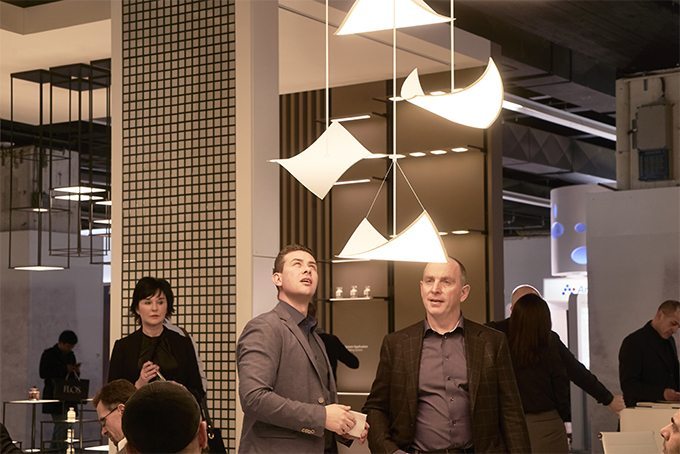
LGD is Showcasing it`s OLED Light products at Light+Building 2016(Source :LG Display)
LG Display announced today that it will invest in a new OLED light panel manufacturing facility.
The planned facility will be the first 5th generation (1000 x 1200mm) OLED light panel manufacturing plant in the world. It is to be located in the South Korean city of Gumi, where it will produce a range of OLED light panels. The initial input capacity at the plant will be 15,000 glass substrates per month.
The monthly input capacity could be gradually ramped up depending on the market situation. LG Display expects the increased production with the new facility to give the company economies-of-scale.
This will help the company obtain significant price competitiveness. In addition, the accumulated OLED display technical know-how will allow LG Display to considerably enhance OLED light product quality.
The 5th generation facility will give the company panel size flexibility. With the larger glass substrate, LG Display will be able to produce a wide range of different size light panels, including giant ones. Further, this ability to make giant panels will better enable the company to penetrate the general lighting market.
The investment decision follows the acquisition by LG Display of the OLED light business of its sister company, LG Chem in December, 2015. The plan for the new facility is in keeping with LG Display’s vision of bringing the exciting new OLED technology to customers around the world in the broadest array of applications.
The company will firstly focus on task lighting and decorative lighting in high-end retail stores and in luxury hospitality; and expand to the general lighting market going forward.
Also, the company will focus on automotive and convergence applications such as OLED light panels merged with furniture, architectural materials, electronic devices and more.
Mr. Young Kwon Song, Senior Vice President and Head of Strategy & Marketing Group at LG Display, said, “Our OLED light business will further strengthen LG Display’s commitment to nurture OLED as the future growth engine. Based on LG Display’s strong track-record and know-how in OLED display business, we will create synergy with the OLED light business and maintain our strong position in the overall OLED industry going forward.”
LG’s OLED light experience began in 2000 with R&D into OLED materials at the Group’s chemicals affiliate, LG Chem, with production of OLED light panels beginning in 2012.
The acquisition last year of the OLED light panel manufacturing business by LG Display has been creating synergies with its production infrastructure and technology in OLED displays.
It allows the company to save costs through integrated purchasing and shared investments, increase productivity by drawing on the accumulated knowledge of the display business, and help improve production infrastructure and use of technology patents.
OLED light is made up of layers of organic materials which is self-illuminating and consumes less power and also emits lower heat than conventional lighting.
It is environmentally friendly and is closest to natural light. Due to its ability to be thin and flexible, it is suitable for different applications and venues and could create new markets for lighting.
According to UBI Research, a market research firm, the OLED light market is expected to grow rapidly from US$ 135 million in 2016 to US$ 1.6 billion in 2020.
강현주 기자/OLEDNET

LG디스플레이의 플렉서블 OLED조명 구조물을 보고있는 부스 방문객 – 출처 :LG디스플레이
LG디스플레이(대표 부회장 한상범, 韓相範 /이하 LGD) 17일 경북 구미 공장에 5세대 조명용 OLED 신규라인 투자를 추진한다고 발표했다.
LGD가 투자를 추진하는 세계최초 5세대 조명용 OLED 라인은 월 1만 5,000장 규모로 세계 최대 생산규모가 될 예정이며 2017년 상반기중 양산에 들어갈 계획이다.
이번에 추진될 5세대 라인은 기판 규격이 가로 세로 1,000㎜×1,200㎜ 크기의 기존 생산량보다 30배 확대돼 규모의 경제를 통한 가격경쟁력 확보가 가능할 전망이다. 또 기존 구미지역의 노후화된 공장을 활용해 투자 효율성이 극대화될 것이라는 게 LGD의 설명이다.
이 회사는 지난해12월 OLED 사업 경쟁력을 강화하고 미래를 준비하기 위해 LG화학으로부터 OLED 조명 관련사업을 모두 이관 받고 차세대 OLED 조명사업 본격화를 선언한바 있다.
OLED 조명은 유기물의 자체 발광 특성을 활용, 기존 조명 대비 전력 소모와 발열이 적을 뿐 아니라 환경친화적이며 자연광에 가깝다. 투명과 플렉서블 구현으로 디자인에 대한 자유도가 높아 조명의 활용 폭을 극대화함으로써 다양한 분야의 시장 창출이 가능하다는 게 강점이다.
실제로 시장조사업체 유비산업리서치에 따르면 OLED 조명 시장은 2016년 1억 3500만 달러 규모에서 2020년에는 16억 달러로 성장할 것으로 전망된다.
이러한 OLED 조명의 미래가치를 발판으로 LGD는 그 동안 OLED 디스플레이 생산에서 축적한 기술력 및 생산능력을 내세워 OLED 조명과의 시너지를 창출, 선도적 시장 지위를 확보한다는 계획이다.
최근 차량 전장사업이 부각되고 있는 가운데, OLED조명은 차량용 디스플레이로서도 고부가가치를 창출할 것으로 전망된다.
LGD 전략/마케팅그룹장 송영권 전무는 “OLED 조명사업은 우리가 미래 성장 동력으로 집중 육성키로 한 OLED 사업 경쟁력을 강화하는 계기가 될 것”이라며, “그 동안 OLED 패널 생산에서 축적한 기술 노하우 및 생산능력을 기반으로 OLED 조명과의 시너지를 창출, 선도적 시장 지위를 확보하겠다”고 말했다.
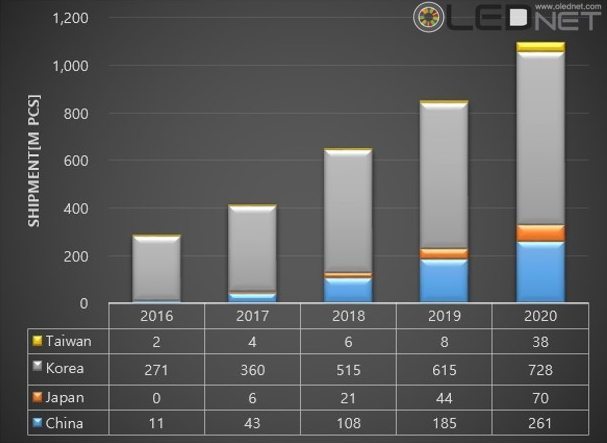
2016-2020 Global AMOLED Panel Market Shipment [1 Million] (source : UBI Research)
This year, Korea is expected to secure overwhelming leadership position within the global AMOLED panel market with 95% market share.
According to 2016 OLED Display Annual Report, recently published by UBI Research, approximately 270 million units of AMOLED panel are to be produced from Korea in 2016, approximately 95% of the global shipment.
For AMOLED panel market revenue, Korea is estimated to occupy 96% of the total market in 2016 with US$ 14,218 million. Korea is expected to maintain approximately over 70% of the market share until 2020, and lead the global market for several more years.
This is analyzed to be due to active response by Korean display companies against AMOLED application expansion by influential global smartphone companies.
Samsung Electronics is forecast to sell over 47 million units of AMOLED panel equipped Galaxy series in 2016. The projection that Apple will also apply AMOLED panel to future iPhone series for product differentiation is gaining traction.
Several companies, including LG Display and Samsung Display, are carrying out active investment for AMOLED panel mass production line from H1 2016.
Other than Korea, China is showing rapid movement within the global AMOLED market. China is estimated to produce approximately 11 million units of AMOLED panel in 2016, and occupy approximately 4% of the global shipment, marking the second place after Korea’s 95%. China is estimated to increase the market share each year and reduce the gap with Korea; in 2020, China is expected to hold 24% of global AMOLED panel shipment in 2020.
China’s AMOLED panel market revenue is also forecast to show significant growth with approximately US$ 500 million in 2016 to US$ 13,700 million in 2020, a 20% of the total market.
2016 OLED Display Annual Report forecasts that the global AMOLED market is to record approximately US$ 15,000 million in 2016, and grow to approximately US$ 70,000 million in 2020.

2016년~2020년 AMOLED 시장 출하량(출처:유비산업리서치 2016 OLED Display Annual Report)
올해 전세계 AMOLED 패널 시장은 한국이 95%의 점유율을 차지하며 압도적인 주도권을 확보할 전망이다.
유비산업리서치에서 최근 발간한 ‘2016 OLED Display Annual Report’에 따르면 2016년 한국에서 생산될 AMOLED 패널의 양은 약 2억7천만개로 전세계 출하량의 약 95%를 차지할 것으로 예상된다.
AMOLED 패널 시장 매출액 역시 한국이 2016년 미화 142억1800만달러로 전체시장의 96%를 차지할 전망이며 오는 2020년까지 약 70% 이상의 시장 점유율을 유지, 향후 수년 이상 세계 시장 주도권을 쥘 것으로 보인다.
이는 글로벌 유력 스마트폰 업체들의 AMOLED 적용 확대에 대해 국내 디스플레이 업계가 적극 대응하고 있기 때문인 것으로 분석된다.
삼성전자는 2016년 AMOLED 패널이 적용된 갤럭시 시리즈를 4,700만대 이상 판매할 것으로 전망된다. 애플 역시 제품 차별화를 위해 향후 아이폰 시리즈에 AMOLED 패널을 적용할 것이라는 예상이 우세한 상황이다.
LG디스플레이, 삼성디스플레이 등은 이 같은 수요에 대비하기 위해 2016년 1분기부터 AMOLED 패널 양산 라인 투자에 본격적으로 나서고 있다.
한국을 제외하고 전세계 AMOLED 시장에서 가장 빠른 행보를 보이는 국가는 중국이다. 중국은 2016년 AMOLED 패널을 약 1,100만개 생산, 전세계 출하량의 약 4%를 차지할 전망이며 95%인 한국에 이어 2위에 오를 전망이다. 중국은 매해 점유율을 늘려가며 오는 2020년에는 전세계 AMOLED 패널 출하량의 24%를 차지, 한국과의 격차를 줄여나갈 것으로 보인다.
중국의 AMOLED 패널 시장 매출액도 2016년 미화 약 5억달러에서 2020년 137억달러로 20%의 글로벌 점유율을 차지하며 큰 폭의 성장세를 그릴 것으로 예상된다.
한편 유비산업리서치의 본 보고서에 따르면 2016년 글로벌 AMOLED 시장은 미화 약 150억달러 규모를 형성하고 오는 2020년에는 약 700억달러 규모로 성장할 전망이다.
Hyun Joo Kang, Editor, OLEDNET
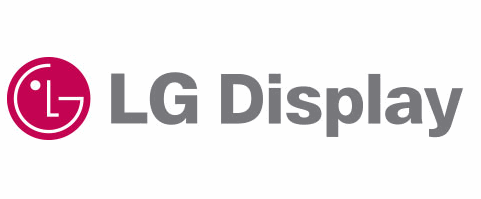
LG Display announced today that it is showcasing its latest advanced OLED light products and solutions at Light+Building 2016, one of the leading global trade fairs for lighting and building services technology, in Frankfurt, Germany, from March 13th to 18th.
Eleven OLED light panels are being exhibited along with four solutions using the panels. LG Display is highlighting the key advantages of OLED light, including the design flexibility that makes it suitable for different applications and venues, as well as its supreme light quality which is closest to natural light, thereby making people feel comfortable and reducing eye fatigue.
The company is exhibiting four solutions using OLED light panels:
Flexible Solution Section
The flexible OLEDs can be used to create unique and creative decorative lighting fixtures. The creativity in design increases along with the length of the panels. The flexible OLED light panels are light-weight and unshatterable. There are applications using 200x50mm flexible panels and 406x50mm flexible panels. The main highlight in this section is an application using many 320x320mm flexible panels.
Transparent Connection Solution Section
The LG Display OLED light panel generates a floating light effect by attaching the panel to glass and providing power through metal mesh transparent conductive film. It can be applied to display cabinets, shelves, and furniture. Especially when it is applied to shelves at stores, the lack of heat preserves product quality while the lack of shadow makes them more visually appealing to customers. The simplicity of OLEDs opens up the possibilities of various designs and applications.
Mirror Solution Section
By embedding the OLEDs into mirrors, LG Display has created a solution that can have a variety of uses. It can be used as a mirror in upscale hospitality settings or as a unique display box in high-end retail stores. When other light sources are used in a mirror solution, they tend to make the mirror too thick whereas OLED keeps the mirror thin and also minimizes glare.
Module Solution Section
OLED light panels allow for easy installation in diverse settings. LG Display is introducing super-slim OLED light modules at the fair with a simple aluminum housing that connects multiple panels into each module, generating unique and sleek designs. The company is showcasing the module solutions in order to demonstrate how well OLED light can be applied to interior design and architecture. It is committed to develop other solutions in order to encourage more and more people to easily use OLED lights.
강현주 기자/OLEDNET

LG디스플레이(대표이사 부회장 한상범, 韓相範 / www.lgdisplay.com)가 3월 13일부터 18일까지(현지시간) 독일 프랑크프루트에서 열리는 ‘조명 및 건축 박람회 2016 (Light + Building 2016)’에서 미래형 OLED 조명 제품과 기술을 선보인다.
LG디스플레이는 디자인을 자유롭게 구현할 수 있고 자연광에 가까운 품질을 갖춘 프리미엄 제품인 OLED 조명의 다양한 미래형 제품을 선보일 계획이다.
이번 박람회에서 LG디스플레이는 플렉서블, 투명선반형, 거울형, 모듈형의 4가지 솔루션으로 구현된 다양한 OLED 조명을 통해 차별화된 기술력을 과시하고, 신개념 광원인 OLED 조명의 신세계를 보여줄 예정이다.
플렉서블 OLED 조명은 곡면 구현이 가능해 조명을 활용한 인테리어의 가능성을 확장할 수 있을 뿐만 아니라 얇고 가벼워 다양한 디자인을 연출할 수 있다.
투명선반형 OLED 조명은 투명전극을 활용해 광원이 마치 유리선반위에 떠 있는 형태로 연출할 수 있게 특징이다. 특히 거울형 OLED조명은 거울 두께를 지나치게 두껍게 만드는 다른 조명과 달리, 거울의 두께 그대로 유지해 얇고 눈부심이 없는 조명을 만들 수 있다.
모듈형 OLED 조명은 OLED 고유의 얇고 가벼운 특성을 최대한 활용, 설치와 조립을 쉽게 만들어 조명끼리 결합할 수 있기 때문에 조명의 활용도를 무한으로 확장할 수 있는 제품이다.
LG디스플레이 OLED 조명사업담당 박성수 상무는 “OLED 조명은 전력 소모와 발열이 적어 환경친화적이며 자연광에 가까워 눈의 피로도가 최소화된 프리미엄 조명”이라며, “플렉서블 패널과 같은 신개념 제품으로 OLED 조명의 응용영역을 확대해 더 많은 고객들이 OLED 조명만이 가져다 주는 혁신적 미래를 체험할 수 있도록 할 것”이라고 말했다.
한편 2년마다 개최되는 ‘조명 및 건축 박람회’는 전 세계 50개국에서 조명, 건축과 관련 2300여개사, 20만명이 참가해 조명, 전기 엔지니어링, 주택 및 건물 자동화, 건축 관련 소프트웨어 등을 선보이는 세계 최대 규모의 조명 행사다.
Sumitomo Chemical will exhibit its polymer OLED lighting at “Light+Building 2016,” one of the world’s largest trade fairs for lighting and building technology, to be held in Frankfurt, Germany, from March 13 to March 18, 2016.
This is the third time for Sumitomo Chemical to exhibit its products at the trade fair, following its previous participation in 2014. Sumitomo Chemical will run a booth at the trade fair, inviting the world-renowned Japanese lighting designer Motoko Ishii as the art director for the exhibit.
Sumitomo Chemical’s exhibit, named “OLED JARDIN,” symbolises a “Garden in the Sky” as formed from polymer OLED lighting panels, creating an approachable space of a vast expanse with a taste of Japanese grace added.
In addition to “OLED JARDIN,” Sumitomo Chemical will exhibit its newly-designed OLED panels, improved for brightness and luminance efficiency from those displayed in the previous trade fair. The new polymer OLED panels, available in a range of colors, shapes and sizes, provide a greater degree of flexibility in the design for various spaces and applications.
Following the exhibit at “Light+Building 2016,” Sumitomo Chemical will start the sales of its new product line-up consisting of polymer OLED lighting panels in April this year, aiming to further expand its OLED lighting business.
Sumitomo Chemical은 독일 프랑크푸르트에서 3월 13일부터 18일까지 열리는 세계 최대 수준의 조명산업 무역 박람회 “Light+Building 2016”에서 고분자 OLED 조명을 전시할 예정에 있다.
이번 공개는 Sumitomo Chemical의 세 번째 무역박람회 전시로, 가장 최근에는 2014년에 전시한 바 있다. Sumitomo Chemical의 이번 전시 부스는 세계적으로 유명한 일본인 조명디자이너인 Motoko Ishii가 아트디렉터를 맡아 꾸밀 예정이다.
이번 Sumitomo Chemical의 전시는 하늘 속의 정원을 상징하는 “OLED JARDIN”라는 이름으로 고분자 OLED 조명 panel들을 사용해 공개될 예정이다. 넓으면서도 친근한 공간 내에 일본풍의 우아함을 강조한 컨셉이다.
“OLED JARDIN”에서 Sumitomo Chemical은 이전 무역박람회에서 전시된 패널보다 밝기와 발광효율이 향상된 OLED 패널을 전시할 예정이다. 해당 고분자 OLED 패널은 색과 모양, 크기를 변화시킬 수 있으며 높은 유연성을 가지기 때문에 다양한 공간과 어플리케이션에 적용될 수 있을 것으로 전망된다.
Light+Building 2016 전시에 뒤이어, Sumitomo Chemical은 고분자 OLED 조명 패널로 이루어진 새로운 제품 라인업을 이번 년도 4월에 판매할 예정이다.
During the 2nd OLED Korea Conference, the Germany-based CYNORA has presented its current status in blue TADF-based OLED-emitter development.
CYNORA focuses on materials that are able to convert triplet excitons into light via Thermally Activated Delayed Fluorescence (TADF). While efficient emitters for red and green are already commercially available from other suppliers, there is still no blue OLED material available to match the strong demand for the industry. TADF technology is a promising candidate for highly efficient and stable blue emitter systems. TADF-based emitters offer up to four times better efficiency than currently used materials, which are based on fluorescence.
CYNORA has shown its current TADF-materials for sampling with good color points in blue (CIE 0.16, 0.17) and sky-blue (CIE 0.19, 0.36). The presented materials confirm that blue emission and high efficiency can be combined. CYNORA is focusing its current material development on vacuum-processing following the customer request, as represented in large investments into this deposition technology by the major AMOLED displays makers.
In order to provide more sample materials to customers, while reducing the cycle times for material improvements, CYNORA is growing its infrastructure. The company is extending the device testing capacity by setting up a new cluster tool and hiring continuous experts for the synthesis and device department. Due these actions CYNORA’s emitter throughput will increase significantly.
The strong interest from the OLED industry in TADF-based blue emitters systems has been once more confirmed at this UBI event and allowed CYNORA to further extend its network with the Korean OLED community. The present expansion of CYNORA management operations, consistently sampling and improvement of blue OLED materials are further strengthening the position of CYNORA as a technology leader in the field of TADF emitter systems.
제 2회 OLED Korea Conference에서 독일 소재의 재료 업체인 CYNORA는 현재 blue TADF-based OLED-emitter를 개발하고 있다고 밝혔다.
CYNORA는 Thermally Activated Delayed Fluorescence (TADF)을 통해 triplet exciton이 빛으로 변환되는 원리의 발광물질 개발에 집중하고 있다고 발표하였다.
현재 Red와 green 색을 내는 고효율 발광물질은 이미 상업적으로 공급이 되고 있는 반면에, Blue 발광물질은 아직 상업적으로 요구되는 높은 성능에 도달하지 못하고 있다.
TADF 기술은 높은 효율을 가지면서도 안정적이라는 장점이 있어 blue 발광 시스템에 적용되어 전도유망하게 쓰일 수 있을 것으로 전망된다. TADF는 형광을 기반으로 하는 발광기술로 이를 이용한 발광물질은 기존에 사용되는 물질과 비교했을 때 4배까지 향상된 효율을 보여준다.
CYNORA는 blue (CIE 0.16, 0.17)와 sky-blue (CIE 0.19, 0.36)에서 좋은 색좌표를 가진 TADF 발광물질을 샘플용으로 공개했다. 공개된 물질은 blue색을 발광하면서 높은 효율을 가진 것으로 나타났으며, 주요 OLED 패널업체에서 진행하는 대규모 진공공정 라인 투자 라인에 적용될 수 있을 것으로 기대된다고 밝혔다.
또한 CYNORA는 “더 많은 샘플 물질을 고객들에게 제공하기 위해 관련 인프라를 성장시키고 물질 개발에 대한 cycle time을 줄이려는 노력을 하고 있으며, 새로운 cluster 도구와 관련 전문가들을 고용해서 device 테스트에 대한 생산량을 높이고 있다.”라며, “이런 움직임을 통해 CYNORA의 발광물질 생산력은 비약적으로 향상될 것으로 전망된다.” 라고 발표하였다.
이번 유비산업리서치의 OLED Korea Conference를 통해 TADF기반의 blue 형광물질에 대한 OLED 산업계 내의 높은 관심이 입증되었다. CYNORA는 꾸준한R&D 투자와 샘플링을 통해 당분간 TADF기반의 blue 형광물질에 대한 기술 발전이 앞으로도 지속될 것으로 전망된다.
At the 2nd OLED KOREA Conference (Feb 24 – 25), Juergen Kreis, Director of Business Development of AIXTRON, gave a presentation titled ‘Cost-efficient OLED’ and discussed AIXTRON’s evaporation process technology.
AIXTRON, an evaporation manufacturing equipment production company, bought Plasma Si situated in Silicon Valley in April 2015 to develop encapsulation technology. During the presentation, Kreis focused on organic layer evaporation technology OVPD, OPTACAP, and PVPD, a polymer thin film evaporation technology.
OVPD technology deposits the materials above the substrate using the shower head corresponding to the substrate area. Kreis revealed that OVPD technology allows for the optimized evaporation and can increase the material usage efficiency and productivity.
Regarding OPTACAP, Kreis emphasized that this is an encapsulation technology that forms multilayer thin film of high flexibility with low stress and cost. AIXTRON had previously announced that they are expecting to supply to a key Asian panel company in Q1 2016.
Kreis reported that PVPD is a technology that allows for the advantages of polymer materials and CVD process. He also added AIXTRON is currently continuing to research similar process technology with low process cost and high efficiency.
24일부터 25일까지 서울 양재 The K 호텔에서 열리는 제2회 OLED Korea Conference에서 AIXTRON의 Juergen Kreis 디렉터는 ‘Cost-efficient OLED’라는 제목의 발표를 통해 AIXTRON이 보유한 증착공정기술에 대하여 전반적으로 이해할 수 있는 시간을 가졌다.
증착장비 생산 기업인 AIXTRON은 encapsulation 기술을 개발하기 위해 2015년 4월, 실리콘밸리에 위치되어있는 회사인 Plasma Si를 인수해 화제를 모은 바 있다. 이 날 Kreis 디렉터는 유기층 증착기술인 OVPD와 OPTACAP, 고분자 박막 증착 기술인 PVPD를 중심으로 발표를 진행했다.
OVPD기술은 기판의 면적에 대응하는 shower head를 이용하여 기판위에 하향식으로 증착 하는 기술로 Kreis 디렉터는 AXITRON은 OVPD기술을 통해 최적화된 증착을 할 수 있어 재료 사용 효율과 생산성을 높일 수 있다라고 밝혔다.
그리고 OPTACAP에 대해서는 “낮은 stress와 cost로 높은 flexibility를 가진 다층 박막을 생성하는 encapsulation 기술이다”라고 강조하며, 2016년 1분기에 아시아 주요 panel 업체에 출하할 예정이라고 밝힌 바 있다.
PVPD에 대해서 Kreis 디렉터는 증착할 때 나타나는 고분자 물질의 장점과 CVD 공정의 장점이 모두 나타나는 공정 방식이라고 밝히며 현재 AIXTRON은 이와 같은 낮은 공정비용과 높은 효율의 공정기술을 지속적으로 연구 중에 있다고 강조했다.
On February 24, Dr. Xiuqi Huang, Visionox’s general manager, gave a keynote speech at the 2nd OLED KOREA Conference (Feb 24-25). With the presentation title of Development of AMOLED Display: From Rigid to Flexible, Dr. Huang discussed how the flexible display was introduced and its future.
Flexible display is expected to solve CRT’s heavy weight, and FPD’s design limitation. Key issues include thin film formation process, structure that can withstand bending, and materials with high tensile strength. Dr. Huang emphasized that OLED is a display that can solve all 3 issues.
In order for flexible OLED to make the leap, Dr. Huang announced that 7 technological developments need to be carried out: encapsulation, TFT backplane, array design, flexible technology, flexible substrate, stress management, and module integration.
Visionox first developed flexible OLED in 2001, and revealed 5.2 inch flexible AMOLED of rollable type with 3 mm curvature radius and 20 um thickness in July 2015. They are aiming for mass production within 2 years.
Regarding OLED mass production, Dr. Huang revealed that the Gen 5.5 AMOLED mass production line phase1 4K will be increased to 15K until 2016, and Gen 6 AMOLED mass production line is expected to be in operation in 30K volume in 2017.
In the 2nd OLED KOREA Conference (Feb 24-25), Won-Gyun Youn, LG Display’s head of OLED TV Product Planning Team, gave a keynote speech. Through the presentation, he emphasized the importance of display’s design and performance and discussed why OLED will become important in next generation display.
Youn told the attendees that in the last few years, display performance issues, such as 3D, UHD, and HDR, and design issues, such as curved and super slim, arose together. Emphasizing these issues, Youn revealed that OLED is the display that can solve both. He added that in terms of performance, OLED can actualize perfect black and colors, cleanly express movement, and has wide viewing angle. In terms of design, OLED is thin and flexible, and can produce diverse shapes and be transparent.
LG Electronics and LG Display recently installed ultra large OLED signage OLED Moment in 2 places inside Incheon International Airport. They also presented OLED sculptures in various shapes such as tunnel, waves, cylinder, and others using 250 units of 55 inch OLED panels at N Seoul Tower. The 2 companies are carrying out aggressive marketing promoting OLED. Regarding OLED’s future, in short term, form factor changes are expected to occur following design change, and in mid-to-long term, the paradigm will shift with the introduction of rollable and transparent display.
Youn revealed that at present OLED has to resolve the expansion of the market and infrastructure, and improvement of productivity and technology. In order to solve this, research in improving the TFT mobility by more than 50%, and increasing the efficiency and lifetime is being carried out. He also added that they are researching ink-jet process, manufacturing equipment, and materials to develop soluble process.
Insun Hwang, Samsung Display’s principal engineer of the Frontier Technology Team, announced that as the display market is expanding, the key factor for positive outlook for future display is ‘design freedom’.
At the 2nd OLED KOREA Conference (Feb 24-25) hosted by UBI Research, Hwang gave a keynote presentation.
During the presentation, Hwang announced that the mobile overtook TV as the medium that people use to access daily media. According to the presentation materials, the mobile usage is increasing each year, while the TV usage is decreasing. Also as the mobile usage of people under 50 is higher than that of TV, Hwang forecast that the number of people using mobile to access information will increase. He added that if the display panel price falls down, the number of the display panels will become higher than the number of users and forecast positive future for the display market.
Hwang particularly mentioned that AMOLED applied products will increase as it emits less harmful blue light and is human friendly, giving smartwatch and VR as the current examples. He estimated that the smartwatch market can expand through differentiated strategy with new functions and designs. Additionally, as an issue that needs to be solved, he mentioned that the resolution of VR falls as the distance between the user and display is short. High resolution is the key in VR, and Hwang explained that approximately 2,000 ppi is required for suitable realism. He also forecast that the automotive display will lead the display field and the future market. He further explained that as OLED can actualize the curvature and transparency, it is appropriate for automotive display.
However, Hwang also mentioned OLED’s lack in technology. Pointing out that technology for plastic window, flexible touch, encapsulation, and backplane falls short of what the market requires for flexible display and design freedom, Hwang described the need for OLED technology development.
Hwang estimated many flexible display equipped smart products in future, and concluded that display’s design freedom will be the most important issue.
Choong Hoon Yi, the president of UBI Research, discussed the trend change of CES 2016 and the effects on future OLED display and market forecast.
During the 2nd OLED KOREA Conference (Feb 24 – 25), Yi gave a key note presentation titled ‘Dynamic Change in OLED Industry’.
Discussing CES 2016, Yi first gave VR and drones as display related hot issues. However, he defined the 2 products as items that bring enjoyment to the users rather than products that are necessary in everyday life. Yi estimated that the market is expected to grow but with some limitation.
The second issue Yi gave was automotive display which he forecast significant growth as dashboard attachment from the exhibitions by automotive and related companies that became more prominent since the last CES. Volkswagen particularly drew attention with IoT function attached dashboard display that can control electronic appliances at home. Additionally, Hyundai Mobis and Denso embedded display for side mirror use on the dashboard.
Yi reported that in CES, for TV section which is the most important home appliances, LG Electronics’ OLED TV decidedly stood out. At CES 2016, LG Electronics impressed the viewers by actualizing the blackness of the space and fiery sun filmed by NASA. Samsung Electronics exhibited existing SUHD TV with quantum dot display. Japanese companies such as Panasonic and Sony presented LCD panel applied TV.
Additionally, Yi told the attendees that Samsung’s transparent OLED using Galaxy Gear promotion and LG’s dual-view curved tiling OLED promotion of various home appliances were impressive. He added that these exhibitions were only possible by companies currently producing OLED. Forecasting that OLED market will exceed 1,000 million units of shipment in 2020 and mentioning investment forecast following this, Yi concluded his presentation.
24일 서울 양재 The K 호텔에서 열린 제2회 OLED Korea Conference의 키노트에서 Visionox의 Xiuqi Huang 박사는 “Development of AMOLED Display: From Rigid to Flexible”라는 제목의 발표를 통해 플렉시블 디스플레이가 등장한 요인과 앞으로의 전망을 밝혔다.
플렉시블 디스플레이는 CRT의 무거움과 FPD의 디자인의 경직성을 모두 해결할 수 있을 것으로 기대되고 있는 디스플레이로, 핵심적인 이슈로는 박막을 형성하는 공정과 구부릴 때 변형을 견디는 구조, 높은 인장강도를 가진 물질을 사용하는 것들이 있다. Huang 박사는 “OLED는 이러한 3가지 이슈를 모두 해결할 수 있는 디스플레이이다.”라고 강조했다.
Huang 박사는 플렉시블 OLED가 더 높은 수준으로 도약하기 위해서는 encapsulation와 TFT backplane, array design, 유연성 기술, 유연기판, stress management, module integration 등 7가지 기술적인 개발이 필요하다고 발표했다.
Visionox는 2001년 첫 플렉시블 OLED를 개발한 이후 작년 7월에는 3mm의 곡률반경과 20um의 두께를 가진 rollable type의 5.2인치 flexible AMOLED을 공개하며 2년내 양산을 목표로 하고 있다고 밝힌 바 있다.
OLED 양산과 관련해 Huang 박사는 구체적으로 2016년까지 Gen.5.5 AMOLED 양산라인을 phase1 4K를 총 15K 규모로 증설할 계획이며, 2017년에는 Gen.6 AMOLED 양산라인을 30K 규모로 가동할 계획을 가지고 있다고 밝혔다.
2월 24일 개최한 제 2회 OLED Korea Conference에서 LG디스플레이의 윤원균 팀장은 “‘OLED’ The Next Display”라는 제목의 키노트 발표를 통해 디스플레이의 디자인과 성능에 대한 중요성을 강조하고 왜 차기 디스플레이에 OLED가 중요하게 될 것인지에 대해 발표했다.
윤 팀장은 최근 몇 년간 3D와 UHD, HDR과 같은 디스플레이의 성능에 대한 이슈와 curved, super slim과 같은 디자인에 대한 이슈가 함께 떠올랐다고 강조하며 OLED는 두 가지 이슈를 모두 만족하는 디스플레이라고 밝혔다.
또한 “디스플레이의 성능 측면에서 OLED는 완벽한 black과 완벽한 색감을 표현할 수 있으며 대상의 움직임을 깨끗하게 표현할 수 있고 넓은 시야각을 가지고 있다.”고 밝히며 “디자인 측면에서 OLED는 얇고 유연하며 다양한 모양을 내고 투명하게 만들 수 있다.”고 발표했다.
최근 LG 전자와 LG 디스플레이는 인천공항 두 곳에 각각 초대형 OLED 사이니지인 ‘OLED Moment’를 설치하고 남산 N서울타워에 55인치 OLED 패널 250장을 사용한 터널형, 물결형, 원통형 등의 조형물을 공개하는 등 OLED 알리기를 전면에 내세우는 공격적인 마케팅을 펼치고 있다. 윤 팀장은 OLED의 미래에 대해 “단기적으로는 디자인과 그에 따른 form factor의 변화가 있을 예정이며 중장기적으로는 rollable과 투명 디스플레이 등이 등장하며 패러다임이 바뀔 것으로 전망된다.”고 밝혔다.
윤 팀장은 “현재 OLED는 시장과 인프라 확대와 생산성 향상, 기술 향상이라는 숙제들이 있다.”고 밝히며 “이를 해결하기 위해 TFT의 mobility를 50이상으로 향상시키고 효율과 수명 또한 증가시키려는 연구를 하고 있다”고 강조했다. 또한, Soluble 공정을 개발하기 위해 ink-jet 공정과 장비, 재료들을 연구하고 있다고 발표했다.
Samsung Display의 황인선 수석연구원이 앞으로의 디스플레이 시장이 더 커지면서 긍정적인 전망과 미래의 디스플레이가 가져야 할 키팩터는 ‘디자인 프리덤’이라고 발표했다.
황인선 수석연구원은 지난 24일부터 이틀 간 유비산업리서치가 개최한 ‘The 2nd OLED Korea Conference’에서 키노트 발표를 했다.
황인선 수석연구원은 개인이 매일 미디어를 접하는 비중이 2015년에 모바일이 TV를 앞섰다고 발표했다. 발표 자료에 따르면, 매년 모바일의 사용 비중이 높아지는 추세를 보이고 있고, TV는 하락하는 모양을 하고 있다. 또한 10대와 20대, 30대, 40대까지는 TV보다 모바일을 사용하는 비율이 높아서 앞으로 정보를 모바일로 접하는 사람이 많아질 것으로 예상했다. 황 수석은 ‘디스플레이 패널의 가격이 떨어지면 디스플레이가 사람 수에 비해 사용되는 패널의 수가 많아질 것’이라고 말하며 디스플레이 시장을 긍정적으로 바라보고 있다고 덧붙였다.
특히 황 수석은 AMOLED가 유해성 블루라이트가 적어 인간 친화적이기 때문에 앞으로 적용된 제품들이 늘어날 것이며, 새로운 어플리케이션을 만들어 낼 수 있다고 발표했다. 현재 적용되고 있는 제품으로 스마트워치와 VR을 예로 들었다. 스마트워치는 시계와 다른 차별화된 전략으로 새로운 기능을 탑재하고 새로운 디자인을 통해 시장이 확대될 수 있을 거라고 말했다. 또한 VR은 디스플레이를 접하는 거리가 가깝기 때문에 해상도가 떨어진다는 점을 해결해야할 과제로 꼽았다. 황인선 수석은 ‘VR은 고해상도가 핵심이며, 약 2000ppi 정도 되어야 현장감을 잘 느낄 수 있을 것’이라고 덧붙였다. 추가로 황인선 수석은 ‘차량용 디스플레이가 디스플레이 전장을 이끌 것’이라며 차량용 디스플레이가 미래의 시장을 선도할 것으로 전망했다. 황 연구원은 OLED가 곡면과 투명이 가능하여 차량용 디스플레이로 적합하다고 말했다.
하지만 OLED의 기술적인 부분이 미흡하다는 점을 언급했다. 특히 플렉서블 디스플레이, 즉 디자인 프리덤을 위해서 ‘플라스틱 윈도우, 플렉서블 터치, encapsulation, 백플레인 기술이 아직 시장에서 요구할 만한 수준이 아니다’라고 말하며 OLED 기술 개발의 필요성에 대해 이야기 했다.
황인선 수석은 ‘미래는 플렉서블 디스플레이를 탑재하고 스마트라는 단어를 입은 제품들이 많이 나올 것이며, 이를 위해서 디스플레이의 디자인 프리덤이 가장 중요할 것’이라고 말하며 키노트 발표를 마쳤다.
유비산업리서치의 이충훈 대표가 CES 2016의 트렌드 변화가 앞으로의 OLED 디스플레이에 미치는 영향과 시장 전망에 대해 발표하였다.
지난 24일부터 이틀간 열린 ‘The 2nd OLED Korea Conference’에서 유비산업리서치의 이충훈 대표가 ‘Dynamic Change in OLED Industry’라는 제목으로 키노트 발표를 했다.
이충훈 대표는 CES 2016에서 볼 수 있었던 디스플레이 관련 핫이슈로 VR과 드론을 가장 먼저 꼽았다. 하지만 VR과 드론의 경우, 생활에 필수적으로 필요한 제품이기 보다는 사용자 개인의 즐거움을 주는 도구로 정의했다. 이 대표는 ‘따라서 시장은 성장할 것으로 예상되나 한정적일 것으로 예상된다’고 말했다.
두번째 이슈로 꼽은 차량용 디스플레이는 대시보드에 장착되면서 큰 성장을 이룰 것으로 전망했다. 지난 CES부터 부각된 자동차 업체와 관련 기업들의 전시로 유추해 낸 결론이다. 특히 폭스바겐은 대시보드에 장착된 디스플레이로 집에 있는 가전제품들을 컨트롤 할 수 있는 IoT 기능을 탑재해 눈길을 끌었다. 또한 현대모비스와 덴소에서는 사이드 미러용 디스플레이를 대시보드에 내장 시킨 디스플레이를 전시했었다.
CES에서 매년 가장 주요한 가전인 TV에서 LG전자의 OLED TV가 단연 돋보였다고 발표했다. LG전자는 CES 2016 전시 중 NASA에서 촬영한 우주 공간 속의 black과 태양의 홍염을 완벽하게 묘사하면서 보는 이들의 감탄을 자아냈다. 삼성전자는 기존 SUHD TV에 퀀텀닷 디스플레이를 적용하여 전시하였다. 파나소닉과 소니 등의 일본 업체들도 LCD 패널을 적용한 TV를 선보였다.
또한 이충훈 대표는 삼성의 투명 OLED를 이용한 갤럭시 기어 홍보와 LG의 OLED 패널을 붙인 듀얼뷰 커브드 tiling OLED로 각종 가전제품을 홍보한 부분이 인상적이라고 발표했다. ‘현재 OLED를 생산하고 있는 삼성과 LG만이 누릴 수 있고 표현할 수 있는 전시였다’고 덧붙였다.
추가로 이 대표는 앞으로의 OLED 시장이 2020년 출하량 기준 10억개를 돌파할 것으로 전망하며, 이에 따른 투자 전망에 대해 언급하며 발표를 마쳤다.
A surge of AMOLED panels by Chinese set companies is starting. Chinese set companies exhibited many AMOLED panel applied products in MWC 2016 (Feb 22 – 25), forecasting that the demand for AMOLED panel could greatly increase.
6 companies, including Huawei, ZTE, LENOVO, and Gionee, exhibited AMOLED panel applied smartphones. Particularly, Hisense and KONKA, well known as TV set companies, presented AMOLED panel smartphones and the Chinese set companies’ increased interest in AMOLED panel could be confirmed.
The majority of the AMOLED panel smartphones exhibited by Chinese set companies had 5 inch level panel with HD and FHD level resolution, and analyzed to have been supplied by Samsung Display.
Samsung Display is known to have significant amount of mainstream AMOLED panels to Chinese set companies in 2015. Following this trend, over 100 million units of AMOLED panels are expected to head toward China in 2016.
The key points are Samsung Display’s rigid AMOLED panel production capa. and whether the Chinese AMOLED panel companies can carry out mass production. The current Samsung Display’s rigid AMOLED panel mass production capa. is estimated to be insufficient to meet the demands for Samsung Electronics’ mainstream Galaxy model and Chinese set companies. Chinese panel companies have also announced active mass production from the first half of this year.
From the significant occupation of Chinese set companies that applied AMOLED panel within the Chinese smartphone market, panel companies’ supply ability of AMOLED panel for Chinese set companies is expected to be one of the issues in 2016.
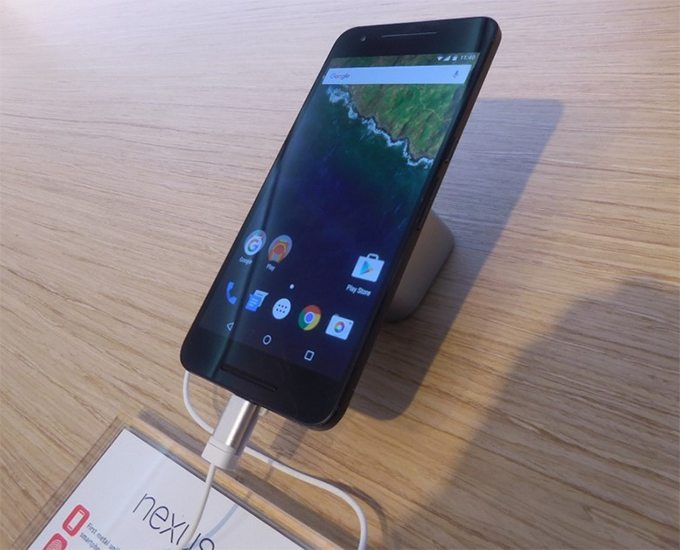
Huawei’s Nexus 6P
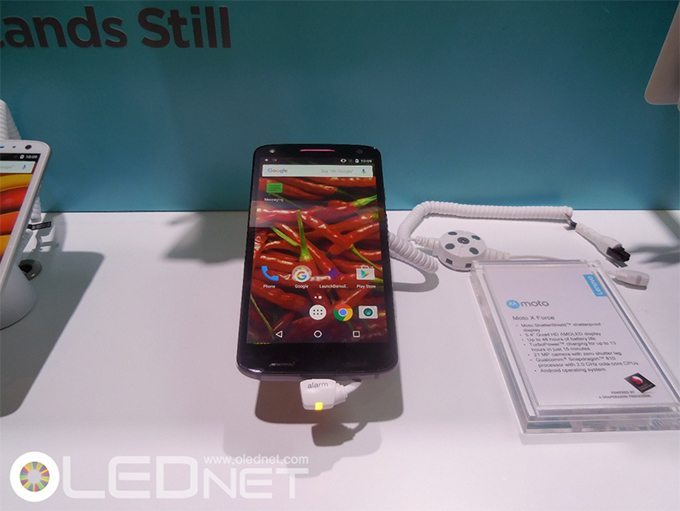
LENOVO’s Moto X Force
In MWC 2016 (Feb 27 – Mar 2), Tianma, a Chinese AMOLED panel company, revealed 5.46 inch flexible AMOLED panel for the first time. This panel has HD resolution (720 x 1280) with the curvature radius of 20 mm. Additionally, Tinama also exhibited 5.5 inch and 5 inch FHD AMOLED panel, and 5 inch HD AMOLED panel.
Tianma added that the 5 inch HD AMOLED panel is expected to be actively mass produced in the first half of this year and it is being produced in smaller quantity and that additional investment will soon be carried out for Gen5.5.
Tianma is currently carrying out small volume of mass production using Ulvac Gen4.5 manufacturing equipment. Although Tianma continued presenting their products in display related exhibitions, it is their first time in a set exhibition such as MWC. This activity is analyzed to be a part of Tianma’s effort to further their client base before active AMOLED panel mass production.
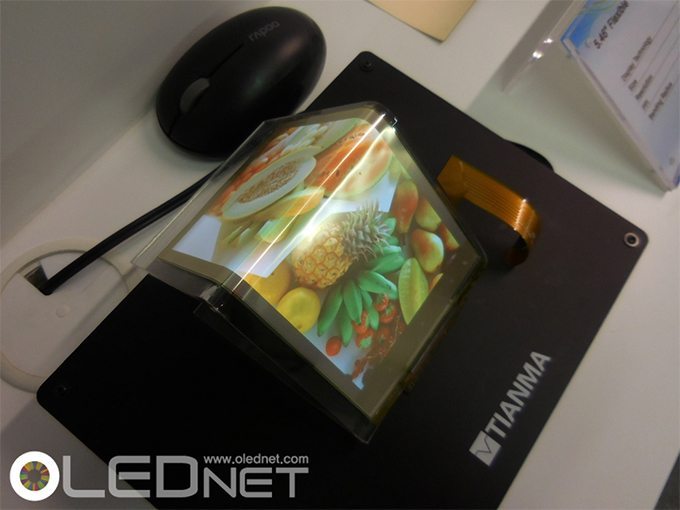
Tianma’s5.46 inch Flexible AMOLED Panel
디스플레이 시장의 강자로 군림하던 LCD가 mobile 기기용 display시장에서 AMOLED로의 전환이 빠르게 이루어지고 있다.
MWC 2016에서 AMOLED panel이 적용된 제품을 전시한 업체는 Samsung Display와 화웨이등 총 11개 업체로 MWC 2015에 비해 2배 증가하였으며 제품 수는 25개로 전년도에 비해 2배 이상 증가하였다.
작년 MWC 2015에서는 전시된 10개 제품 중 삼성전자에서 전시한 제품이 6종이었지만 올해는 삼성전자에서 신규로 전시한 제품이 3종으로 삼성전자를 제외하고 계산한다면 MWC 2016에 전시된 AMOLED panel이 적용된 set수는 전년도에 비해 4배가 상승한 수치이다.
이처럼 빠른 속도로 LCD에서 AMOLED 로의 전환이 진행되고 있는 이유로는 set업체들의 AMOLED에 대한 장점 인지도가 커져가고 있음과 동시에 AMOLED panel의 가격이 장비의 감가상각이 끝나감에 따라 LCD와 동등한 가격대로 내려갔기 때문인 것으로 분석된다.
또한 Lenovo와 화웨이에서는 QHD, WQHD 해상도의 하이엔드 model에 적용되는 AMOLED panel을 적용한 제품도 공개하며 보급형뿐만 아니라 하이엔드 제품에도 AMOLED panel에 대한 수요가 커질 것으로 예상된다.
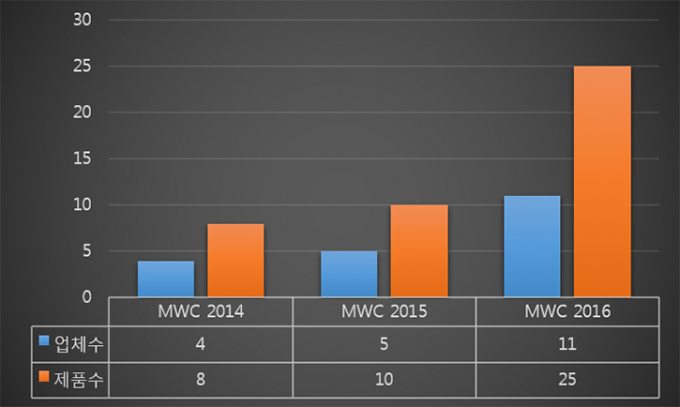
On February 21 (local time), Samsung Electronics held Samsung Galaxy Unpack 2016 event at the Barcelona International Convention Center (CCIB), Spain, and unveiled smartphone Galaxy S7, Galaxy S7 Edge, and Gear 360, a camera that can film in 360°.
Koh Dongjin, Samsung Electronics Mobile Communications Business president, announced that at this important time of change in the mobile industry, Samsung Electronics will provide not only smartphone but also the comprehensive experience and value for the consumers through diverse products, contents, and service surrounding the smartphone. He added that the company will pay even more attention to the consumers in future and lead the mobile market through ceaseless challenges in new technology and areas.
4 items were much emphasized in Galaxy S7 and S7 Edge. Firstly, for the camera, the latest technology used in the top DSLR, dual pixel image sensor was applied to smartphone for the first time in the world. Particularly, the demonstration of Galaxy S7 and S7 Edge camera’s superiority through the comparison with iPhone 6S is analyzed to be a move to come ahead in the future competition with iPhone.
The second is the battery capacity. Despite that the embedded battery of S6 and S6 Edge was considered a great drawback, the same was applied to the most recent S7 and S7 Edge. However, the battery capacity increased by 38%, in the case of S7 Edge, with 3,600 mAh, and improved on the disadvantage of embedded battery.
The third is the low energy consumption environment. AOD (always-on display) was applied, and also to meet the trend of heavy gaming use, the next generation graphic Vulkan API (application programming interface) is supported that can be also used on consoles, minimizing the energy consumption.
Fourthly, the new smartphone has the waterproof and dustproof function. The highest standard in waterproof/dustproof IP68 grade was applied to Galaxy S7 and S7 Edge, and provides highest protection. With this function applied to the entire smartphone including components such as USB terminal and earphone jack, waterproofing is possible without a USB cover.
Additionally, Samsung Electronics expanded the Galaxy ecosystem and revealed Gear 360, a camera that can take pictures and videos in 360° at the Samsung Galaxy Unpack 2016.
Gear 360 has two 195° fish-eye lenses that can take 180° wide angle pictures and videos. These can be put together and generate contents that can be viewed in 360° horizontally and vertically. This can be viewed in virtual reality through Gear VR.
Gear 360 can be connected to Galaxy S7, S7 Edge, S6, S6 Edge+, Note5, S6 Edge, and S6, and can film through smartphone application, preview and upload the contents to social network and Google Street View.
Galaxy S7 and S7 Edge will be available in 4 colors (white pearl, silver titanium, gold platinum, and black onyx) with luxurious and glass quality. Gear 360 is expected to be released in white in the first half of 2016.
중국 set 업체의 AMOLED 돌풍이 시작되고 있다. 현지시각 22일부터 열리고 있는 MWC 2016에서 중국 set업체들이 AMOLED panel을 적용한 제품을 대거 출품해 앞으로 AMOLED panel에 대한 수요가 급증할 수 있음을 예고했다.
이번 전시회에서 AMOLED panel을 적용한 smartphone을 전시한 업체는 화웨이와 ZTE, LENOVO, Gionee등 총 6개 업체이다. 특히 기존 TV set업체로 잘 알려진 Hisense와 KONKA에서도 AMOLED panel이 적용된 smartphone을 전시하며 중국 set업체들의 AMOLED panel에 대한 관심이 높아지고 있음을 확인할 수 있었다.
중국 set업체에서 전시한 대부분의 AMOLED panel이 적용된 smartphone은 HD와 FHD급 해상도와 5inch 급의 panel로 삼성디스플레이에서 공급했을 것으로 분석된다.
실제로 삼성디스플레이는 2015년에 중국 set업체에 상당수의 보급형 AMOLED panel을 공급한 것으로 알려져 있으며, 이러한 추세대로라면 2016년에는 중국향 AMOLED panel 수요는 1억대 이상 될 것으로 전망된다.
관건은 삼성디스플레이의 rigid AMOLED panel 생산 capa와 중국 AMOLED panel 업체들의 양산 여부이다. 삼성디스플레이는 삼성전자의 보급형 갤럭시 모델과 중국set업체를 모두 대응하기에는 현재 보유하고 있는 rigid AMOLED panel 양산라인 capa로는 부족해질 것으로 예상되며, 중국의 panel 업체들도 올 상반기부터 본격적인 양산을 공식화한 상태이다.
AMOLED panel을 적용한 중국 set업체들이 중국 내 smartphone 시장의 상당수 점유율을 차지하고 있는 것을 미루어보아 panel 업체들의 중국 set업체로의 AMOLED panel 공급능력이 2016년 하나의 이슈가 될 전망이다.

화웨이의 nexus 6P

LENOVO의 Moto X Force
MWC 2016에서 중국의 AMOLED panel업체인 Tianma가 5.46inch의 flexible AMOLED panel을 처음으로 공개했다. 해상도는 HD(720×1280)이며 곡률반경은 20mm 이다. Tianma는 이 밖에도 5.5inch 와 5inch의 FHD AMOLED panel과 5inch의 HD AMOLED panel을 전시하였다.
Tianma 관계자는 “5inch HD AMOLED panel은 올 상반기 본격적인 양산에 들어갈 예정이며 지금도 소량 생산하고 있다.”고 밝히며 Gen5.5에 대한 추가 투자도 곧 진행될 것” 이라고 말하였다.
현재 Tianma는 Gen4.5의 Ulvac 장비로 소량 양산하기 시작한바 있으며 Display 관련 전시회에서 꾸준히 전시를 해왔었지만 MWC와 같은 set 전시회에서 전시하기는 이번이 처음이다. 이와 같은 Tianma의 움직임은 본격적인 AMOLED panel의 양산을 앞두고 고객을 확보하려는 움직임으로 분석된다.

Tianma의 5.46 inch Flexible AMOLED panel
삼성전자가 스페인 바르셀로나 컨벤션 센터(CCIB)에서 ‘삼성 갤럭시 언팩 2016’을 개최하고, 전략 스마트폰 ‘갤럭시S7’·’갤럭시 S7 엣지’와 360도 촬영이 가능한 카메라 ‘기어 360’을 21일(현지시간)공개했다.
삼성전자 무선사업부 고동진 사장은 “모바일 업계에 중요한 변곡점인 지금, 삼성전자는 스마트폰 뿐만 아니라 이를 둘러싼 다양한 제품과 컨텐츠, 서비스를 통해 종합적인 경험과 가치를 소비자에게 제공할 것”이라며 “앞으로도 소비자들의 소리에 더욱 귀를 기울이고 끊임없이 새로운 기술과 영역에 도전해 모바일 시장을 선도해 나가겠다”고 말했다.
이번 갤럭시 S7과 S7엣지에서 크게 강조한 점은 네가지 이다. 첫째는 카메라로 최고급 DSLR에 사용되는 최신기술인 듀얼픽셀 이미지 센서를 세계최초로 적용하였다. 특히 아이폰6S의 카메라와 비교를 통해 갤럭시 S7과 S7 엣지 카메라의 우수함을 나타낸 점은 앞으로의 아이폰과의 경쟁에서 우위를 점하기 위한 것으로 분석된다.
두번째는 배터리 용량이다. 전작 S6와 S6엣지에 내장형 배터리가 큰 단점으로 꼽혔음에도 불구하고 이번 S7과 S7엣지에도 내장형 배터리를 적용하였다. 하지만 용량은 S7엣지의 경우 전작보다 무려 38%증가한 3,600mAh를 탑재하여 내장형 배터리의 단점을 개선하였다.
세번째는 낮은 소비전력환경 구현이다. AOD(Always On Display) 기능을 적용하였으며, 또한 최근 게임을 많이하는 소비자의 트랜드에 맞춰 콘솔(Console) 등에서 모두 사용 가능한 통합 차세대 표준 그래픽 API(Application Programming Interface) 불칸(Vulkan)을 지원하여 소비전력을 최소화 시킬 수 있다.
네번째는 방수/방진 기능이다. ‘갤럭시S7’·’갤럭시 S7 엣지’는 방수·방진 최고 규격인 IP68 등급을 적용하여 먼지와 물의 유입으로부터 최고 수준의 보호가 가능하며 USB 단자 및 이어폰잭 등 개별부품을 포함한 스마트폰 전체 구조에 방수기능을 탑재해 USB 커버가 없이도 방수가 가능하다.
이 밖에도 삼성전자는 갤럭시 생태계를 더욱 확장해 360도 영상과 사진을 찍을 수 있는 ‘기어 360’을 ‘삼성 갤럭시 언팩 2016’에서 선보였다.
‘기어 360’은 180도 범위를 광각 촬영할 수 있는 두 개의 195도 어안렌즈를 탑재해, 두 렌즈가 찍은 영상을 하나로 합쳐 수평과 수직 방향 어디든 360도로 감상할 수 있는 콘텐츠를 만들 수 있으며 기어 VR을 통해 가상현실로도 감상할 수 있다.
특히 ‘기어 360’은 갤럭시 S7·S7 엣지·S6 엣지+·노트5·S6 엣지·S6와 연결할 수 있어 스마트폰의 전용 애플리케이션을 통해 콘텐츠를 촬영하면서 프리뷰하고 소셜 채널과 구글 스트리트뷰에 공유할 수 있다.
‘갤럭시 S7’·’갤럭시 S7 엣지’는 고급스러우면서도 세련된 글래스의 느낌을 보여주는 블랙 오닉스·골드 플래티넘·화이트 펄·실버 티타늄 4가지 색상으로 출시된다. ‘기어 360’은 화이트 색상으로 상반기 중 출시될 예정이다.
According to 2016 OLED Display Annual Report, published by UBI Research, 2016 AMOLED panel market is estimated to show US$ 15,000 million, which is a growth of approximately 40% from 2015. The report also expects the shipment to record 16% increase compared to 2015 with 270 million units, and 2016 to be the year for the AMOLED industry could take off again.
UBI Research revealed that “Samsung Electronics is actively selecting AMOLED panel for mainstream models of Galaxy and the demand for AMOLED panel by Chinse set companies is also increasing. Additionally, Apple’s application of flexible AMOLED panel for iPhone is becoming more concrete, and OLED TV sales is gradually increasing. As such LCD will be slowly replaced”. Particularly, regarding AMOLED for mobile device market, UBI Research explained that “the flexible AMOLED panel equipped set market analysis shows approximately 500K (Gen 6) per month will be required until 2020, and it is anticipated that active flexible AMOLED investment will be continually carried out”.
The AMOLED market growth staggered momentarily in 2015, but due to the increase of demand for mainstream AMOLED panel and flexible AMOLED panel, it grew with a large margin in 2015. Accordingly, investment for flexible AMOLED panel application for Apple’s iPhone, which is leading the total smartphone market with Samsung Electronics, is in consideration. The panel companies in China, Japan, and Taiwan are also anticipated to invest in flexible AMOLED panel, and bring energy into stagnated OLED related display industry.
According to the 2016 OLED Display Annual Report, the AMOLED panel market exceeded US$ 10,000 million with approximately 230 million units in 2015, an increase of approximately 25% from the previous year. It is expected to record US$ 67,000 million until 2020 with CAGR of approximately 46%.
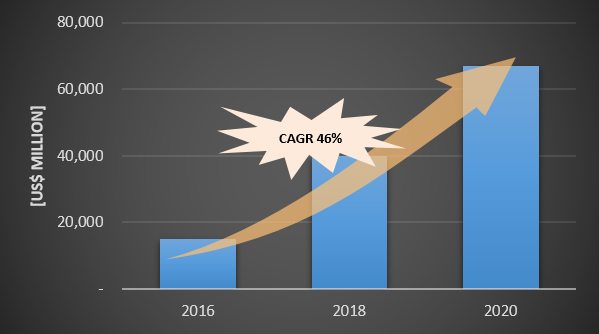
AMOLED Panel Market Forecast (2016-2020)
유비산업리서치에서 발간한 2016 OLED Display Annual Report에 따르면 2016년 AMOLED panel 시장은 2015년보다 약 40% 상승한 US$ 15,000 million 규모가 될 것으로 전망했다. 출하량도 전년대비 16% 상승한 약 2억 7천만 개로 예상하며 2016년은 AMOLED 산업이 재도약 할 수 있는 한 해가 될 것으로 전망했다.
유비산업리서치는 “삼성전자가 Galaxy 보급형 모델에 AMOLED panel을 적극적으로 채택하고 있고, 중국의 set업체에서도 AMOLED panel의 수요가 증가하고 있다. 여기에 Apple의 iPhone에도 flexible AMOLED panel 적용이 확실시 되고 있으며, OLED TV 판매량도 점차적으로 증가하고 있어 LCD를 점차적으로 대체할 것으로 기대된다.” 라고 밝혔다. 특히 mobile 기기용 AMOLED 시장 관련하여 “Flexible AMOLED panel을 탑재할 set에 대한 시장을 분석한 결과 2020년까지 약 월 500K(Gen6기준) 정도 요구될 것으로 예상되어 본격적인 flexible AMOLED 투자가 지속적으로 진행될 것으로 기대된다.”라고 밝혔다.
AMOLED 시장은 2014년 성장이 잠시 주춤했지만 보급형 AMOLED panel과 flexible AMOLED panel 수요 증가로 인하여 2015년 다시 한번 큰 폭으로 성장하였다. 이에 따라 삼성전자와 더불어 전체 smart phone 시장을 주도하고 있는 Apple의 iPhone에 flexible AMOLED panel 적용을 위한 투자가 적극적으로 검토 중에 있다. 또한 중국과 일본, 대만의 panel 업체들 에서도 flexible AMOLED panel에 대한 투자를 할 것으로 기대되고 있는 상황으로 OLED 관련 산업이 침체되어 있는 display산업에 활력을 불어넣을 것으로 예상된다.
한편 본 보고서에 따르면 AMOLED panel 시장은 2015년 약 2억 3천만 개로 US$ 10,000 million을 돌파하며 전년대비 약 25%의 성장 한 것으로 집계하였으며, 2020년까지 연평균 성장률 약 46%로 성장하여 US$ 67,000 million 규모의 시장이 될 것으로 전망하였다.

AMOLED panel 시장 전망(2016~2020)
Japan Display (JDI) officially announced OLED mass production. The press, including the Sankei Shimbun and the Nikkei, reported that on January 22 JDI revealed their plans to begin mass production of OLED panel to be used in smartphone from 2018.
JDI continued development with the aim of LTPS TFT and WRGB OLED technology applied high resolution AMOLED panel mass production for mobile device, and revealed the results through exhibitions in recent years.
In Display Innovation 2014 (FPD International) and SID 2015, JDI have presented 5.2 inch FHD flexible AMOLED panel. Particularly, in SID 2015, JDI showed a notepad equipped with flexible OLED panel.
JDI is likely to mass produce flexible AMOLED following the current mobile device market trend. Although the mass production technology was not mentioned, due to the client demands, it is estimated that either the RGB method, which is being used by LG Display and Samsung Display, or WRGB method, which is being developed by JDI, will be selected.
At present, only Samsung Display and LG Display can mass produce flexible AMOLED panel, but Chinese companies are fast in pursuit. There is much interest in how this JDI’s mass production announcement will affect the future OLED market.
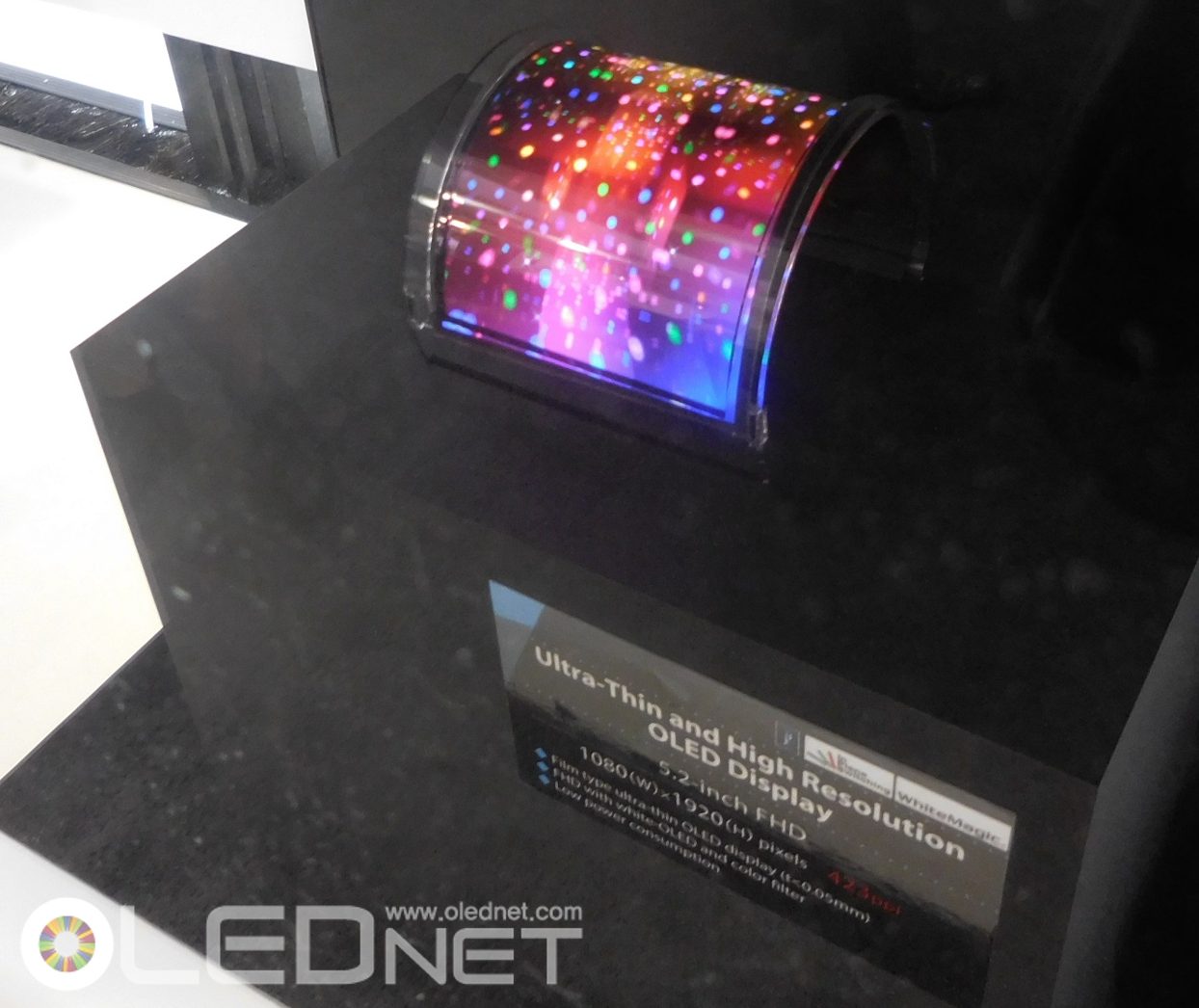
Japan Display(JDI)가 OLED 양산을 공식화했다. 산케이신문, 니케이산업신문 등 외신에 따르면 JDI는 1월 22일 JDI기술전시회에서 오는 2018년부터 스마트폰에 적용될 OLED 패널 양산을 시작하겠다고 밝혔다.
JDI는 LTPS TFT와 WRGB OLED 기술을 적용한 고해상도의 mobile device용 AMOLED panel 양산을 목표로 하고 개발을 지속해왔으며 최근 몇 년간의 전시회를 통해 그 성과를 공개했다.
JDI는 Display Innovation 2014(FPD International)와 SID2015에서 5.2inch FHD flexible AMOLED panel을 전시하였으며 특히 SID2015에서는 flexible OLED panel를 수첩에 적용해 공개한 바 있다.
JDI는 현재 mobile 기기용 시장의 트랜드에 따라 flexible AMOLED 양산이 유력하며, 양산기술에 대해서는 언급을 하지 않았지만 고객사의 요청에 따라 현재 LG디스플레이와 삼성디스플레이가 사용하는 RGB방식 또는 JDI가 개발중인 WRGB 방식 중 선정 될 것으로 예상된다.
현재 flexible AMOLED panel을 양산할 수 있는 업체는 삼성디스플레이와 LG디스플레이가 유일하지만 중국 업체들이 빠르게 추격해오고 있는 추세이며, 이번 JDI의 양산 발표가 앞으로의 OLED시장에 어떤 영향을 미칠지 많은 관심이 모아지고 있다.

JDI’s 5.2inch FHD flexible AMOLED panel, SID 2015
The 2nd OLED KOREA Conference, which is receiving much attention as the world’s largest OLED international business conference, is only 21 days away. At this conference, the OLED industry leading panel companies, Samsung Display and LG Display are scheduled to give keynote sessions. Through this, future OLED industry direction forecast is anticipated. UBI Research is to discuss the rapidly changing the OLED industry’s current status and future, and China’s Visionox is expected to examine the flexible AMOLED’s potential and future market.
Furthermore, sessions with diverse topics are prepared. These include next generation backplane technology, AMOLED mass production technology, issues facing OLED industry, QLED which is receiving interest as the display after OLED, various applications for OELD, etc. Therefore, this event is expected to be useful for materials and manufacturing companies, as well as display panel companies, university, research lab, and display industry related professionals, providing assistance in responding to the next generation display industry and a place of sharing information and thoughts.
Particularly, away from formal discussions, the OLED Reception will prove to be a valuable time through conversations on future of OLED in a comfortable setting.
The 2nd OLED KOREA Conference will be held for 2 days on February 24-25 at The-K Hotel Seoul in South Korea. 9 sessions in total will be held with 30 speakers, including Samsung Display and LG Display, and approximately over 200 display related industry/academy players will be in attendance.
Advance registration is open until February 23 with approximately 10% discount. As the places are limited, early registration is recommended. Conference registration can be accessed through the 2nd OLED KOREA Conference homepage (www.oledkoreaconference.com). Enquiries can be made to Hana Oh (hanaoh@ubiresearch.co.kr).
The 2nd OLED KOREA Conference, which is receiving much attention as the world’s largest OLED international business conference, is only 21 days away. At this conference, the OLED industry leading panel companies, Samsung Display and LG Display are scheduled to give keynote sessions. Through this, future OLED industry direction forecast is anticipated. UBI Research is to discuss the rapidly changing the OLED industry’s current status and future, and China’s Visionox is expected to examine the flexible AMOLED’s potential and future market.
Furthermore, sessions with diverse topics are prepared. These include next generation backplane technology, AMOLED mass production technology, issues facing OLED industry, QLED which is receiving interest as the display after OLED, various applications for OELD, etc. Therefore, this event is expected to be useful for materials and manufacturing companies, as well as display panel companies, university, research lab, and display industry related professionals, providing assistance in responding to the next generation display industry and a place of sharing information and thoughts.
Particularly, away from formal discussions, the OLED Reception will prove to be a valuable time through conversations on future of OLED in a comfortable setting.
The 2nd OLED KOREA Conference will be held for 2 days on February 24-25 at The-K Hotel Seoul in South Korea. 9 sessions in total will be held with 30 speakers, including Samsung Display and LG Display, and approximately over 200 display related industry/academy players will be in attendance.
Advance registration is open until February 23 with approximately 10% discount. As the places are limited, early registration is recommended. Conference registration can be accessed through the 2nd OLED KOREA Conference homepage (www.oledkoreaconference.com). Enquiries can be made to Hana Oh (hanaoh@ubiresearch.co.kr).
The 3rd section of the 1st OLED Frontier Forum (Jan 28), OLED’s Future, held a panel discussion with government, industry, and academia experts discussing OLED industry development strategy, such as next generation technology development, convergent areas, and personnel training, and future forecast. OLEDNET summarized the answers that each expert gave to the questions of the panel chair (Professor Changhee Lee, Seoul National University).
Jun-hyung Souk (Professor, Sungkyunkwan University)
For SDC mobile, as the OLED depreciation is ending the OLED production cost is becoming almost the same as LCD. If OLED related experts stay within Korean industry as well as the technology, Korea can continue to lead for 4-5 years. In order to achieve the continued leadership, differentiation through flexible R2R has to be carried out, as well as the materials and encapsulation technology development.
Sung-Chul Kim (CTO, SDC)
As a-Si is an existing technology, there is no room for further advancement. Sharp’s difficulty in panel business is due to lack of technology research on the panel. Because one technology can only be used for approximately 7 months, diverse technology development is required.
In-byeong Kang (CTO, LGD)
Fast organizations cannot but win. Therefore, rapid change to OLED from LCD is needed. As difficult is the technology, cooperation between academia and industry is needed. Now is the time when this cooperation for next generation technology development is more in demand. LGD is putting in much effort for OLED profitability.
Sung-Jin Kim (Vice President, Toray Advanced Materials Korea)
Cooperation between materials and manufacturing equipment companies is important in solution process materials development. Particularly, how to control dry process is an important issue. Also, Kim expects the current solution process materials development to show tangible results in 3-5 years.
Junyeob Lee (Professor, Sungkyunkwan University)
Solution process is favorable for materials optimization. From the initial concentration on polymer materials, recently small molecule materials focused soluble materials development is being carried out, and how to implement common layer is an issue. Emitting layer is using the small molecule materials that are being used as evaporation materials. The difference is the higher cost as the solvent is used. Also, as there is an issue (formulation problem) when used in large area, solution is required.
Kyoung-Soo Kim (Vice President, Korea Display Industry Association)
Expert acquirement is a key issue. Through upgraded cooperation between industry and academia, and industries, cooperation between panel, manufacturing equipment, and materials has to progress into a positive cycle. Also the open platform regarding new OLED application is needed.
Young-Ho Park (PD, Korea Evaluation Institute of Industrial Technology)
Flexible display competitiveness acquirement is a big concern. Programs for challenging R&D, and high added value product/technology development, and R&D infra establishment (highly cost-effective R&D) have to be considered.
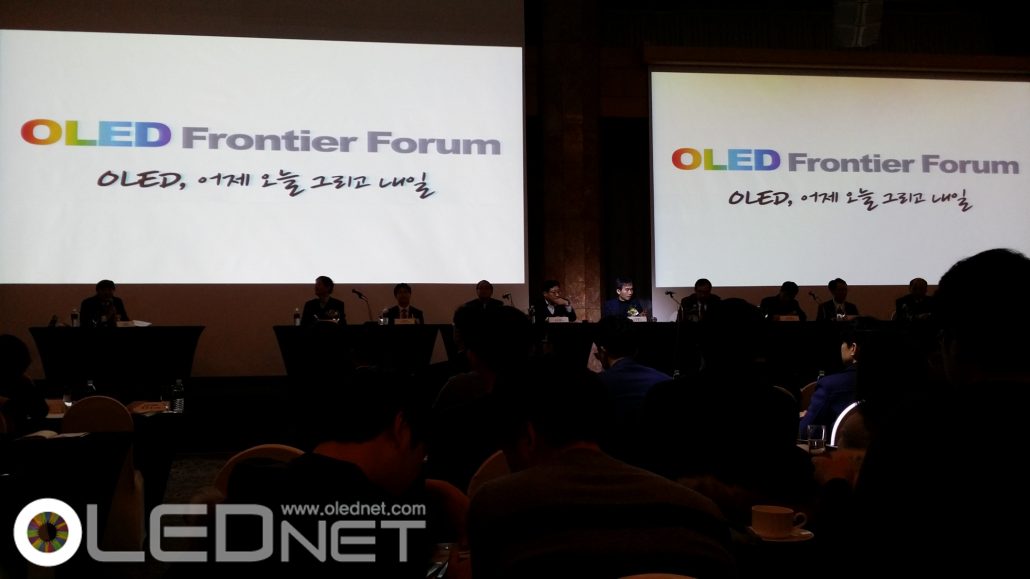
세계 최대의 OLED International Business Conference로 주목받고 있는 제 2회 OLED Korea Conference가 22일 앞으로 다가왔다. 이번 제 2회 OLED Korea Conference에서는 OLED industry를 주도하고 있는 panel 업체인 Samsung Display와 LG Display에서 keynote session 발표가 예정되어 있으며 이를 통해 앞으로 OLED industry가 나아갈 방향에 대해서 전망할 수 있을 것으로 기대된다. 또한, 유비산업리서치에서는 급변하고 있는 OLED industry에 대해 현 상황과 앞으로의 전망을 짚어볼 예정이며 중국의 Visionox에서도 flexible AMOLED에 대한 잠재력과 앞으로의 시장에 대해 다룰 전망이다.
이밖에도 차세대 backplane 기술과 AMOLED 양산기술, OLED산업이 직면하고 있는 이슈, OLED이후의 display로 주목받고 있는 QLED, OLED가 적용될 수 있는 다양한 application등 다양한 주제의 session으로 구성되어 있다. 따라서 display panel 업체뿐만 아니라 재료업체, 장비업체, 대학, 연구소등 display 산업 관련 종사자들에게 앞으로 다가올 차세대display 산업에 대응할 수 있고 다양한 정보와 의견 교환의 장이 마련될 것으로 예상된다.
특히 OLED Reception을 통해 딱딱한 토론에서 벗어나 편안한 분위기 속에서의 대화를 통해 미래의 OLED 그려 볼 수 있는 가치있는 시간이 될 것으로 기대된다.
제 2회 OLED Korea Conference 는 2016년 2월 24일부터 25일까지 이틀 동안 The-K Seoul Hotel에서 개최되며, 총 9개 session, Samsung Display와 LG Display를 포함한 30명의 연사자들이 발표하고 약 200명 이상의display관련 산학연 종사자들 참석할 예정이다.
2월23일까지 사전등록 기간으로, 기간내 등록시 약 10% 할인된 금액으로 등록가능하며 좌석이 한정되어 있어 빠른 등록을 추천한다고 전했다. 컨퍼런스 참가신청은 ‘제2회 OLED KOREA Conference‘ 공식홈페이지(www.oledkoreaconference.com)를 통해 할 수 있으며 관련 문의사항은 오하나 과장(hanaoh@ubiresearch.co.kr)로 하면 된다.
Sung-Chul Kim, Samsung Display’s CTO, at the 1st OLED Frontier Forum (Jan 28) gave a presentation ‘AMOLED Technical Issue and Future’ and discussed OLED technological issues of the past and present.
Kim pointed out the fact that glass substrate is not always necessary for OLED as the most different factor compared to LCD, and emphasized flexible OLED where plastic substrate is used. Kim reported that flexible OLED issues include window’s durability and coating, touch panel’s electrode materials and flexibility, reduction of number of encapsulation layers and flexibility, and backplane’s low stress structure and OTFT application. He revealed that developing spherical stretchable display, which the user can zoom in, is also included in the product roadmap.
Regarding transparent/mirror display, Kim announced that this is the direction that OLED should head toward and added that layout design development suitable for different application areas is needed. Specifically, the transparent display should be developed to increase the transmittance area and decrease the TFT area, and the mirror display to optimize the ratio between the total reflection and half-reflection areas.
Additionally, in order to produce high resolution OLED, Kim mentioned that innovation in terms of pixel operation and backplane structure is needed. He emphasized compensation circuit and that whether high resolution display can be manufactured cheaply and using simple structure is the key.
Kim discussed wall display, IoT, educational display, etc. as the new applications which will become important in future. Particularly, mentioning the automotive display area, Kim explained that for OLED to enter these new areas, plastic materials suitable for each applications and technology that can correctly process this are required. In order for this type of research development to be carried out smoothly, Kim added that cooperation between the academia and industry is necessary.
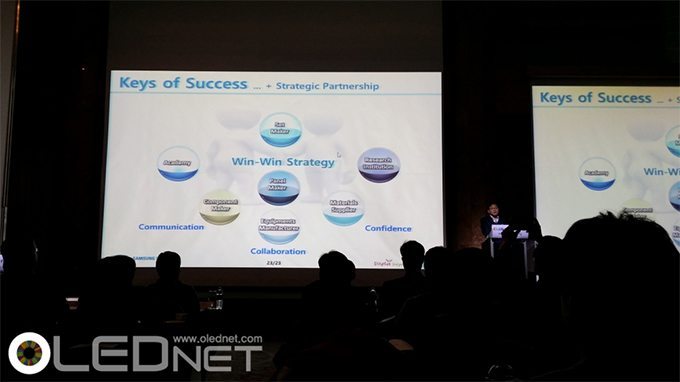
제 1회 OLED Frontier Forum의 제 3부 ‘OLED 미래’에서는 정부, 업계, 학계 전문가들이 참석한 가운데, 차세대 기술개발, 융복합 분야, 인력양성 등 OLED 산업 발전 전략과 미래 전망에 대한 패널 토론이 진행되었다. OLEDnet에서는 사회자(이창희 교수, 서울대)의 질문에 대한 각 분야별 전문가들의 답변 내용을 요약하였다.
석준형 교수 (성균관대)
SDC Mobile의 경우 OLED의 감가상각이 끝나가기 때문에 OLED의 원가는 LCD와 거의 같아지고 있다. OLED관련 전문 인력만 빼앗기지 않으면 4~5년은 한국이 주도해나갈 수 있다.(Black Box화 전략) 지속적인 주도권 확보를 위해 flexible R2R로 차별화를 해야하며, 이와 더불어 소재와 encapsulation쪽 기술개발 필요하다.
김성철 CTO (SDC CTO)
a-Si는 기술적 차별성이 없다. Sharp의 panel 사업이 어려움을 겪은 이유는 panel에 대한 기술연구를 하지 않았기 때문이다. 한가지 기술로는 7개월 밖에 못 가기 때문에 다양한 기술에 대한 개발이 필요하다.
강인병 CTO (LGD CTO)
빠른 조직이 이길수 밖에 없다. 따라서 LCD에서 OLED로의 빠른 전환이 필요하다. 기술이 어려운만큼 산학연의 협력이 필요하며, 차세대 기술개발에 대한 산학연의 협력이 더욱 필요한 시점이다. LGD는 OLED 흑자를 위해 열심히 노력하고 있다.
김성진 전무(도레이 첨단 소재)
소재 업체와 장비 업체의 협력이 용액공정 재료 개발 시 중요하며 특히 Dry process를 어떻게 control을 할 것이냐가 중요한 이슈이다. 또한 현재의 용액공정 재료 개발은 3 ~ 5년 정도면 가시적인 결과를 볼 수 있으리라 판단한다.
이준엽 교수 (성균괸대)
용액공정이 재료 최적화에 유리하다. 초기 고분자 위주에서 최근에는 저분자 위주의 soluble 재료 개발이 이루어지고 있으며 공통층을 어떻게 가져가느냐에 대한 이슈가 있다. 발광층은 현재 증착 재료로 사용되고 있는 저분자 재료를 그대로 사용하고 있으며 차이점은 용매를 사용하기 때문에 가격 측면에서 현재는 비싸다는 이슈가 있으며, 또한 대형화 시 문제점(formulation 문제)이 있어 이에 대한 해결이 필요하다.
김경수 부회장(디스플레이 산업 협회)
전문인력 확보가 관건이며, 산학연 or 기업간 협력을 upgrade 시켜 panel-장비-소재간의 협력이선순환관계로 발전되어야 한다. 또한 새로운 OLED 응용분야에 대한 open platform이 필요하다.
박영호 PD(한국 산업기술평가 관리원)
Flexible 디스플레이 경쟁력 확보에 대한 고민이 크다. 도전적 R&D를 위한 program과 고부가가치의 상품/기술 개발, R&D infra 구축(가성비 높은 R&D)에 대해 깊은 고민을 해야 한다.
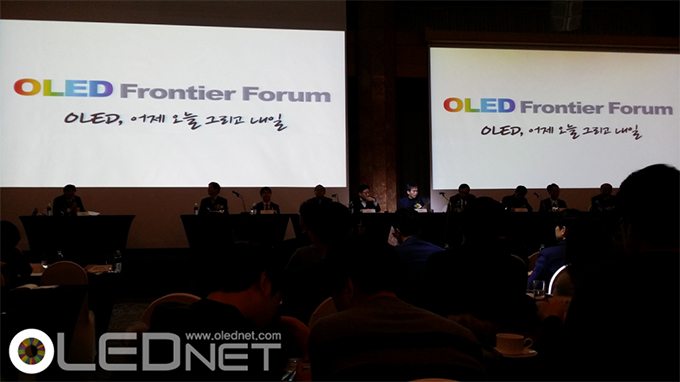
제1회 OLED Frontier Forum에서 삼성디스플레이의 김성철 CTO는 ‘AMOLED Technical Issue and Future’라는 제목으로 OLED의 과거와 현재의 기술적인 이슈에 대해 점검하는 시간을 가졌다.
김성철 CTO는 OLED가 LCD에 비해 가장 차별화되는 점으로 꼭 glass 기판이 필요하지 않다는 것을 꼽으며, plastic 기판이 적용되는 flexible OLED에 대해 강조하였다. 김성철 CTO는 “플렉시블 OLED에 대한 이슈로 window의 내구성과 코팅, 터치패널의 전극 재료와 flexibility, encapsulation의 layer수 감소와 flexibility, backplane의 저stress 구조와 OTFT 적용이 있다.”고 발표하며 사용자가 관심있어 하는 부분을 확대하여 볼 수 있도록 구 형태의 stretchable 디스플레이를 개발하는 것까지 제품 로드맵이 되어 있다고 밝혔다.
김성철 CTO는 투명/거울 디스플레이와 관련해서는 앞으로 OLED가 발전해 나아가야 할 길이라고 밝히며 각 응용 분야에 알맞은 layout design 개발이 필요하다고 이야기하였다. 이에 대해 “구체적으로 투명 디스플레이는 투과부가 높아지고 TFT 면적이 낮아지는 방향으로, 거울 디스플레이는 전반사와 반반사 부분의 비율을 최적화하는 방향으로 개발되어야 한다.”고 발표했다.
또한 고해상도 OLED를 제작하기 위해서는 pixel 구동과 backplane 구조 측면에서 혁신이 필요하며, 특히 보상회로를 강조하며 ‘고해상도 디스플레이를 저렴하고 단순한 구조로 만들 수 있는가’가 핵심이라고 밝혔다.
미래에 중요하게 될 새로운 application으로 김성철 CTO는 wall 디스플레이, IoT, 교육용 디스플레이 등이 있다고 발표했다. 특히 차량용 디스플레이 분야를 언급하면서 OLED가 이런 신규 분야에 진출하기 위해서는 각 application에 알맞은 플라스틱 재료와 이를 제대로 가공할 수 있는 기술이 필요하며, 이러한 연구 개발이 원할히 진행되기 위해서는 산학연 연계가 필수적이라고 밝혔다.

On January 28, Korea Display Industry Association organized the 1st OLED Frontier Forum in JW Marriott Hotel Seoul.
Under the title ‘OLED, Yesterday, Today, and Tomorrow’, the forum attendees could review Korean OLED research results of the past 20 odd years, and discussed regarding future OLED industry growth strategy.
LG Display’s CTO In-byeong Kang gave a presentation on Large Area OLED Status and Future and talked about the current status and forecast of large area OLED which is expected to become the key area of future display.
Since the mass production of first 55 inch OLED panel that utilized WRGB method and oxide TFT, 3 years went past. During those 3 years, Kang revealed that many innovations were carried out in terms of TFT device, compensation algorithm, OLED device, OLED materials, and processes.
First, the oxide TFT structure changed to coplanar method from etch stopper method, and for compensation wiring, the internal compensation was changed to external compensation. Also, he revealed that through much effort, the existing OLED device and materials were changed to new structure and high efficiency and high color gamut OLED emitting materials. Kang added that the uniformity, which becomes the most crucial point in large area OLED panel mass production, was greatly improved in Gen8 manufacturing equipment.
In 2013, there was only 1 LG Electronics’ OLED TV, 55 inch FHD, but recently 77 inch and 65 inch were added, and the resolution increased to UHD. Kang emphasized that although the 2013 product was priced at 11 million KRW with 100/400 nit of brightness but recent products have brightness of 150/450 nit at the reduced price of 4.2 million KRW.
LG Display is going through many changes recently. OLED business department began operation from last year. Large area OLED panel, which started with 8K monthly mass production at Gen8, is now being produced at 26K in full operation. Also, additional investment of 10 trillion KRW to large area panel has been decided, and new factory is being built in Paju. Kang told the audience that he heard many positive views on large area OLED at CES, and that there was a huge response regarding the 77 inch HDR video. Kang revealed confidence in the technology reporting that rather than replacing LCD, OLED could succeed as a totally different display.
Regarding the next 20 years, Kang forecast that the flat will move toward transparent and flexible, and OLED is the most suitable for this. He explained that the Korean government estimated this and is carrying out national project titled ‘≥60 inch UHD level transparent flexible display and applicable IT fused infotainment system development’ for the past 4 years. LG Display is responsible for this project’s overall consortium, and is planning to reveal UHD level 60 inch transparent flexible OLED panel in 2017 summer when the project is complete.
At the end of the presentation, Kang summarized 3 innovation factors for large area OLED. First, the substrate materials at Gen8 has to change to PI and transparent PI. Second, even for flexible substrate, the structure has to change to top emission from bottom emission, and lastly, Kang added that much more diverse applications have to be considered for flexible panel.
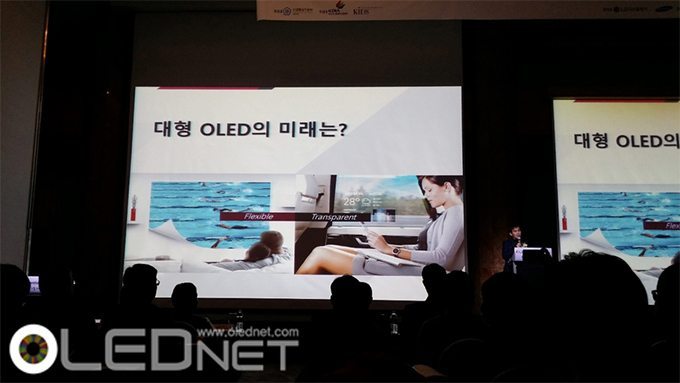
1월 28일 서울 JW메리어트호텔에서 한국디스플레이산업협회의 주최로 제1회 OLED Frontier Forum이 열렸다.
‘OLED, 어제 오늘 그리고 내일’이라는 주제로 진행된 이번 forum에서는 지난 20여년 동안의 국내 OLED 연구 성과를 돌아보는 시간을 가졌으며 향후 OLED 산업 발전전략 수립을 위한 토론이 진행되었다.
강인병 LG디스플레이 CTO는 ‘대형 OLED 현황과 미래’라는 제목의 발표를 통해 미래 디스플레이의 핵심적인 분야가 될 것으로 보이는 대형 OLED의 현재 상황과 전망에 대해 논했다.
WRGB 방식과 oxide TFT를 최초로 도입한 55inch OLED 패널이 2013년 처음 양산 시작된 후 3년이 지났다. 강인병 CTO는 3년이라는 시간 동안 TFT소자와 보상 algorithm, OLED소자, OLED재료, 공정의 측면에서 많은 혁신이 있었다고 밝혔다.
먼저, Oxide TFT 구조를 etch stopper 방식에서 coplanar로 바꾸었으며 보상회로는 내부보상에서 외부보상으로 바꾸었다고 밝혔다. 또한 많은 노력을 통해 기존 OLED의 소자와 재료를 새로운 구조를 가지고, 고효율, 고색 OLED 발광 재료로 바꾸었다고 발표했다. 그리고 대면적 OLED panel 양산에서 가장 핵심적인 수치가 되는 균일도를 Gen8 장비에서 크게 향상시켰다고 밝혔다.
LG전자의 OLED TV 제품은 2013년 55inch FHD TV 한 종류 였지만 최근에는 여기에 77inch와 65inch 제품군을 추가했으며 해상도는 UHD까지 올라갔다. 강인병 CTO는 “2013년 제품은 1,100만원의 가격에 100/400nit의 휘도를 가졌지만 최근의 제품은 150/450nit의 휘도를 가지면서도 가격은 420만원으로 낮추었다.”고 강조했다.
LG디스플레이는 최근 많은 변혁을 거치고 있다. 작년부터 OLED 사업부를 가동하였으며 대형 OLED panel을 양산초기 Gen8 기준으로 월 8K 생산에서 최근에는 26K로 올려 풀가동 중이다. 또한 대형 panel에 10조원의 추가 투자를 결정했으며 이에 따라 파주에 신공장을 건설하고 있다. 강인병 CTO는 “CES에서 대면적 OLED에 대해 긍정적인 이야기를 많이 들었으며 특히 77inch HDR 영상에 대해 큰 호응이 있었다.”고 말과 함께 “OLED가 LCD를 대체하는 것이 아니고 LCD와 전혀 다른 디스플레이로 성공가능성이 있다는 말도 들었다.”고 하며 기술에 대한 자신감을 드러냈다.
강인병 CTO는 OLED의 향후 20년 전망에 대해 flat에서 투명&플렉시블로 갈 것이라고 밝히며 여기에 가장 적합한 건 OLED이라고 발표했다. 이에 대해 “정부에서는 이런 상황을 예측하고 4년전부터 ‘60inch이상 UHD급 투명플렉시블 디스플레이 및 이를 활용한 IT융합형 인포테인먼트 시스템 개발’이라는 제목의 국책사업을 진행하고 있으며 이 국책사업의 종합 컨소시엄을 LG디스플레이가맡게 되었다.”고 밝히며 “과제가 종료되는 2017년 여름에 UHD급의 60inch의 투명 플렉시블 OLED 패널을 선보일 예정에 있다.”고 발표했다.
발표의 마지막 부분에 강인병 CTO는 대형 OLED가 혁신할 수 있는 요건에 대해 3가지로 요약했다. 먼저, 패널 측면에서 Gen8 급에서도 기판 재료가 PI와 투명PI로 바뀌어야 하며 플렉시블 기판에서도 bottom emission이 아닌 top emission을 구현해야 하고, 플렉시블 패널을 활용한 application 또한 더욱 다양하게 고민해보아야 한다고 밝혔다.

On January 28, OLED Frontier Forum, ‘OLED, Yesterday, Today, and Tomorrow’ was held in Seoul, Korea. With approximately 250 attendees from the industry, academia, and government organizations, experts discussed scenes from the early days of OLED development, the current market and technology competition status, and future industry development issues.
President of UBI Research, Choong Hoon Yi, was the first speaker of the first section, and gave a presentation titled ‘Korean OLED Industry Creating Something from Nothing’, introducing figures from the initial stages of OLED development and now. In 1996, Yi, in charge of Strategy Technology Planning of Samsung Display Devices (now Samsung SDI), calculated OLED to be the most powerful display inheriting from LCD. Asserting the need for development, Yi led the OLED research development investment.
Discussing the most influential people within the 20 years of OLED industry, Yi first mentioned Samsung SDI’s vice chairman Soon-taek Kim, explaining that despite the IMF crisis Kim decided on AMOLED investment and laid the foundation for Samsung’s main role within the OLED industry. On top of this baiss, Ho Kyoon Chung (then Samsung SDI’s vice president) began active development of small size AMOLED, and Samsung Display’s vice president Sung-Chul Kim is responsible for Samsung’s OLED for mobile device of now. Yi also introduced Miwon Commercial’s CEO Kyu-Ha Chung (then Samsung Electronics executive director) as the key player who suggested vision for large area OLED through world’s first development of 40 inch WRGB OLED. Within LG Display, vice chairman Sang-beom Han was mentioned as the person responsible for OLED TV’s market release through difficulty decision of large area OLED investment, and CTO In-byeong Kang for technological advances as the person in charge of OLED development. For academia, Yi discussed Seoul National University’s Professor Changhee Lee as the first person in Korea who began white OLED development and contributed to OLED standardization. Professor Jin Jang of Kyung Hee University suggested oxide TFT’s commercialization prospect and mentored many people who contributed to Korean OLED industry. Yi, together with Sung-Chul Kim and Dr. Nam-Yang Lee (then LG Philips LCD director) established OLED sector within Korea Display Industry Association. During the talk, he introduced how this formed the inter cooperative structure with OLED industry companies and contributed to Korean OLED industry success on the basis of governmental support.
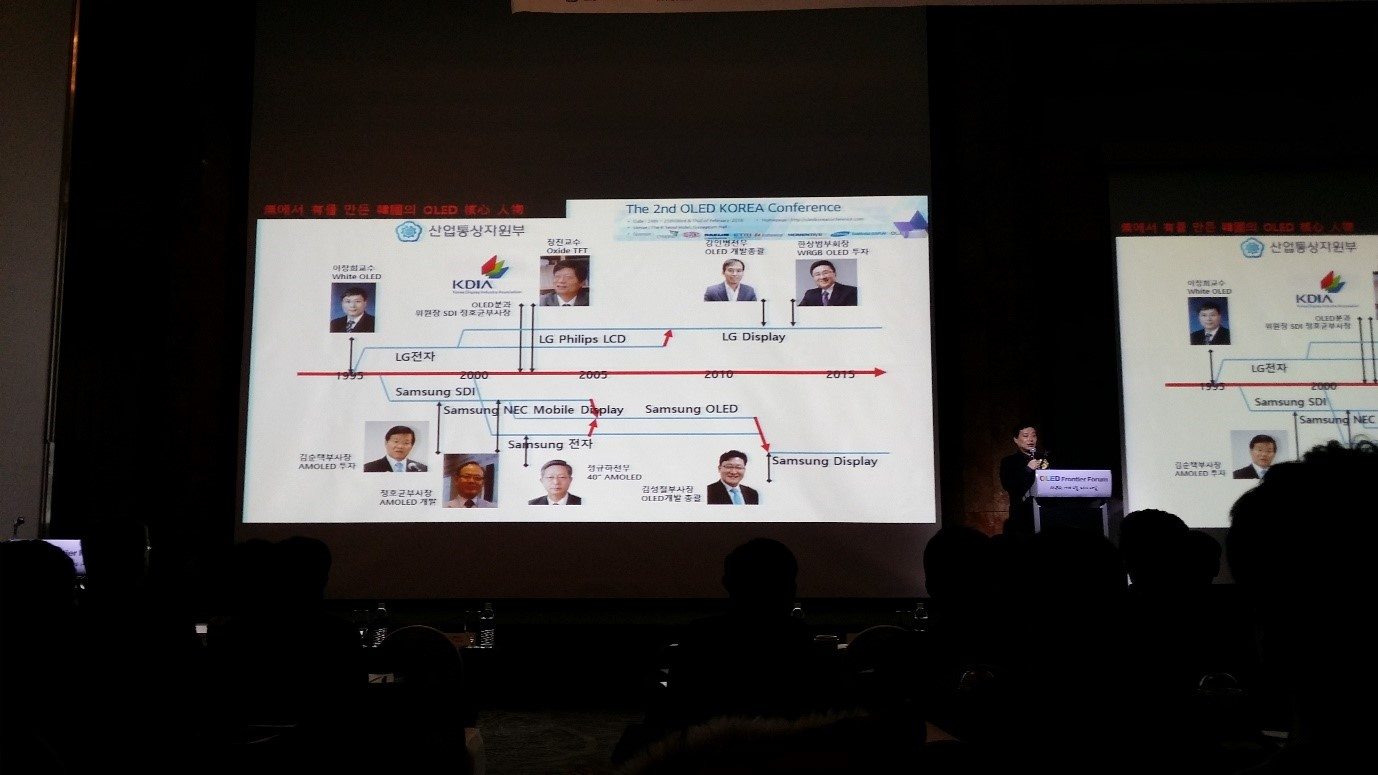
In the second section of the event, LG and Samsung’s CTOs presented on OLED industry’s key issues, and future innovative technology. The 2 companies both discussed current technology, products and projects that need to be solved in order to increase the competitiveness of OLED.
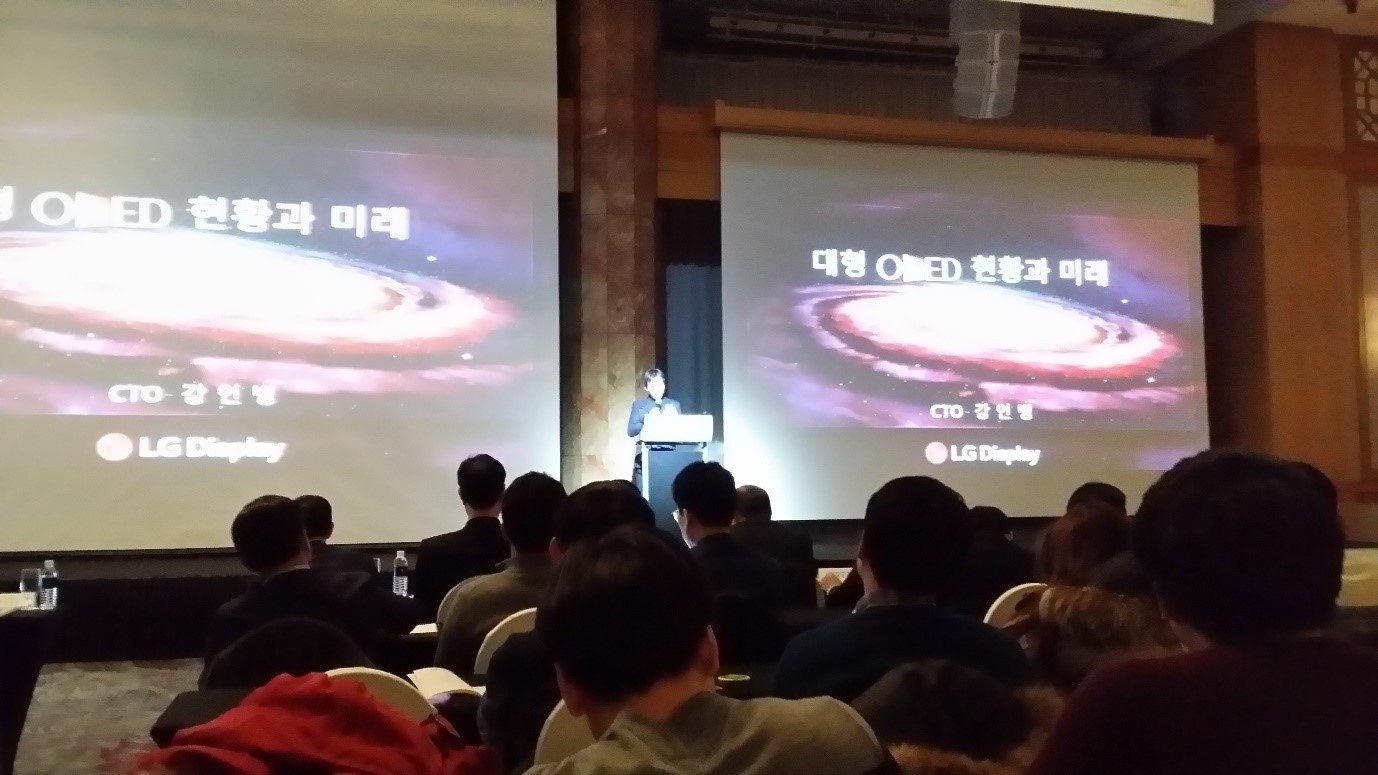
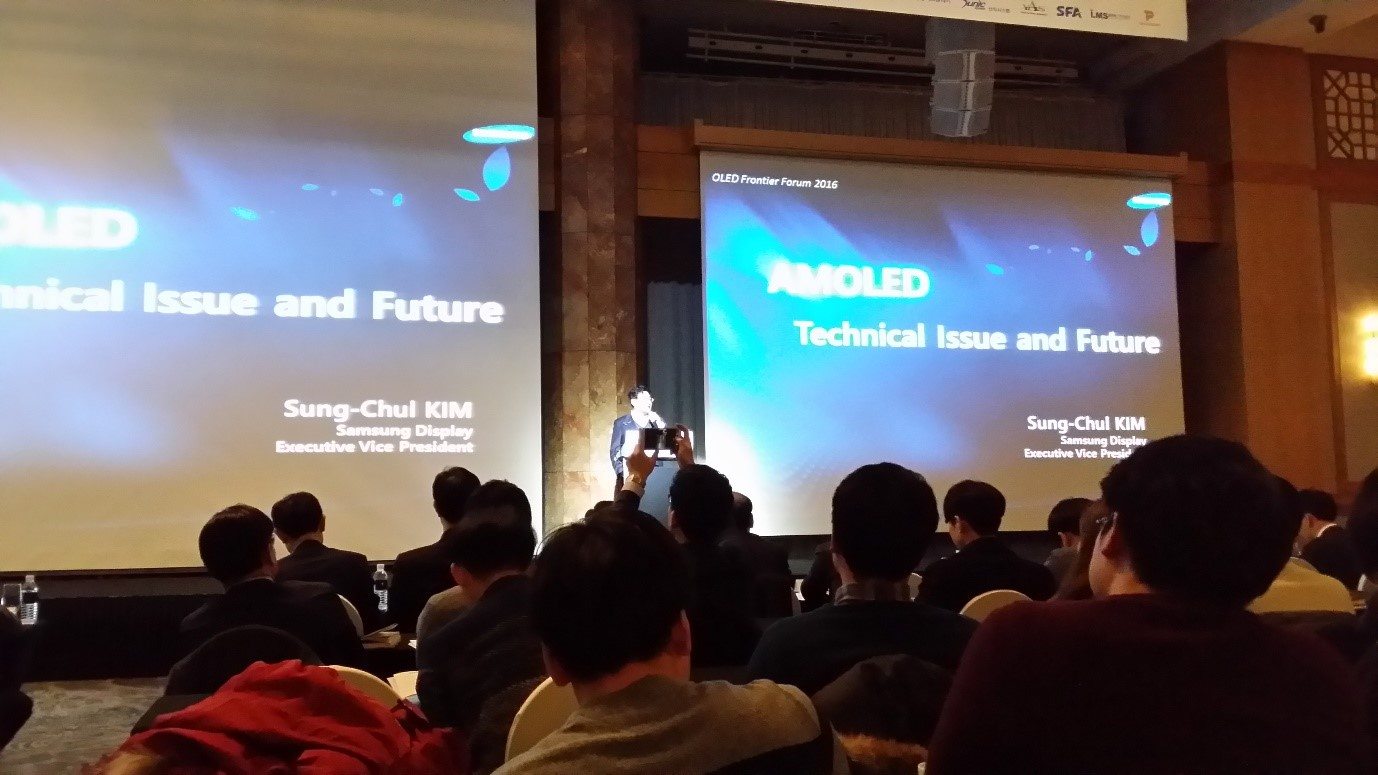
During the last section, the speakers panel discussion handled how to respond to China’s rapid growth. The speakers all agreed on the need for acquisition and hold on experts, corporation between industry and academy, and between companies, and new application areas.
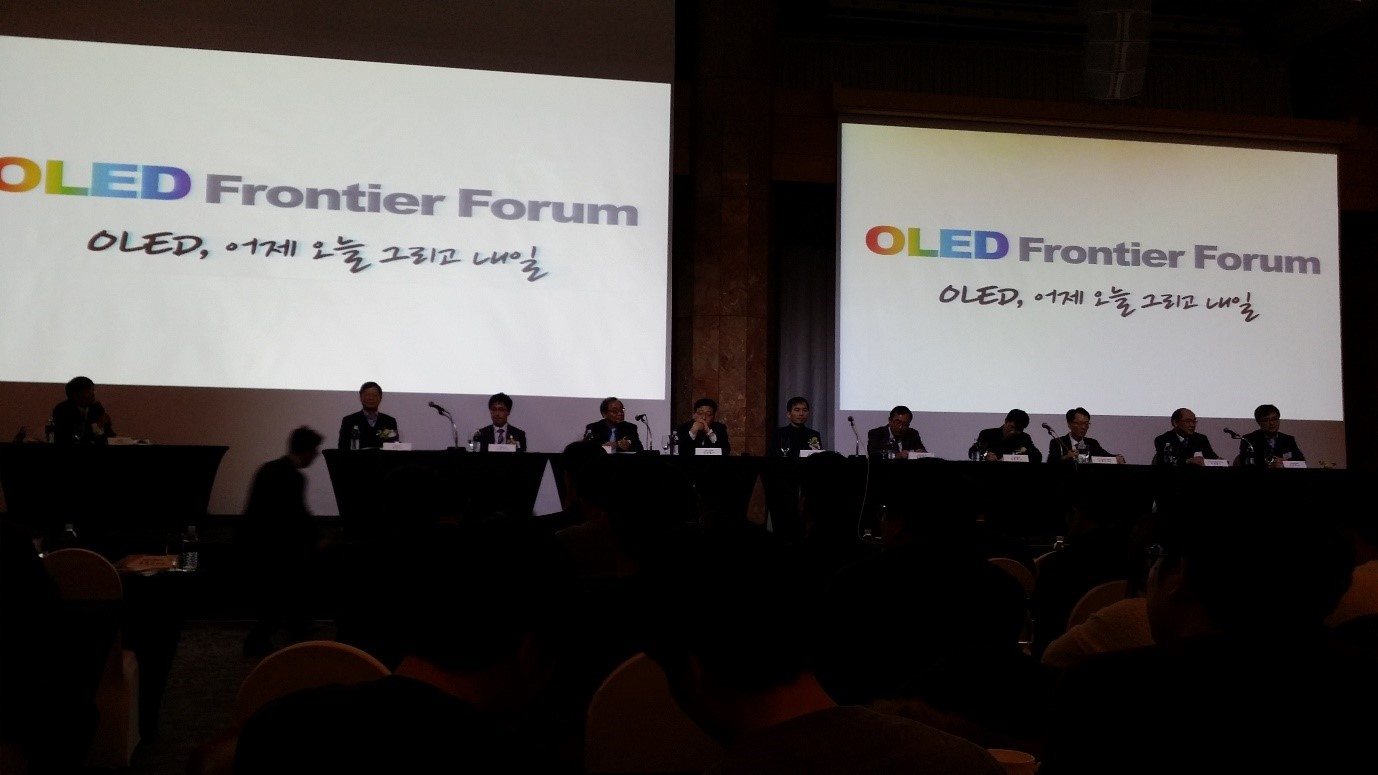
2016년 1월 28일 JW 메리어트 호텔에서 개최된 ‘OLED Frontier Forum, OLED 어제 오늘 그리고 내일’에는 산, 학, 연 및 정부 기관 등 250여명의 참석들이 OLED 개발 초기의 에피소드, 현재의 시장 및 기술 경쟁 현황, 그리고 미래의 산업 발전 이슈에 대해서 같이 고민하는 시간을 가졌다.
1부의 첫번째 연사자로 나선 유비산업리서 치의 이충훈 대표는 ‘무에서 유를 창조한 한국의 OLED 산업’이라는 주제로 OLED 개발 초기부터 현재까지 OLED 개발의 신화같은 인물들을 소개하였다. 삼성전관에서 전략기술기획을 담당하던 시절인 1996년에 OLED가 LCD를 이을 최강의 디스플레이가 될 것임을 판단하고 개발 당위성을 피력하여 연구 개발 투자를 이끈 이대표는 20년 동안 지켜본 OLED 산업에서 가장 영향력이 큰 인물들로서 첫번째로는 삼성SDI의 김순택 부회장을 선정하였다. IMF 시절임에도 불구하고 AMOLED 투자를 결정하여 삼성이 현재의 OLED 주역으로 성장할 수 있는 기반을 마련한 가장 중요한 인물임을 피력하였다. 그 바탕 위에 정호균 부사장(당시 삼성SDI)은 소형 AMOLED 개발을 본격적으로 시작하게 되었고 삼성디스플레이의 김성철 부사장은 현재 삼성의 모바일용 OLED를 있게 한 주역이라고 밝혔다. 이 대표는 또한 미원상사 정규하사장(당시 삼성전자 정규하 전무)이 세계 최초로 WRGB OLED로서 40인치를 개발하여 OLED가 대형화 될 수 있는 비젼을 제시한 핵심 주역으로 소개하였다. LG디스플레이에서는 한상범 부회장이 쉽지 않은 대형 OLED 투자를 결정함으로써 OLED TV가 시장에 나오게 된 산업의 핵심 인물로서, 기술적으로는 강인병 전무가 OLED 개발 총괄로서 가장 큰 기여를 한 것으로 평가하였다. 학계에서는 서울대 이창희 교수가 한국에서는 최초로 White OLED의 개발을 시작하였으며 OLED 표준화에 기여한 인물이며, 경희대 장진 교수는 Oxide TFT의 사업화 가능성을 제안하였고 한국 OLED 산업에 많은 인재를 배출한 공로를 인정하였다. 마지막으로는 이대표가 삼성디스플레이 김성철부사장과 이남양박사(당시 LG필립스 LCD 상무)와 함께 한국디스플레이 산업협회내에 OLED 분과를 설립하여 OLED 산업에 종사하는 기업들의 이종 협력 체계를 구성하여 정부의 강력한 지원을 바탕으로 한국이 OLED 산업이 성공할 수 있게 된 역사를 소개하였다.

2부에서는 LG와 삼성의 CTO가 OLED 산업의 주요 이슈 및 미래 혁신 기술에 대해서 발표를 하였으며, 두 회사 모두 OLED의 경쟁력을 높이기 위해 현재 보유하고 있는 기술과 제품, 향후 해결해야 할 과제에 대해서 발표를 하였다.


마지막 3부 발표자들의 패널토론에서는 현재 중국의 급속한 성장에 대응할 방안을 같이 토론하는 시간을 가졌고, 전문 인력의 확보 및 유출 방지, 산학연 또는 기업간 협력, 새로운 응용분야의 확보가 필요하다는데 인식을 같이 하였다.

On January 27, LG Display held Q4 2015 earnings announcement, stating that the business profit recorded a surplus for 15 consecutive quarters, and annual profit of over 1 trillion KRW for 3 years.
LG Display’s Q4 2014 sales recorded 7,495,700 million KRW, a 5% increase from the previous quarter’s 7,158,200 million KRW and 10% decrease from 8,341,900 million KRW of the same period from the previous year. The business profit of 60,600 million KRW in Q4 is a significant decrease from previous quarter’s 332,900 million KRW and previous year’s 625,800 million KRW, a decrease of 82% and 90% respectively.
Sang-don Kim, LG Display’s CFO, mentioned that the business condition has been difficult due to weak demand and reduced panel prices as a result of China’s additional capa. establishment. Stating that it is hard to expect demand recovery as the economy continues to be uncertain in 2016, they suggested that the poor performances could continue.
Kim, in order to overcome the current situation, put up the keywords ‘choice and focus’. He reported that the investment could be flexible at times, but 50-60% of this year’s investment will be focused on OLED. He emphasized that choice and focus will be on areas with technological merits such as large area, M+, and AIT.
During the LG Electronics performance announcement (January 26), CFO Do Hyun Jung asserted world’s top premium image mentioning the OLED TV. LG Display also showed confidence in large area OLED technology. Sang-don Kim stated that OLED is a technology that exceeds existing LCD, and not only will it replace LCD TV but it is expanding the market and cemented its place as a premium product, jumping ahead of quantum dot TV. He added that whether in large size or small to mid-size, the technology difference of LCD with Chinese companies is 2-3 years, OLED is 5-6 years.
On January 28, Samsung Electronics, through conference call, analyzed Q4 2015 and announced overall results of 2015. Q4 2015 sales of Samsung Electronics recorded 53,320,000 million KRW, a 3% increase from previous quarter, and 6,140,000 million KRW of business profit, an increase of 1,250,000 million KRW from previous quarter.
CE (consumer electronics) department showed highest increase of sales compared to previous quarter. Samsung Electronics revealed that LCD TV is receiving great response in advanced market, and that the sales in North America increased by 94% from previous quarter. They also estimate that the demand will increase in 2016 due to Rio 2016 Olympics
However, Samsung Electronics’ IM (IT and Mobile) department mentioned that as the smartphone market growth is expected to remain in single digit and competition between companies will become fierce, estimating that future is not simply bright. As a response to this, Lee emphasized that through strengthening of product and efficient lineup they will maintain the margin of double digits. Additionally, Samsung Electronics’ foldable OLED is rising as the new form factor for product build up. In regards to this, Samsung Electronics revealed that foldable display development is smoothly being carried out and they will deal with mass production and market release timing after discussions with customer companies.
With the recent news regarding Samsung Display’s second stage investment for A3 line, there is much interest. Samsung Electronics explained that although A3 related investment is estimated for small to mid-size OLED additional investment, detailed plans have not been confirmed. However, through proactive additional capa. increase, they are planning to strengthen Samsung Display’s competitiveness.
Regarding large area display, Samsung Electronics reported that they are the only company that is mass producing by using environmentally friendly quantum dot technology. While revealing pride in SUHD TV’s technology prowess, they also suggested new form factor stating they are looking for the best cost competitive mass production method considering large size OLED marketability through diverse research development.
삼성전자는 28일 Conference Call을 열고 2015년 4분기를 분석하고 2015년 전체 성과를 발표했다. 2015년 4분기 삼성전자의 매출액은 53조 3200억원 전 분기 대비 3% 상승했으며, 영업이익은 6조 1400억원으로 전 분기 대비 1조 2500억원 상승했다.
전 분기 대비 매출액 증가가 가장 큰 부문은 CE(Consumer Electronics)로 20%의 매출액 상승을 기록했다. 삼성전자는 LCD TV가 선진 시장에서 큰 호응을 얻고 있다고 밝히며 특히 북미에서 판매는 전 분기 대비 94%가 올랐다고 발표했다. 또한 2016년에는 리우올림픽이 열리는 만큼 올림픽 효과에 따른 수요 증가가 예상된다고 밝혔다.
반면 삼성전자 무선사업부 이경태 상무는 “올해 스마트폰 시장이 한자릿수 성장에 그쳐 업체간 경쟁이 치열해질 것”이라고 언급하며 향후 전망이 긍정적이지만은 않음을 전망했다. 이에 대한 대책으로 이 상무는 제품력을 강화하고 라인업을 효율화해 시장환경변화에 대응해 두자릿수 마진 유지하겠다.”고 강조했다. 현재 제품력 강화에 대해 새로운 form factor로 삼성전자의 foldable OLED가 떠오르고 있다. 이에 대해 삼성전자는 “Foldable 디스플레이 개발은 현재 순조롭게 진행 중이다.”라고 밝히며 “향후 고객사와 합의해 양산과 시장 출시 시기를 대응하겠다.”고 발표했다.
최근 삼성디스플레이의 A3라인 2단계 투자에 대한 소식이 들리면서 이에 대한 이목이 집중되고 있다. 삼성전자는 “중소형 OLED 증설 투자는 A3 관련 투자가 예상되지만 아직 구체적인 계획은 확정하지 않았다”고 하며 “다만 선행적인 capa. 증설을 통해 삼성디스플레이의 경쟁력을 강화할 계획”이라고 밝혔다.
대면적 디스플레이와 관련해서 삼성전자는 “친환경 quantum dot 기술을 사용해서 양산하는 업체는 삼성전자기 유일하다.”고 하며 SUHD TV의 기술력에 대한 자부심을 드러내면서도 “대형 OLED는 시장성을 염두해 두고 다양한 연구 개발로 원가경쟁력 가진 최고의 양산방법 찾고 있다.”고 하며 새로운 form factor에 대한 여지를 남겼다.
1월 27일 서울 여의도 LG트윈타워에서 개최한 2015년 4분기 실적발표회에서 LG디스플레이는 영업이익이 15분기 연속 흑자가 났으며 연간 영업이익 또한 3년 연속 1조원대를 달성했다고 발표했다.
LG디스플레이의 2015년 4분기 매출은 7조4957억원으로 전 분기 7조1582억원 대비 5% 증가했으나 전년 동기 8조3419억원 대비해서는 10% 감소했다. 또한 4분기 영업이익 606억원은 전 분기 3329억원과 전년 동기 6258억원 대비 각각 82%와 90% 큰 폭으로 감소한 실적이다.
LG디스플레이의 김상돈 CFO는 여기에 대해 “수요부진과 중국 capa. 증설에 따른 패널가격의 약세로 어려운 사업환경을 이어나갔다.”고 언급했다. 또한 “2016년 또한 경기 불확실 지속으로 수요 회복을 기대하기 어려운 상황”이라고 하며 실적악화가 지속될 수 있다는 가능성을 내비쳤다.
김상돈 CFO는 현 상황을 타개하기 위해 ‘선택과 집중’이라는 키워드를 내세웠다. “투자 집행은 그때마다 탄력적으로 움직일 수 있지만 기본적으로 올해 투자의 50~60%는 OLED에 집중하겠다”고 하면서 “기술적인 관점에서는 대형, M+, AIT 등 장점이 있는 부분에 선택과 집중을 하겠다.”고 강조했다.
26일 열린 LG전자 실적발표회에서 정도현 CFO는 OLED TV를 ‘세상에 없는 TV’라고 언급하며 세계 최고 프리미엄 이미지를 강조했다. LG디스플레이도 이 날 대면적 OLED 기술에 대한 자신감을 내비쳤다. 김상돈 CFO는 “OLED는 기존 LCD를 뛰어넘는 기술로 LCD TV를 대체하는 것뿐만 아니라 시장을 확대해 나가고 있으며 퀀텀닷 TV를 뛰어넘어 분명히 프리미엄 제품으로 자리 잡혔다.”라고 말하며 “중국 업체들과의 기술격차가 대형이든 중소형이든 LCD는 2~3년이지만 OLED는 5~6년이다.”라고 강조했다.
LG Electronics CFO, Do Hyun Jung announced that they expect this year’s OLED TV’s demand to be approximately 4 times higher than last year’s.
With this statement during the LG Electronics earnings announcement (January 26), Jung demonstrated determination in popularization of OLED TV. Regarding the forecast of Q1, he estimated that despite the slow season, profit structure will improve through product mix improvement and production cost structure among others.
It was also revealed that the UHD OLED TV and UHD premium TV sales increased in Q4 2015. Particularly, OLED TV products recorded double the amount of previous quarter’s shipment, occupying 10% of the total TV sales.
Regarding the total TV market, Jung forecast that the 2016 demand stagnation will continue. Revealing that LG Electronics’ TV market share fell slightly, demand for premium products such as OLED TV and UHD TV is anticipated. He added that LG Electronics will cement the image of world leading premium products through OLED TV and compete through quality and performance.
In Q4 2015, LG Electronics Home Entertainment business increased shipment in key markets such as Europe, Russia, and North America, and recorded revenue of 4,740,000 million KRW, a 11% growth compared to previous quarter, and business profit also increased to 2.3% from 0.9%.
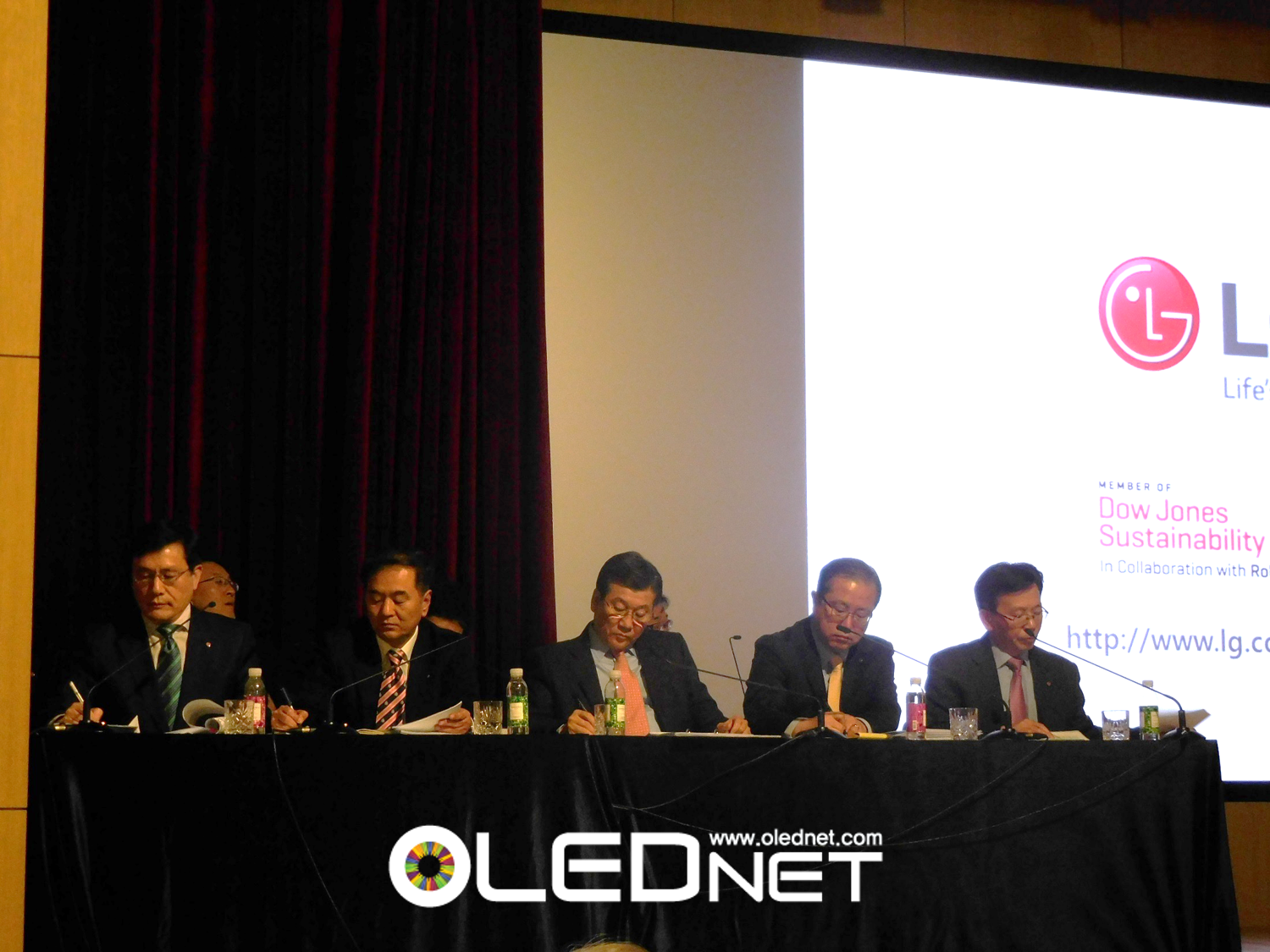
LG Electronics Earnings Announcement
LG전자 CFO인 정도현 사장이 ‘올해 OLED TV의 수요는 전년도에 비해 4배 가까이 될 것으로 예상된다’라고 밝혔다.
정사장은 26일 LG트윈타워에서 열린 LG전자 실적발표회에서 이같이 밝히며 ‘2016년에 OLED TV 수요를 본격화 하겠다’라고 말하며 OLED TV 대중화에 대한 의지를 내비쳤다. 1분기에 대한 전망에서는 ‘계절적 비수기지만 제품 믹스 개선과 원가 구조 등을 통해 수익 구조는 개선될 것’이라고 예상했다.
2015년 4분기는 UHD OLED TV와 UHD 프리미엄 TV 제품의 매출이 상승하였고, 특히 OLED TV 제품은 전분기 대비 2배의 출하량을 기록하며 전체 TV 매출의 10%를 차지했다고 밝혔다.
전체 TV 시장에 대해서 2016년 수요 정체는 지속될 것으로 전망했다. 또한 LG전자의 TV 점유율이 소폭 하락했다고 밝히며 수익성 중심의 운영을 내세우며 OLED TV 및 UHD TV 등 프리미엄 제품에 대한 수요 확대를 기대하고 있다. 추가로 ‘세상에 없는 TV’로 앞장 세운 OLED TV를 통한 세계 최고 프리미엄 이미지를 확고히 하며 질과 성능으로 경쟁력을 갖추겠다고 밝혔다.
한편 LG전자 Home Entertainment 사업부는 지난 4분기 유럽, 러시아, 북미 등 주요 시장에서 출하량을 증가하며 4.74조원의 매출액 기준 전분기 대비 11%, 영업이익률도 0.9%에서 2.3%로 성장하였다.
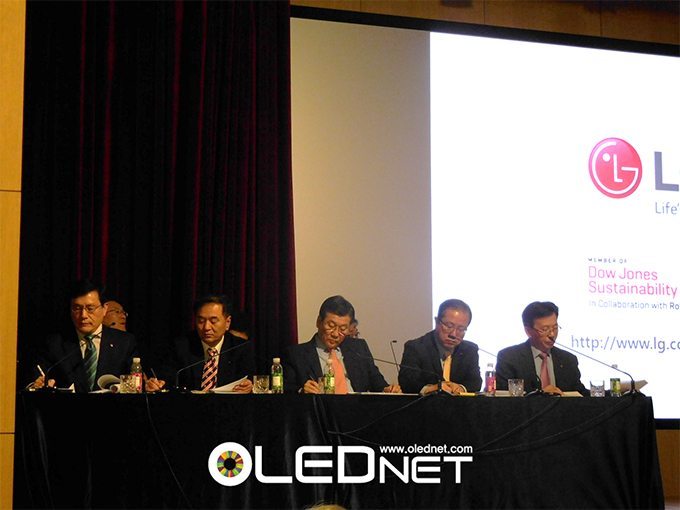
LG전자 실적 발표회
At present for flexible AMOLED encapsulation, thin film encapsulation, where organic and inorganic thin films are laminated, and hybrid encapsulation, where minimum passivation and gas barrier film are laminated, are used in mass production. As large area AMOLED panel is being mass produced through bottom emission structure where the light is emitted toward substrate, metal foil utilizing hybrid encapsulation is used.
However, TFE method which is used in flexible AMOLED panel for mobile device employs expensive manufacturing equipment and increases the investment cost. It also increases the number of processes involved and reduces mass production efficiency. For these reasons, this method is not suitable for cost reduction. As large area requires high resolution and high brightness, top emission structured AMOLED panel is being developed. When top emission structure is used, transparent encapsulation is essential.
Following this trend, the necessity for next encapsulation is rising, and in particular, transparent gas barrier film encapsulation is receiving increasing amount of attention. The transparent gas barrier film that is used for the hybrid structure currently being applied in mass production has WVTR of 10-4g/m2day, which is less than encapsulation requirement of 10-6g/m2day. However, in R&D stage, the WVTR level reached to 10-6g/m2day, and encapsulation could be possible only with transparent gas barrier film. Research development regarding this is being actively carried out.
According to 2016 OLED Encapsulation Report, published by UBI Research, transparent gas barrier film encapsulation can reduce investment cost compared to TFE. As it can also be applied to large area top emission structure, high market growth can be anticipated with this encapsulation.
UBI Research analyzed that if transparent gas barrier film encapsulation is applied to the new large area line and mobile added from 2017, the transparent gas barrier film market could grow to record up to approximately US$ 700 million in 2020.

현재 flexible AMOLED의 encapsulation은 유기 박막과 무기 박막을 적층하는 thin film encapsulation과 최소한의 passivation과 gas barrier film을 laminating하는 hybrid encapsulation이 양산에 적용 중에 있다. 대면적 AMOLED panel은 빛이 기판방향으로 발광되는bottom emission 구조로 양산되고 있기 때문에 metal foil을 적용한 hybrid encapsulation이 적용되고 있다.
하지만 mobile용 flexible AMOLED panel 에 적용중인 TFE 방식은 고가의 장비들이 사용되어 투자비용이 높아지고 공정 수가 늘어나 양산 효율이 낮아지는 단점이 있어 cost 절감에 적합하지 않다. 대면적에서는 고해상도와 고휘도가 요구되어짐에 따라 top emission 구조의 AMOLED panel이 개발 중이며, top emission 구조 적용 시 투명한 encapsulation이 필수적이다.
이러한 트랜드에 따라 next encapsulation에 대한 필요성이 대두되고 있으며 특히 transparent gas barrier film encapsulation에 대한 관심이 높아지고 있다. 현재 양산 적용 중인 hybrid 구조에 적용되는 transparent gas barrier film은 encapsulation 요구조건인 10-6 g/m2day 의 WVTR보다 낮은 10-4 g/m2day의 WVTR 제품이 적용 중이지만 R&D 단계에서는 10-6 g/m2day WVTR 개발이 완료된 상황으로 transparent gas barrier film만으로 encapsulation이 가능해 질 수 있으며 이와 관련된 연구개발도 활발히 이루어 지고 있는 추세이다.
유비산업리서치에서 발간한 2016 OLED Encapsulation Report에 따르면 “Transparent gas barrier film encapsulation은 TFE보다 투자비용을 줄일 수 있으며 대면적 top emission 구조에도 적용 가능하여 높은 시장 성장이 기대되는 encapsulation이다.”라고 밝혔다.
유비산업리서치는 2017년 이후 추가되는 mobile과 대면적 신규라인에서 transparent gas barrier film을 적용한 encapsulation이 적용될 경우 transparent gas barrier film시장은 2020년 약 US$ 700 million 규모까지 성장 가능할 것으로 분석하였다.

During the Pioneer Technology Seminar to Overcome Display Industry Crisis (January 14) held in South Korea, Dr. Sung-Kyu Kim of Korea Institute of Science and Technology (KIST) discussed the current issues of glasses-free 3D display and technology development for commercialization. He also revealed related KIST research results.
At present, the 3D display applied to TV can be divided into FPR (film patterned retarder) method and SG (shutter glass) method. Both of these methods require 3D glasses. Regarding this, Kim revealed that the glasses using method could be the biggest factor in hindering the 3D display’s accessibility. Kim announced that glasses-free 3D display development is essential particularly for outdoor advertisement applications.
To increase the accessibility of 3D display, glasses-free 3D display related research, such as holographic and multiview 3D display technology, has long been carried out. Kim revealed that at present the multiview 3D technology is closest to glasses-free 3D display commercialization. He added that the key issue is how much the 4 problems (crosstalk development, quantization effects between viewpoints, reduced resolution, human factor) can be controlled.
In order to solve these problems, Kim applied technology that forms visual field of 4 or more views between eyes and provide same image information in the adjacent area. He emphasized that this was fused with technology that tracks the location of the observer and developed improved glasses-free 3D display. He added that prototype was shown in PyeongChang 2018 Olympics PR venue and Sangwolgok Station in South Korea.
Kim explained problems such as human factor occur for TV and monitor where observers watch for a long period of time and future of 3D display is not bright. However, in advertisement area where people can freely watch, it could be effectively applied. He revealed that he will focus on commercialization this year and expedite development.

The interest in quantum dot materials is increasing daily. In July 2015, Professor Changhee Lee of Seoul National University received Science Technology Person of the Month prize with technology that greatly improves QLED performance and lifetime. In CES 2016, with cadmium-less quantum dot applied SUHD TV, Samsung Electronics achieved UHD TV’s color standard BT.2020 and received much attention.
Regarding this interest, during the Pioneer Technology Seminar to Overcome Display Industry Crisis (January 14) held in South Korea, University of Seoul’s Professor Jeong Hoon Kwak reported that quantum dot technology is a material with plenty of potential from the long-term perspective.
Quantum dot materials can be used with blue LED to improve LCD color gamut. Two techniques are generally used; the edge type has quantum dot placed on the sides and for surface type the quantum dot film is attached in front of BLU. Most of TV makers, excluding Sony, are using surface type. Professor Kwak explained that quantum dot can achieve desired color by adjusting the size of the particles without changing the materials. Through this, he estimated that it could replace color filter.
As well as increasing the LCD color gamut, as quantum dot materials emit light when connected to electricity, much like organic light emitting materials, it is anticipated that they could be used to replace the emitting materials in OLED panel. Within the industry, this technology is called QLED or QD-LED (Quantum Dot Light Emitting Diode) technology. Professor Kwak emphasized that QLED has better color gamut than OLED and has a merit of good actualization of deep blue. As QLED is basically formed through solution process, he added that solution process pixel patterning technology has to be development and device lifetime also has to increase.
Professor Kwak explained that as there are not many places mass producing QLED materials at present, the cost is high. However, he emphasized that because the quantum dot materials have an advantage of being easy to synthesize, from long term perspective, they can be used at lower price than OLED.
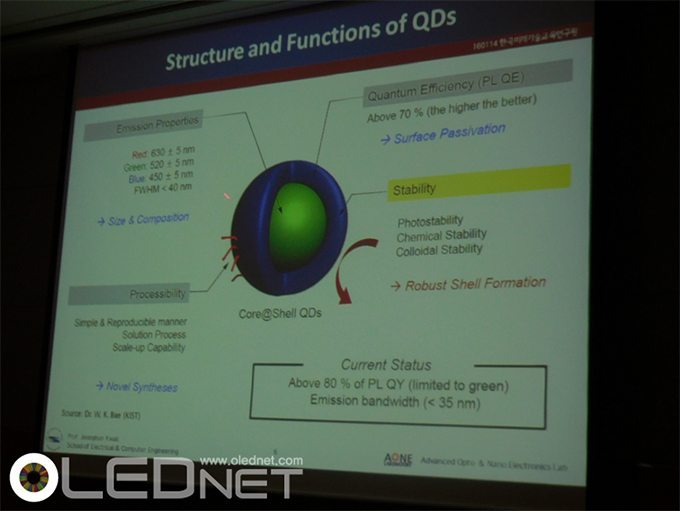
2016년 1월 14일 여의도 전경련 회관에서 개최된 ‘디스플레이 산업 위기극복을 위한 선도기술’ 세미나에서 KIST의 김성규 박사는 무안경 3D 디스플레이에 대한 현재의 이슈와 상용화를 위한 기술 개발에 대한 내용을 논하며 관련한 KIST의 연구성과도 함께 발표하였다.
현재 TV에 적용하는 3D 디스플레이는 FPR(편광필름패턴, Film Patterned Retarder) 방식과 SG(셔터글래스, Shutter Glass) 방식으로 나뉘며 두 가지 방식 모두 3D 안경이 필요하다. 이에 대해 김성규 박사는 안경을 사용한 방식은 3D 디스플레이의 접근성을 저해하는데 가장 큰 요소가 될 수 있다고 밝히며 특히 실외 광고에 활용하기 위해서는 무안경 방식 3D 디스플레이 개발이 필수적이라고 발표했다.
3D 디스플레이의 접근성을 높이기 위해 홀로그래픽과 다시점 3D 디스플레이 기술 등 무안경 3D 디스플레이와 관련된 연구가 오래 전부터 지속되어 왔다. 김성규 박사는 “현재로서는 다시점 3D 디스플레이 기술이 무안경 3D 디스플레이의 상용화에 가장 가깝다.”고 밝히며 “Crosstalk 발생과 시점간 양자화 현상, 해상도저하, human factor 등 4가지 문제점이 얼마나 컨트롤 되냐가 핵심이슈이다.”라고 발표했다.
김정규 박사는 이런 문제점을 해결하기 위해 양안 사이에 4시점 이상의 시역을 형성하고 인접시역에 동일영상 정보를 제공하는 기술을 적용하고 여기에 관찰자의 위치를 트래킹하는 기술과 접목하여 향상된 무안경 3D 디스플레이 개발했다고 강조하며 평창올림픽 홍보관과 지하철 상월곡 역에 시제품을 전시했다고 밝혔다.
김정규 박사는 “관찰자가 오래 시청하는 TV와 모니터에는 human factor와 같은 문제가 있기 때문에 3D 디스플레이 전망이 밝지 않지만 사람들이 자유롭게 볼 수 있는 광고 분야에는 효과적으로 적용할 수 있을 것으로 보인다.”고 밝히며 “올해는 상용화에 초점을 맞추어 개발에 박차를 가할 계획이다.” 라고 하며 발표를 마쳤다.

Quantum dot 소재에 대한 관심이 날로 높아지고 있다. 작년 7월 서울대학교 이창희 교수는 QLED의 성능과 수명을 획기적으로 높이는 기술로 이 달의 과학기술자 상을 수상하였으며, CES 2016에서 삼성전자는 카드뮴이 들어있지 않은 quantum dot를 채용한 제품인 SUHD TV를 통해 UHD TV의 표준 색영역인 BT.2020을 달성하며 큰 화제를 모았다.
이러한 관심에 대해, 14일 서울시립대 곽정훈 교수는 서울 여의도에서 열린 ‘디스플레이 산업 위기 극복을 위한 선도기술 세미나’에서 “Quantum dot 기술은 장기적인 관점에서 충분한 가능성을 가진 소재이다.”라고 전망했다.
Quantum dot 소재는 먼저 blue LED와 함께 쓰여 LCD의 색재현율을 높이는 데 활용될 수 있다. 이 때 quantum dot을 측면에 배치하는 edge형과 quantum dot 필름을 BLU앞에 붙이는 surface 유형이 대표적으로 소니를 제외한 대부분의 TV메이커는 surface 형을 택하고 있다. 곽정훈 교수는 “Quantum dot은 재료를 바꾸지 않고 입자 크기를 조절하는 것 만으로 원하는 색을 얻을 수 있다.”고 밝히며 “이러한 특성을 통해 color filter 대신 쓰일 수도 있을 것으로 전망된다.”고 발표했다.
LCD의 색재현율을 높이는 것 외에도 quantum dot 물질은 유기 발광물질과 같은 원리로 전기를 흘리면 발광하는 특성을 갖고 있기 때문에 OLED 패널의 발광재료를 대체하는데 쓰일 수 있을 것으로 기대되고 있다. 업계에선 이를 QLED 혹은 QD-LED(Quantum dot Light Emitting Diode) 기술이라고 부른다. 곽정훈 교수는 “QLED는 OLED보다 색재현율이 좋으며 특히 deep blue 표현력이 좋다는 장점을 가지고 있다.”고 강조하며 “QLED는 기본적으로 용액공정을 통해 형성되기 때문에 용액공정에 대한 픽셀 패터닝 기술이 개발되어야 하며 소자의 수명도 더 길어져야 한다.”고 밝혔다.
곽정훈 교수는 QLED 소재는 현재 대량 생산 하는 곳이 거의 없어 단가가 높게 형성되어 있지만 합성이 쉽다는 장점이 있기 때문에 장기적인 관점에서 OLED 보다 상대적으로 낮은 단가로 사용하는 것이 가능하다고 강조했다.

삼성전자가 인천 영종도에 위치한 BMW 드라이빙센터에 미래형 디스플레이로 각광받고 있는 투명 OLED 디스플레이 비디오월을 설치했다.
BMW 드라이빙센터는 지난 2014년 8월에 개장한 아시아 최초의 드라이빙센터로 BMW의 브랜드와 최신 제품은 물론, 다채로운 문화 체험을 즐길 수 있는 자동차 전문 복합 문화 공간이다.
삼성전자는 BMW 드라이빙센터의 하이라이트 공간에 55형 투명 OLED 디스플레이 제품을 실제 차량 크기 맞게 대형 비디오월로 구축해 차량 홍보 효과를 극대화 했다.
이번에 설치된 삼성전자 투명 OLED 디스플레이는 최근 CES 2016에서 처음 공개된 제품으로 45%의 투명도와 어도비 RGB를 100% 지원해 최고 수준의 색상 구현이 가능하다.
이를 통해 매장 방문객은 실제로 차량에 탑승하지 않아도 차량의 전장 제품에 대한 정보를 볼 수 있으며, 또한 실제로 차를 타는 듯한 현실감을 느낄 수 있다.
특히, 투명 OLED 디스플레이는 신차 공개와 같은 다양한 행사에서 실제 차량 디자인과 정보 노출이 동시에 가능하고, 혁신적인 차량 성능과 첨단 기능을 알리는데 더욱 효과적이다.
개장 당시 로비·전시관·체험관 등에 총 75대의 삼성 스마트 사이니지를 설치한 바 있는 BMW 드라이빙센터는 이번에 설치된 투명 OLED 디스플레이 비디오월을 통해 BMW의 플래그쉽 세단인 뉴 7 시리즈를 홍보할 예정이다.
삼성전자는 2019년까지 연평균 19%의 성장이 예상되는 상업용 디스플레이 시장에서 7년 연속 1위를 지키고 있으며, 투명 OLED를 기반으로 미래의 매장 콘셉트에 최적화된 제품 개발을 지속 추진할 예정이다.
김석기 삼성전자 영상디스플레이사업부 전무는 “투명 OLED뿐만 아니라 고객이 원하는 혁신적인 제품을 지속 개발해 나갈 계획이다”며, “앞으로도 미래형 매장 환경에 부합한 다양한 제품을 선보일 수 있도록 노력하겠다”라고 말했다.
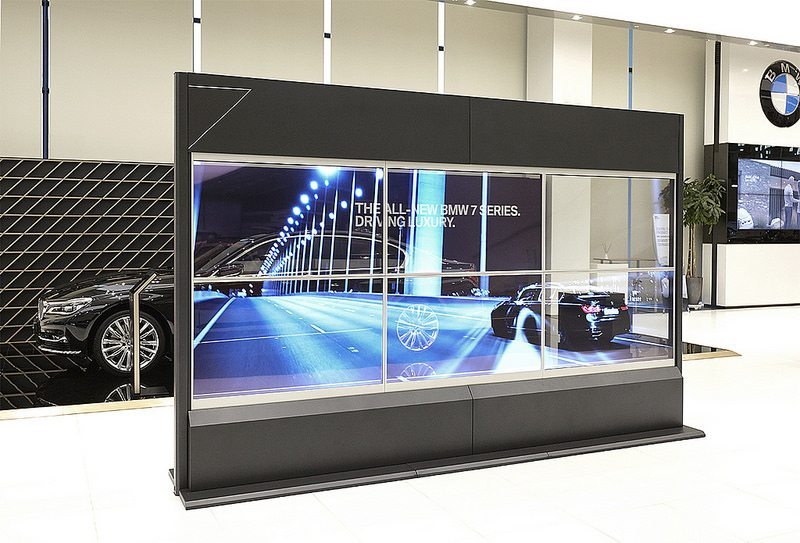
투명 OLED 디스플레이 비디오월 제품 사진, Source : 삼성전자
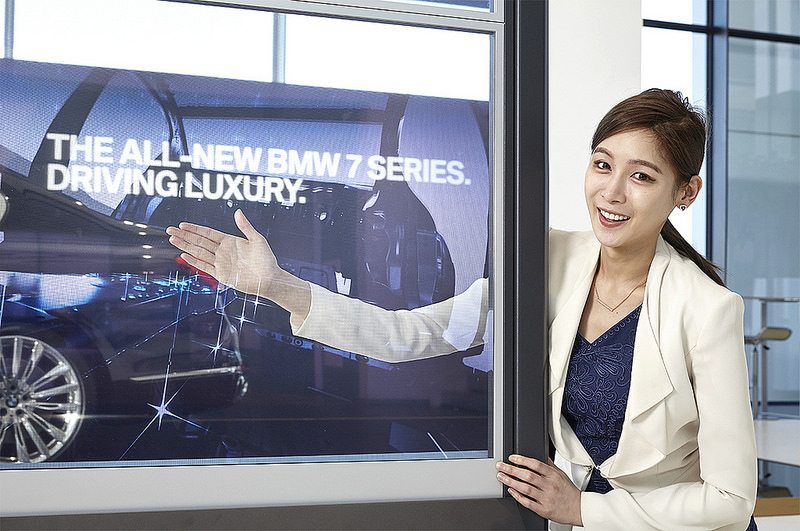
투명 OLED 디스플레이 비디오월 제품 사진, Source : 삼성전자
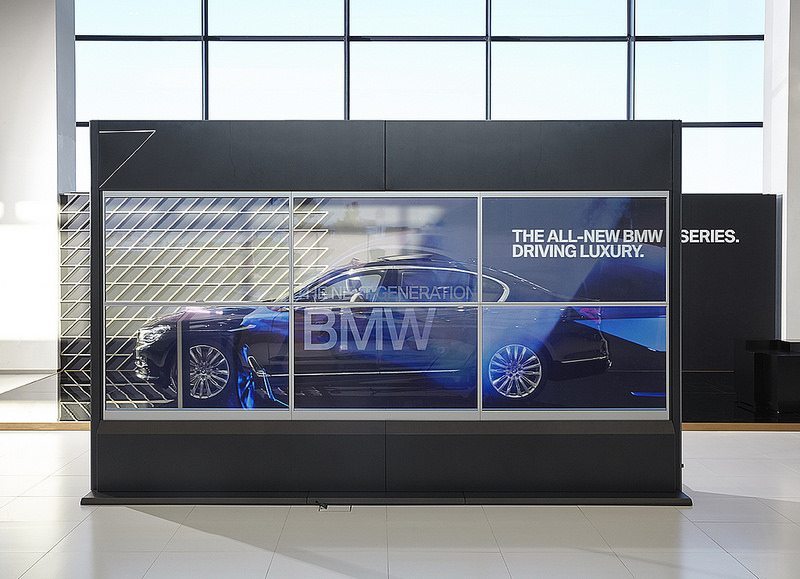
투명 OLED 디스플레이 비디오월 제품 사진, Source : 삼성전자
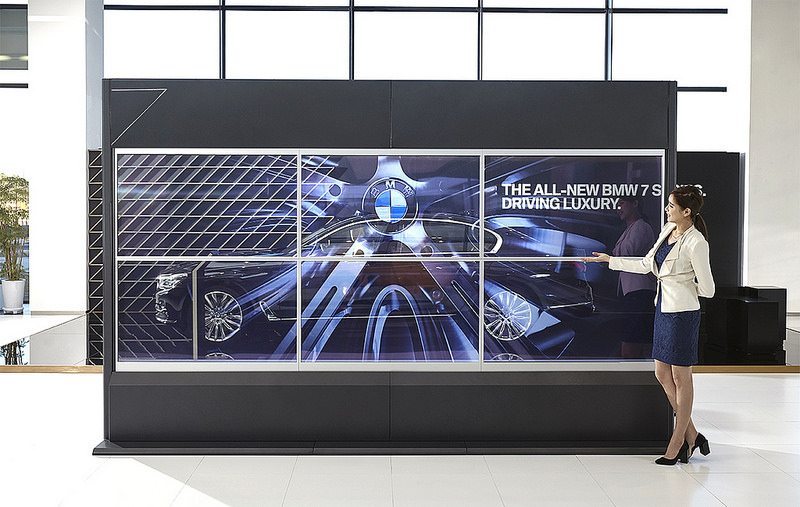
투명 OLED 디스플레이 비디오월 제품 사진, Source : 삼성전자
Samsung은 두 개의 패널을 이용해 여러 방향으로 디스플레이 구현이 가능하도록 전시하였으며 미래의 디스플레이 방향을 제시했다
Samsung은 여러 개의 패널들을 움직이면서 다양한 크기의 정보를 표현할 수 있는 modular display를 전시하였다.
Panasonic은 micro LED를 이용한 투명 디스플레이를 책장에 연결하여 디자인, 교육 등 새로운 application이 될 수 있음을 설명했다.
LG Elec.의 부스 중 55인치, 65인치, 77인치 OLED TV를 약 200여대 이용해 LG OLED TV의 real black 구현을 가장 잘 표현한 공간이었다.
LG Elec.이 55인치 curved OLED 패널을 세로면이 닿게 8개를 붙여 앞뒤로 4장씩 볼 수 있게 전시하였다.
LG Elec.은 77인치 4K OLED TV를 전시장 가운데에 두께를 강조하여 전시하였다.
LG Display는 55인치 curved OLED 패널을 세로면이 닿게 8개를 붙여 앞뒤로 4장씩 볼 수 있게 전시하였다
LG Display는 55인치 FHD 해상도의 광고용 투명 OLED 패널 안쪽에 상품을 진열하여 전시하였다.
LG Display가 차량용 디스플레이로 오목한 형태와 볼록한 형태를 전시하였으며, 12.3인치의 FHD 해상도이다.
In Lighting Japan 2016 (January 13-16) conference, Sumitomo Chemical and Merck revealed recently developed soluble OLED materials performance results.
The soluble OLED materials efficiency published in this conference reached ≥ 65% of UDC’s evaporation materials; particularly, Sumitomo Chemical’s red achieved ≥ 85%, and green reached ≥ 88% of UDC’s evaporation materials efficiency. Lifetime (LT 95) results were not as good as efficiency with red’s 25% and green’s approximately 40% (average).
Sumitomo Chemical and Merck both revealed that although in terms of efficiency the soluble materials almost caught up to evaporation materials, but lifetime requires further development.
Solution process is a method that allows for large area OLED panel production in RGB method using ≥ Gen8 manufacturing equipment. Key panel companies are actively carrying out research development, and the performance of soluble OLED material is considered the biggest issue. According to Solution Process OLED Report 2015, published by UBI Research, when solution process is applied the material cost can be approximately 40% reduced compared to the current evaporation process using large area OLED panel. The timing for the solution process application to mass production is expected to be decided depending on the development speed of soluble OLED materials.

OLED Materials Performance Comparison
Innovation Center for Organic Electronics in Yamagata University in Japan discussed low cost flexible OLED encapsulation in Lighting Japan 2016 conference. Existing flexible OLED encapsulation mainly used hybrid encapsulation structure that forms multi-layer thin film passivation layers on top of OLED, and then applying adhesive organic material and laminating gas barrier film. The encapsulation structure presented by Yamagata University forms, of the hybrid encapsulation structure, thermoset resin and barrier film above OLED without multi-layer thin film passivation, and laminate at approximately 130 °C. Yamagata University announced that they were successful in transparent flexible OLED panel development on January 13 using encapsulation, and that this panel will be presented in Printable Electronics 2016 in Tokyo from January 27.
The OLED panel to be exhibited is a leaf shaped of 45 mm width, 110 mm length, weighs less than 1.2g, and 250 um thick transparent film substrate that can be folded.
According to Yamagata University, if the newly developed encapsulation is applied, the OLED lighting panel price can be reduced as passivation layer is not used. Also, Yamagata University revealed as it can satisfy both transparent and flexible categories simultaneously, it is estimated that it will become a key technology in future transparent flexible OLED lighting development.
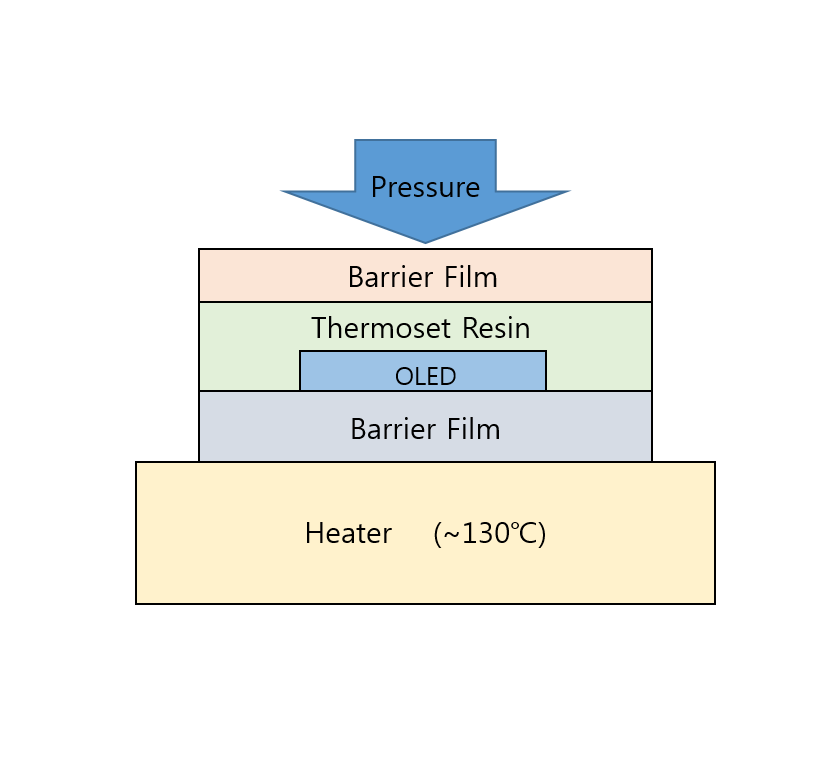
Low Cost Flexible OLED Encapsulation, Yamagata University
Samsung은 반사율이 높은 mirror display를 전시하면서 사람들의 이목을 끌었다.
LG Elec.은 press conference를 열어 초프리미엄 제품군 LG시그니처를 소개하고 그 중 OLED TV의 우수성을 강조하였다.
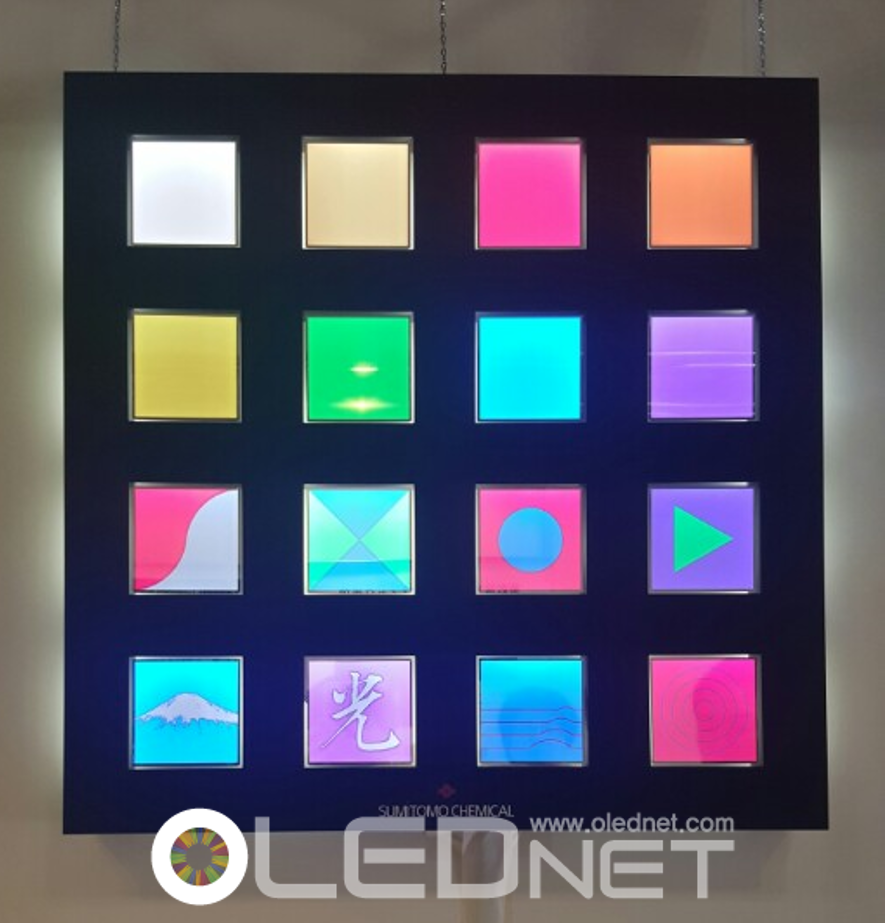
Sumitomo Chemical’s Decorative P-LED Lighting Panel, Lighting Japan 2016
Sumitomo Chemical revealed that they are planning to enter the general lighting market with solution process applied P-LED (polymer OLED).
Sumitomo Chemical is a company developing polymer and solution process applied OLED lighting panel. The company began actively selling decorative OLED lighting panel from H2 2015.
In Lighting Japan 2016 exhibition, Sumitomo Chemical announced that through their polymer materials and process technology, 80-90% of evaporation materials efficiency, and lifetime of approximately 20,000 hours at white 60-80 lm/w have been achieved. From 2017, they are planning to commercialize solution process OLED lighting panel as general lighting, as well as for decorative use, and revealed that the biggest issues are cost and improvement of consumers’ OLED awareness.
According to these issues, Sumitomo Chemical explained that although the cost of emitting area formed through solution process, cost down of evaporation formed emitting area and electrode part is required further. Although the 20,000 hours of lifetime is satisfactory, as consumers are aware that LED lighting’s lifetime is 40,000 hours or longer, Sumitomo Chemical pointed out it is important to change consumer’s OLED lighting awareness and understanding of lighting products.
by Moojong Lim, reporter@olednet.com
13일부터 일본 도쿄 빅사이트에서 개최된 Lighting Japan 2016 conference에서 Sumitomo Chemical과 Merck가 최근 개발된 soluble OLED material의 성능을 공개했다.
Sumitomo Chemical은 polymer 기반의 soluble OLED material을, Merck는 small molecule 기반의 soluble OLED material을 개발 중에 있다.
이번 conference에서 발표된 soluble OLED material의 효율은 UDC의 증착재료 대비 red는 65% 이상 특히 Sumitomo Chemical의 red는 85% 이상을 달성하였으며, green은 UDC의 증착재료 대비 88% 이상의 효율을 달성한 것으로 나타났다. 수명은 LT 95에서 red는 25%, green은 약 40%(평균수치) 수준으로 효율에 비해 부족하게 나타났다.
Sumitomo Chemical과 Merck에서 말하는 공통적인 이슈는 LT 95 확보로 효율측면에서는 증착재료를 많이 따라잡았지만 수명에서 개발이 더 필요하다고 밝혔다.
Solution process는 Gen8 이상의 장비에서 대면적 OLED panel을 RGB 방식으로 생산할 수 있는 공정으로서 주요 panel 업체에서 연구 개발을 적극적으로 진행 중에 있으며, soluble OLED material의 성능이 가장 큰 이슈로 뽑히고 있다. UBI Research에서 발간한 “Solution Process OLED Report 2015”에 따르면 solution process 적용시 증착 process보다 material cost를 현재의 대면적 OLED panel보다 약 40% 절감할 수 있다고 분석하고 있으며 soluble OLED material의 개발 속도에 따라 solution process 공정이 양산에 적용되는 시기가 결정될 것으로 전망된다.
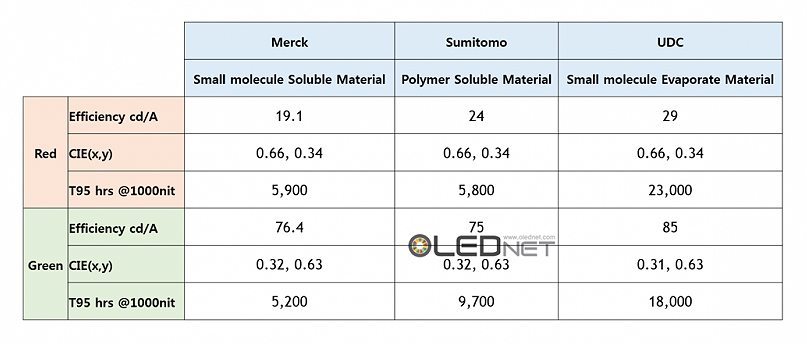
OLED 재료 성능 비교표
일본 야마가타 대학에 있는 유기 전자 혁신 센터의 OLED 그룹은 Lighting Japan 2016의 conference에서 저비용 flexible OLED용 encapsulation에 대해 발표하였다. 기존 flexible OLED의 encapsulation은 OLED위에 한층 이상의 다층 박막 passivation layers를 형성한 후 adhesive organic material을 도포하고 gas barrier film을 laminating 하는 하이브리드 encapsulation 구조가 주로 사용되었었다. 이번에 야마가타 대학에서 발표한 encapsulation 구조는 하이브리드 encapsulation 구조에서 다층 박막 passivation 없이 thermoset resin과 barrier film을 OLED 위에 형성한 후 약 130도의 온도로 합착한다. 야마가타 대학은 encapsulation을 사용하여 지난 13일 ‘투명 플렉시블 OLED 패널’ 개발 및 프로토 타입에 성공했다고 발표 했으며, 이 패널은 27일부터 도쿄 빅사이트에서 열리는 ‘인쇄 전자 전시회 2016’에서 전시할 계획이라고 밝혔다.
전시될 OLED 패널은 폭 45mm, 길이 110mm의 나뭇잎 형태로 무게는 1.2g보다 가벼우며, 두께는 250um의 투명한 필름 기판으로 접을 수 있다.
야마가타 대학에 따르면, 새로 개발한 encapsulation을 적용하면 passivation layer를 사용하지 않아 OLED lighting panel의 가격을 낮출 수 있으며 투명과 플렉시블을 동시에 충족시킬 수 있기 떄문에 앞으로의 투명 플렉시블 OLED lighting 개발에 핵심 기술이 될 것으로 예상한다라고 밝혔다.
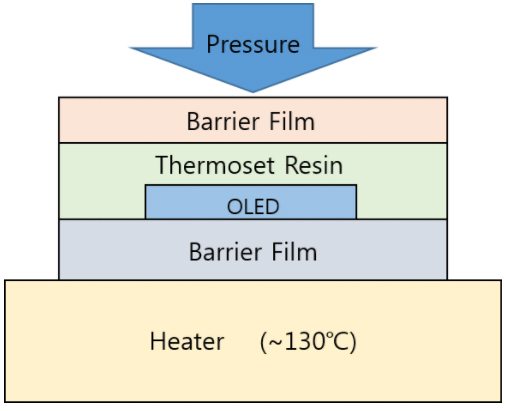
저비용 flexible OLED용 encapsulation, 야마가타 대학
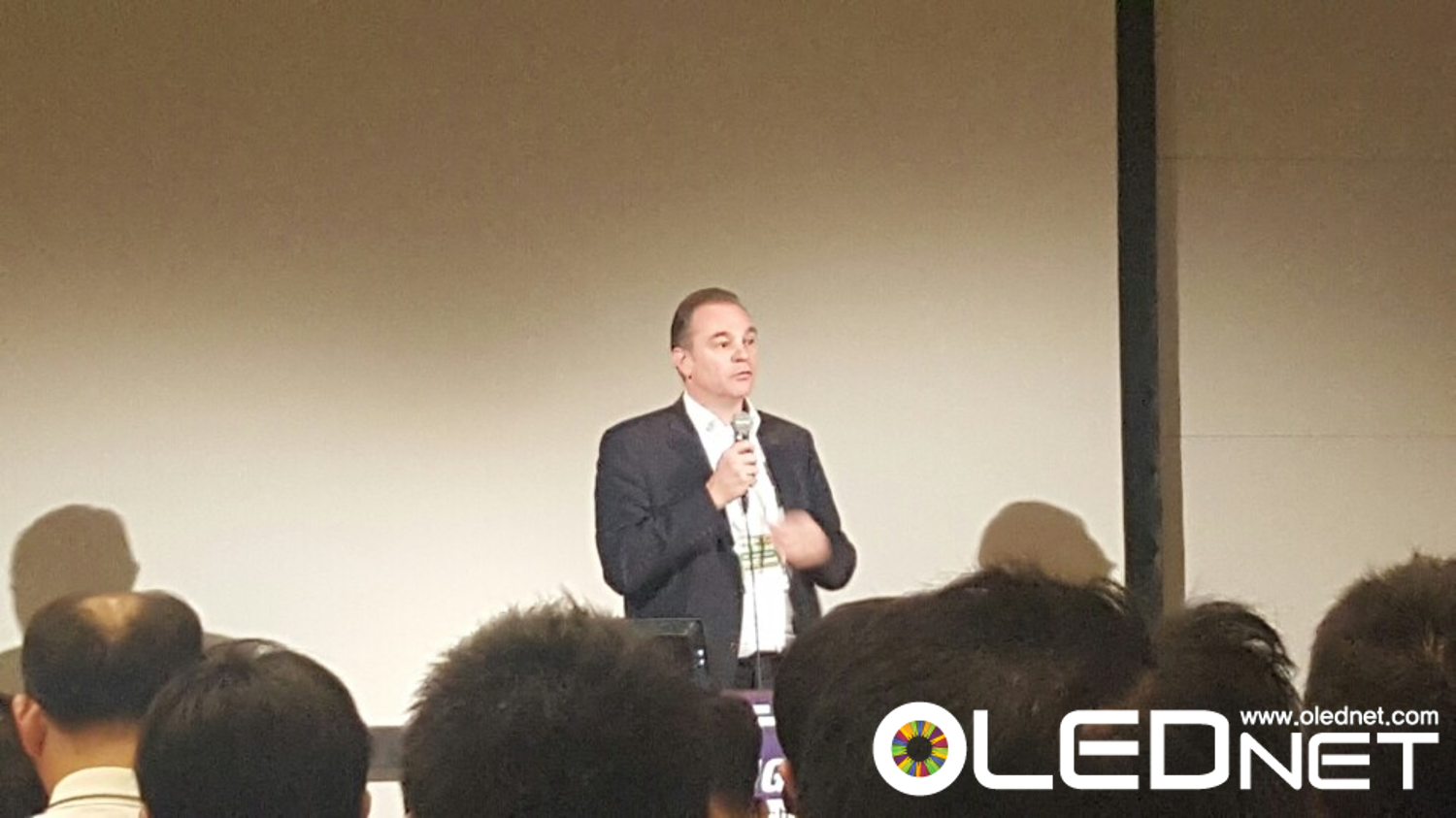
Osram Bussiness Unit Digital Systems’s CEO, Geert van der Meer, Lighting Japan 2016
In Lighting Japan 2016 Keynote Session, Geer van der Meer, CEO of Osram Business Unit Digital Systems, suggested directions for future lighting industry.
Geert van der Meer explained that the current lighting market is rapidly adopting LED, but the large volume of Chinese products is decreasing the price of LED source and device quickly. He emphasized that with the trend of disappearance of lighting companies’ profit, new business format is required to create profit.
The new businesses suggested by Osram are embedded lighting, and connected and smart lighting. He suggested lighting industry should move toward where the lighting can be used as part of building materials through internal installations and utilization as indirect illumination, and adopt smart system and form smart building and furthermore, smart city.
The current lighting market’s players are being joined by IT related companies, BMS (business management system) companies, and electronic appliances companies, and its megatrend is changing rapidly. Accordingly, Osram is expanding from the existing lighting to lighting electronics such as module and control gears, lighting solution system, and specialty lighting such as OLED and automotive. Osram also revealed that they took over a wireless energy management system company called ENCELIUM and intensifying focus on smart lighting system business.
Smart system provides many different functions such as energy reporting, remote and preventative maintenance, personal lighting control, and zone analysis among others and can optimize energy reduction, maintenance cost reduction, and workspace environment. Van der Meer emphasized that new function can be created through lighting used area’s data analysis and become the focus of future lighting analysis.
Choong Hoon Yi, Chief Analyst, UBI Research
When Samsung Electronics, CES’ most important company, holds a press conference, members of the media wait longer than an hour anticipating the new world the firm will show. For LG Electronics’ press conference, the waiting period is relatively shorter.
However, the press conferences at CES 2016 were not as anticipated. In CES and IFA, the representative of electronic appliances companies is TV. However, the TV in Samsung Electronics’ event was merely the same SUHD TV as shown before. Instead, ICT area, such as VR, USB adaptor, and Samsung Pay, was emphasized. During the last year’s CES, Samsung Electronics received much acclaim with curved design added SUHD TV. The only difference for this year’s TV from CES 2015’s was the text ‘Quantum Dot Display’ underneath the SUHD.
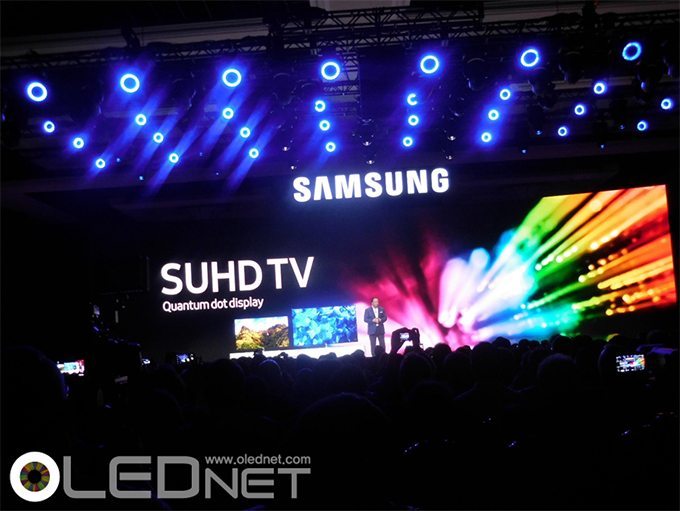
Samsung Electronics is considered the rule maker of the market with new designs and aggressive marketing. The fact that Samsung Electronics only added the words quantum dot to the already applied SUHD TV LCD panel is analyzed to be a desperate measure demonstrating the LCD TV’s development limitation.
On the other hand, during their press conference, LG Electronics provided a vision where the TV market can have another growth spurt through the introduction of the improved OLED TV with 800 nit peak brightness. Particularly, NASA’s video of vivid deep black of the space and dynamic fiery red of the sun on the OLED TV brought the audiences to cheer and applause. What could only have been seen by astronauts can now be seen by everyone through OLED TV. This was an event where everyone could feel what a true display really is.
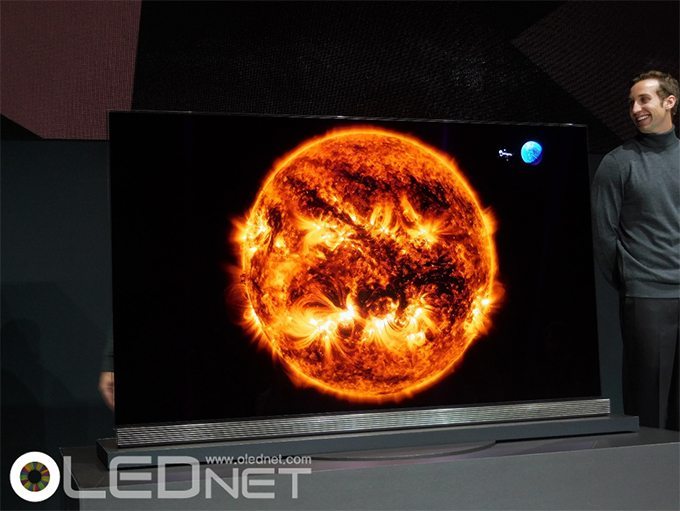
Of course, as the largest market of the consumer market is smartphone, it would be illogical to discuss Samsung Electronics and LG Electronics with only TV. However, Samsung Electronics’ smartphone business also remained stationery last year and all businesses, excluding semiconductor, is falling downward. As such, for Samsung fans who have high expectations it is of much concern.
The reason that the companies that led electronic appliance industry for the past half century such as Sony, Panasonic, and Toshiba are falling is because they did not have paradigm changing technology and product when the market was stalling. The same unfortunate sign is coming from Samsung Electronics.
Chinese set companies including TCL also brought quantum dot technology applied LCD TV to CES 2016. 8K TV was also exhibited. Although the picture quality control technology of the Chinese TV companies still falls short compared to companies such as Samsung Electronics, LC Electronics, and Sony, the set exterior reached similar standards and the price is less than 70% of the early starters’. The difference in the picture quality is difficult to distinguish for those who are not TV or display experts. The quality of Chinese products does not reflect the cheaper price, and cheap and good products are pouring in from China.
For Samsung Electronics that cannot produce OLED TV, in order to repeat the last year’s popularity in international events such as IFA in later this year, a big issue and product that can represent the company are urgently needed.
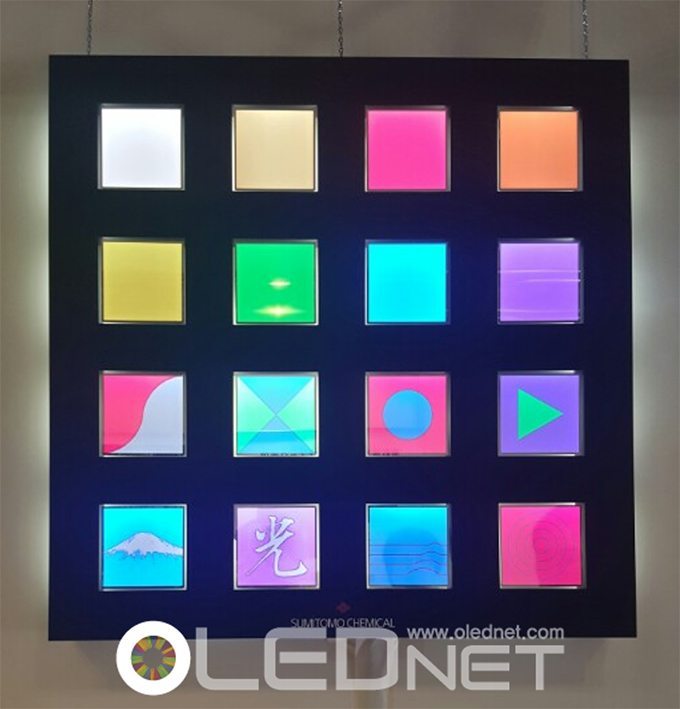
Sumitomo Chemical의 decoration용 P-LED lighting panel, Lighting Japan 2016
Sumitomo Chemical에서 solution process를 적용한 P-LED(Polymer OLED)로 일반 조명 시장에도 진입할 계획이 있다고 밝혔다.
Sumitomo Chemical은 polymer와 solution process,를 적용한 OLED lighting panel을 개발하고 있는 업체로서 2015년 하반기부터 데코레이션용 OLED lighting panel을 본격적으로 판매하기 시작하였다.
Lighting Japan 2016 전시장에서 Sumitomo Chemical 관계자는 “현재 Sumitomo Chemical이 보유하고 있는 polymer 재료와 공정기술로도 증착 재료 수준의 80~90%의 효율을 확보하였고 수명도 white 60~80lm/w 기준으로 약 20,000 시간 개발을 완료하였다. 2017년부터 데코레이션용 뿐만 아니라 일반조명으로 solution process OLED lighting panel을 상업화할 계획에 있으며 가장 큰 이슈는 cost와 소비자들의 OLED에 대한 인지도 향상이다.”라고 밝혔다.
이슈에 관련하여 “Solution process로 형성하는 발광층 부분은 cost가 저렴하지만 증착으로 형성하는 발광층과 전극부분의 cost down이 더욱 필요하며, 수명도 20,000시간이면 충분하지만 LED 조명의 수명이 40,000시간 이상으로 소비자들의 인식이 높아져있기 때문에 OLED lighting에 대한 소비자들의 인지도향상과 조명제품에 대한 인식을 변화시키는 것이 중요하다.”라고 하였다.
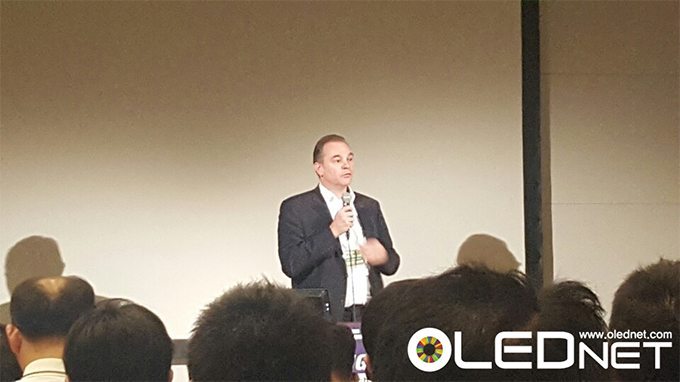
Osram Bussiness Unit Digital Systems의 CEO, Geert van der Meer, Lighting Japan 2016
Lighting Japan 2016의 keynote session에서 Osram Bussiness Unit Digital Systems의 CEO인 Geert van der Meer은 조명산업이 앞으로 나아가야 할 방향에 대해 제시하였다.
Geert van der Meer은 “현재 조명시장은 LED화가 급격하게 진행되고 있지만 중국업체들의 물량 공세에 LED source와 기구 가격이 급격히 하락하고 있어 조명 제조업체들의 이윤창출이 없어지고 있는 추세라며, 이윤을 창출하기 위한 새로운 비즈니스 형태가 필요하다.”라고 강조하였다.
Osram이 제시한 새로운 비즈니스는 embedded lighting과 connected and smart lighting으로 조명들을 내설하거나 간접조명으로의 활용을 통해 실내 인테리어와 같은 건축자재의 일부로 사용하고, smart system을 도입하여 smart building과 더 나아가 smart city를 구성하는 방향으로 나아가야 한다고 발표하였다.
현재 조명시장은 기존의 조명업체 뿐만아니라 IT관련업체와 BMS(Business Management System)업체, 가전업체들까지 가세하고 있는 추세여서 조명산업의 Megatrend가 빠르게 변하고 있다. 이에 따라 Osram 기존 조명에서 탈바꿈하여 모듈과 control gears와 같은 조명용 electronics와, Lighting solution system, OLED와 automotive와 같은 specialty lighting등으로 사업확장을 진행 중이며, 특히 ENCELIUM이라는 wireless energy management system 업체를 인수하여 smart lighting system 사업을 집중적으로 강화하고 있다고 밝혔다.
이러한 smart system은 energy reporting과 remote and preventive maintenance, personal lighting control, zone analysis 등이 가능하게 되어 energy절감과 유지비용 감소, workspace환경 최적화를 할 수 있으며 특히 zone analysis는 조명이 사용된 공간의 데이터분석을 통해 새로운 용도를 창출 가능하여 앞으로의 조명산업의 핵심이 될 것이라고 강조하였다.
이충훈/Chef Analyst, UBI Research
CES의 가장 중요한 업체인 삼성전자가 press conference를 할 때는 미디어들은 한 시간 이상을 줄 서서 기다리며 삼성전자 보여줄 새로운 세상을 기대한다. LG전자는 그다지 긴 줄이 아니기 때문에 대기 시간이 상대적으로 적다.
하지만 이번 CES2016 의 press conference는 모두의 기대치와 전혀 다르게 나타났다. CES와 IFA에서 가전 업체들의 얼굴 마담은 TV이다. 하지만 삼성전자의 행사에 보여진 TV는 이전과 똑 같은 SUHD로 끝나고 말았다. 대신에 VR과 USB Adaptor, Samsung Pay와 같은 ICT 분야가 부각되었다. CES2015에서는 curved design을 가미한 SUHD TV로서 환호성을 받았으나 달라진 점은 SUHD 글자 밑에 Quantum dot display라는 글자가 존재한 것뿐이었다.

새로운 디자인과 공격적인 마케팅으로 시장의 Rule Maker였던 삼성전자에서 이미 SUHD TV용 LCD 패널에 적용하고 있는 quantum dot이라는 용어만 덧 부쳐 나온 것은 LCD TV가 더 이상 좋아질 수 없음을 나타내는 고육지책인 것으로 분석 된다.
이에 비해 LG전자의 행사는 800nit peak brightness로 향상된 OLED TV가 등장 함으로서 TV 시장이 다시 한 번 성장할 수 있는 비전을 제시했다. 특히 NASA 촬영한 우주 속 태양의 깊은 black과 역동적인 태양의 붉은 색을 눈으로 보듯 생동감을 OLED TV로서 처음 접한 참관자들은 환호와 박수를 아끼지 않았다. 우주 비행사들만이 볼 수 있는 진정한 장면을 OLED TV로서 볼 수 있게 된 것이다. 진정한 디스플레이가 무엇임을 모두가 실감할 수 있는 자리였다.

물론 consumer market의 최대 시장은 smart phone이기 때문에 TV만 가지고서 삼성전자가 LG전자에 비해 이렇다 말하는 것은 어불성설이다. 하지만 삼성전자의 smart phone 사업 역시 작년에는 답보 상태에 머무르며 반도체를 제외한 전 사업이 하향 곡선을 거리고 있어 삼성전자에 기대치가 높은 수 많은 삼성 팬들은 우려가 심각하게 깊다.
실제로 지난 반세기 가전 산업을 이끌었던 Sony와 Panasonic, Toshiba 등이 모두 몰락의 길을 걷게 된 것은 시장이 정체되었을 때 패러다임을 바꿀 수 있는 기술과 제품이 없었기 때문이다. 이러한 나쁜 징조가 삼성전자에서 나타났다.
TCL을 비롯한 중국의 TV 세트 업체들 역시 모두 quantum dot 기술이 적용된 LCD TV를 CES2016에 들고 나왔다. 8K TV도 전시했다. 아직 중국 TV 업체들의 화질 컨트롤 기술이 삼성전자나 LG전자, Sony 등에 비해서는 부족한 것으로 보여지지만 세트 외관은 모두 대등한 수준에 도달했으며, 가격은 이들 선발 기업들의 70% 이하이다. TV나 디스플레이 전문가가 아니면 화질 차이를 구별하기 어렵다. “싼 것이 비지 떡”이 아니라 싸도 충분히 만족할 수 있는 좋은 제품들이 중국에서 홍수처럼 쏟아지고 있다.
OLED TV를 만들 수 없는 삼성전자가 하반기에 있을 IFA 등의 세계적인 행사에서 작년처럼 흥행을 유지하기 위해서는 확실한 얼굴 마담을 대체할 수 있는 초 대형 이슈와 제품이 시급하게 나와야 한다.
OLED panel, mostly used for Samsung Electronics, is expanding its market and slowly entering China. In CES and IFA until now, Samsung Electronics and LG Electronics only exhibited OLED panel equipped smartphone. However, this time, China’s dark horse Huawei exhibited Samsung Display’s OLED onto new smartphone model Nexus 6P.


The panel used is 5.7 inch 518 ppi FHD OLED.
According to Huawei, although until now LCD has been used as OLED can produce profound black it is estimated OLED will be highly popular in Chinese market.
Huawei is already using OLED on smartwatch. Huawei Watch Active that began to be exhibited starting with CES 2015 uses 1.4 inch 286 ppi OLED panel with 400 x 400 resolution supplied by AUO. The thickness of the watch is 4.2 mm and rather thick, but the external design is highly detailed and beautiful much like luxury analog watch.

As Huawei, which has the highest market share out of Chinese set companies, started to actively push for OLED panel use in smartphone following smartwatch, other Chinese companies, including Xiaomi, are expected to rapidly join the OLED sector.
삼성전자에 대부분 사용되던 OLED 패널이 이제는 시장을 넓혀 중국에도 조금씩 진출하기 시작했다. 이제까지의 CES와 IFA에서는 삼성전자와 LG전자만이 OLED 패널 탑재 smart phone을 전시하였으나, 이번에는 중국의 dark horse인 Huawei가 신형 smart phone nexus6P에 삼성디스플레이 OLED를 탑재하고 전시하였다.
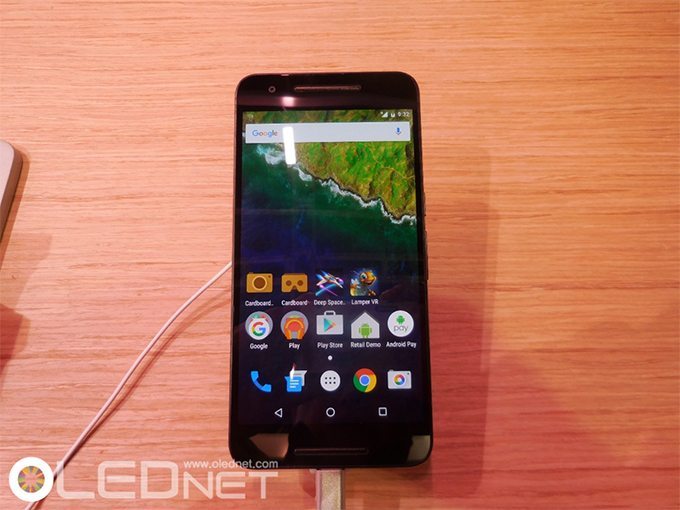
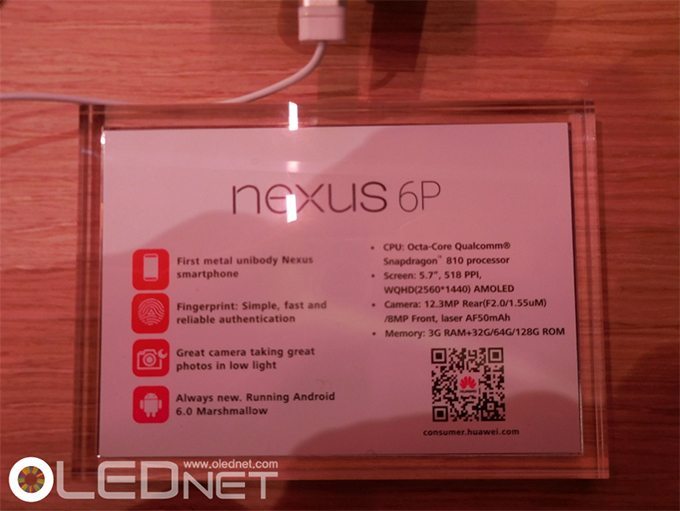
5.7인치 사이즈의 518ppi FHD OLED이다.
Huawei 관계자에 따르면 이전에는 LCD를 사용하여 왔으나 OLED는 심오한 black color를 제공하기 때문에 중국 시장에서 인기가 매우 높을 것으로 전망한다고 언급했다.
Huawei는 이미 smart watch에 OLED를 사용하고 있다. CES2015를 시작으로 전시장에 선을 보인 Huawei Watch Active는 400×400 해상도와 286ppi의 1.4인치 OLED 패널을 사용하고 있다. 패널 공급 업체는 AUO이다. 시계 두께는 4.2mm로서 다소 두꺼우나 외관 디자인은 고전적인 아날로그 방식의 고급 브랜드 시계처럼 매우 정교하고 아름답다.
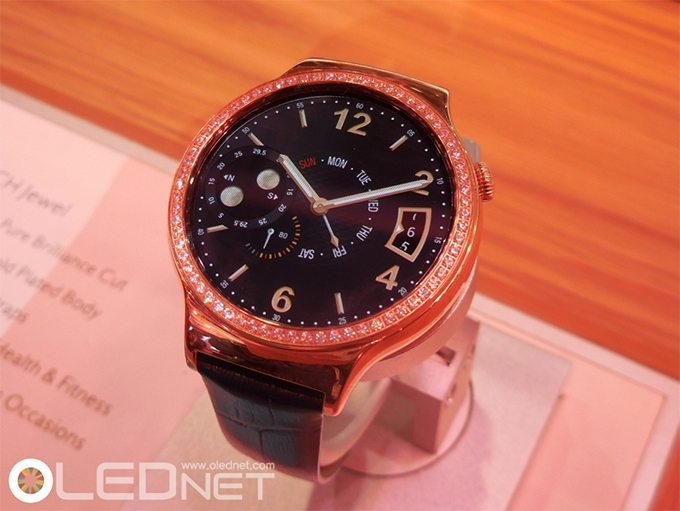
중국 세트 업체들 중에서 가장 시장점유율이 높은 Huawei가 smart watch에 이어 smart phone에서도 OLED 패널 사용을 적극적으로 추진하기 시작했기 때문에 Xiaomi를 비롯한 많은 중국 기업들 역시 OLED 진영에 빠르게 합류할 것으로 전망된다.
Skyworth, the most enthusiastic Chinses TV company, placed OLED TV on the front of the CES 2016 booth, the largest space.
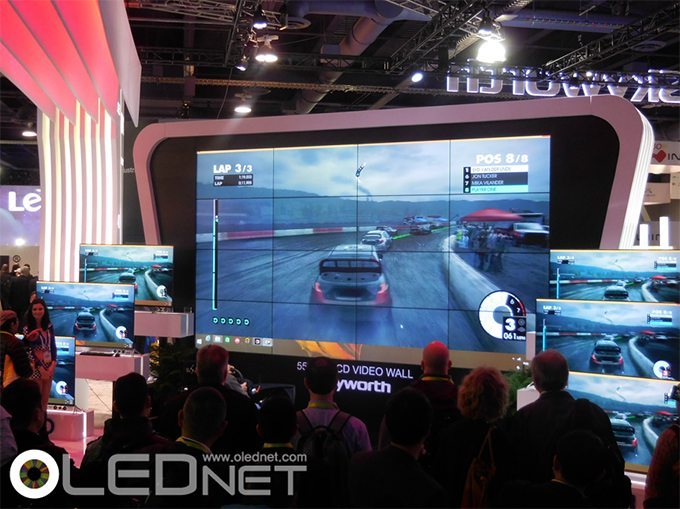
The exhibition concept, same as IFA 2015, was promotion of OLED TV’s superiority over LCD in terms of picture quality and fast response time through car racing game.
Furthermore, all OLED TVs exhibited this year are UHD resolution aiming for the premium TV market.
According to Skyworth, 2015 OLED TV sales performance is 45,000 units, with the target of 200,000 units in 2016. In 2015, the performance was weak as the OLED panel supply from LG Display was not smooth. However, compared to last year, in 2016 the panel supply from LG Display increased, and as OLED TV is a very popular product in Chinese market due to its superior picture quality compared to LCD the sales target of 2016 became much higher.
What is different about this exhibition is the fact that the video clip used in the Skyworth OLED TV booth is the same as the NASA video produced by LG Electronics for promotion. Previously, each companies presenting OLED TV used different contents on the screen. However, in this exhibition, by showing the same video of the sun within the space, they emphasized OLED TV’s superiority in contrast ratio and picture quality of black.
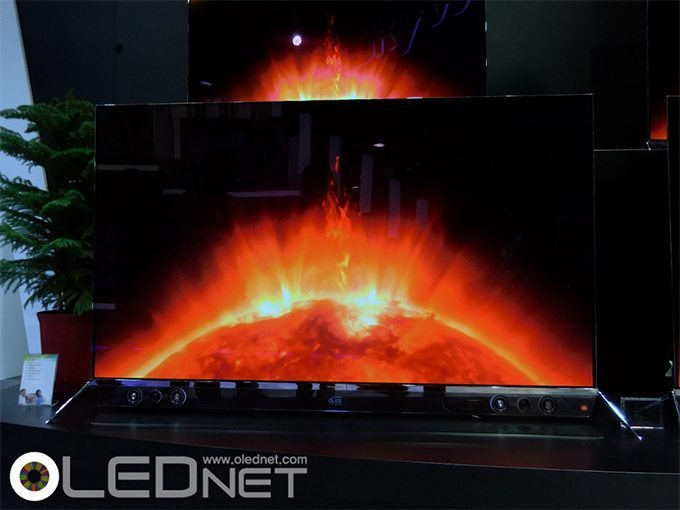
This is considered LG’s ecosystem strategy to secure OLED TV territory by sharing the video contents and increasing the consumers and attendees’ OLED TV awareness.
중국 TV 업체들 중 OLED TV 사업에 가장 적극적인 Skyworth는 CES2016 부스 전면에 그리고 가장 넓은 공간에 OLED TV를 배치하고 홍보에 나섰다.

전시 컨셉은 지난 IFA2015와 동일하였으며 LCD 대비 우수한 OLED TV의 화질과 빠른 response time을 자동차 레이싱 게임을 통해 홍보하였다.
이번 전시회에 출품된 OLED TV는 모두 UHD급으로서 premium TV 시장을 노린 전략으로 보인다.
Skyworth 관계자에 따르면 2015년 OLED TV 판매 실적은 45,000대 규모이며, 2016년 목표는 20만대라고 언급했다. 작년에는 LG디스플레이로부터 OLED 패널 공급이 원활하지 않아 실적이 낮았으나 올해는 작년에 비해 LG디스플레이로부터 패널 공급이 늘어났고 중국 시장에서 OLED가 LCD TV에 비해 화질이 우수하다는 점이 알려지면서 인기가 높아지고 있기 때문에 올해는 목표를 대폭 올렸다.
이번 전시회가 다른 전시회에 비해 차별화된 점은 Skyworth 부스에 전시된 OLED TV의 동영상이 LG전자가 홍보용으로 제작한 NASA의 영상을 같이 사용하고 있는 점이다. 이전에는 OLED TV를 전시하는 회사마다 서로 다른 컨텐츠를 사용하여 왔으나, 이번 전시회에는 우주 공간 속의 태양을 촬영한 영상을 동일하게 보여 줌으로서 OLED TV의 contrast ratio와 black 화질이 우수함을 강조하고 있다.

영상을 공유함으로써 고객과 참관자들의 OLED TV에 대한 인지도를 동시에 끌어 올리고 OLED TV 진영을 확보하기 위한 LG의 ecosystem 전략으로 분석된다.
On January 6 (local time), LG Display held a press conference with key board members in attendance including CEO Sang-Beom Han, CTO In-Byeong Kang, and head of marketing Young-Kwon Song.
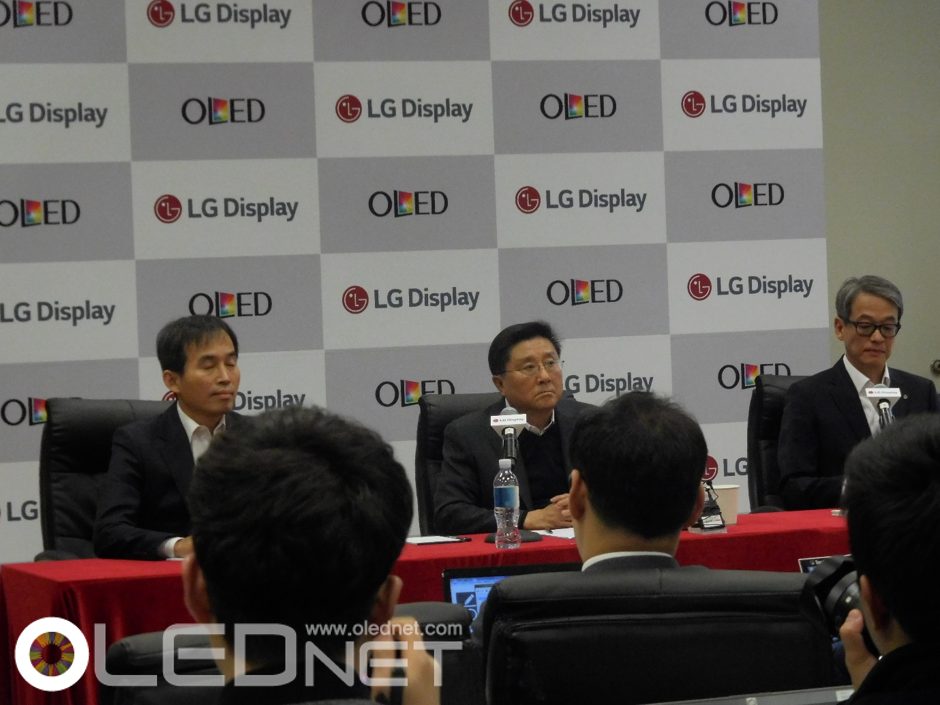
At this conference, unlike previously, Han conveyed strong determination and announced LG Display will invest in future large area display with OLED. This was a conviction never seen before.
The evidence of the confidence could be read at the exclusive exhibition. OLED TV achieved 800 nit, 150% higher than UHD Alliance’s standard of 540 nit.
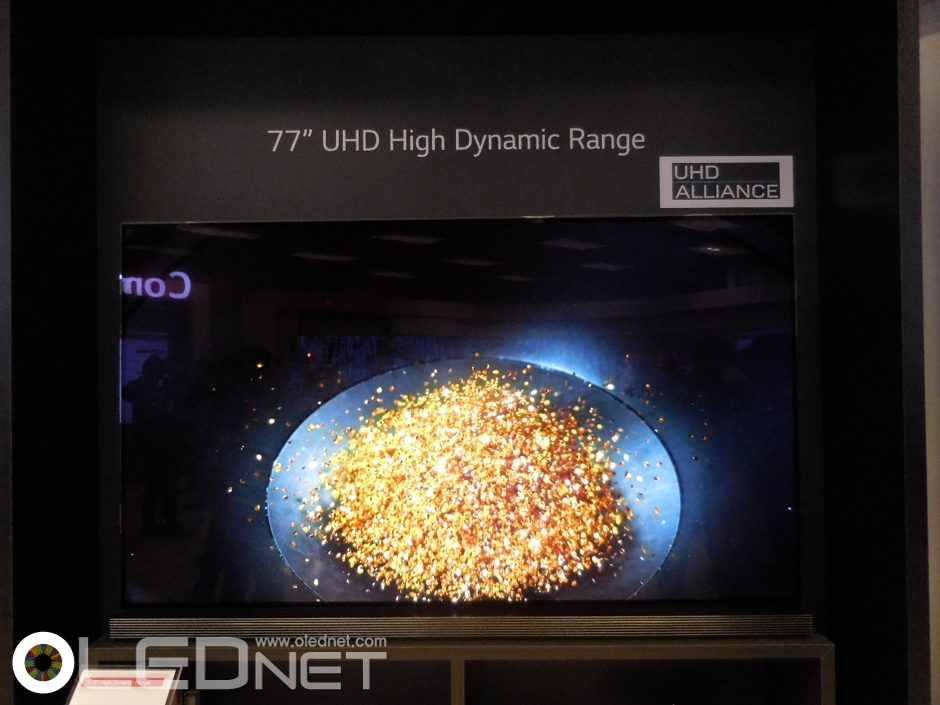
With transparent OLED, LG Display reached leading specs. The WRGB OLED structured transparent OLED has 40% transmittance and 600 nit of brightness through the application of the 800 nit OLED technology.
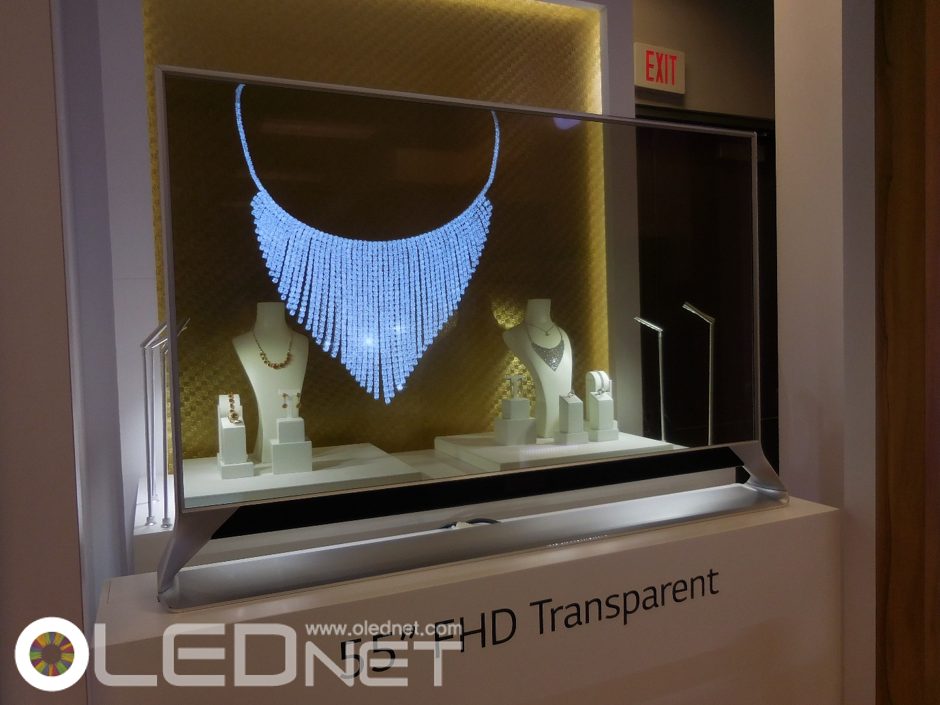
Flexible OLED also was significantly different from last year. In 2015, the comparison between LG’s OLED and LCD for automotive dashboard display showed OLED to be lacking in brightness. However, this year’s exhibition showed OLED panel to have similar level of brightness as LCD and exceeding LCD’s spec with deeper black.
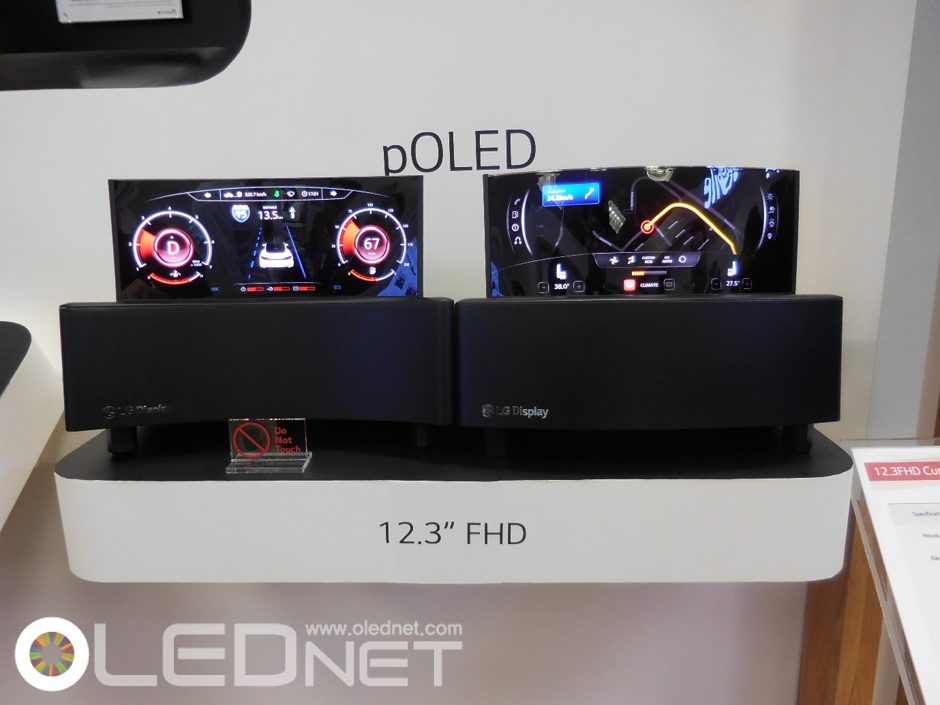
The exhibition showed rapid development of LG Display’s OLED technology.
LG 디스플레이는 한상범 부회장과 CTO 강인병 전무, 전략마케팅 송영권 전무등 주요 경영진이 참석한 가운데 기자 간담회를 개최했다.
이번 기자 간담회는 이전과 달리 한 부회장은 매우 강한 의지를 표명했다. “LG디스플레이는 향후 대면적 디스플레이는 OLED로 투자합니다!” 이제까지 본적 없는 소신이었다.
한 부회장의 자신감은 특별 전시장에서 읽을 수 있었다. OLED TV는 800nit를 달성했다. UHD Alliance 규격의 540nit 보다 이미 150%를 초과 달성했다.

투명 OLED에서는 챔피언 스펙을 달성했다. WRGB OLED 구조를 적용한 투명 OLED는 40% 투과율에 휘도는 600nit 이다. 800nit OLED 기술을 적용했기 때문이다.

Flexible OLED도 작년과는 매우 달랐다. 작년에 LG가 전시한 자동차 dashboard용 OLED와 LCD를비교하면 휘도가 부족한 단점이 보였지만 이번 전시장의 OLED 패널은 LCD와 휘도가 동등 수준이며 깊은 black으로서 LCD의 spec을 능가했다.

LG디스플레이의 OLED 기술이 급 진전하고 있음을 보여주었다.
Following the mobile and large area panel markets, OLED is now actively entering the monitor market.
Until now, the monitor and notebook markets were mostly occupied by LCD. Burn-in effects and power consumption were the biggest reasons that prevented OLED panels from being applied to monitor and notebook. Generally, monitor and notebook are for office use. Within the office environment, window’s task bars and icons on the main screen are fixed. Also, as the average hours of use is much higher than TV or mobile, burn-in effects is an issue. Also as Office programs or internet browsers, which usually have white background, are used heavily, power consumption is high as OLED panel of RGB method has to drive all subpixels in order to actualize white.
Starting with the black and white OLED monitor in 2012, Sony steadily developed/mass produced OLED monitor. However, it is analyzed the application was possible as this OLED monitor was mostly used for medical and broadcasting uses and in different settings from the office monitor environment.
However, with Lenovo and HP’s announcements of OLED Notebook release, the status is changing.
In January 2016, Lenovo announced world’s first OLED notebook ‘X1 Yoga’ with 14 inch AMOLED panel with 2550×1440 resolution. Following this, HP also announced the release of 13.3 inch OLED hybrid laptop/tablet ‘Specter X360’ with 2560×1600 resolution.
These OLED panel equipped notebook releases break the existing perception that OLED panel is not suitable for monitor and notebook, and can be considered that OLED panel’s lifetime and power consumption have been achieved to be suitable for monitor and notebook. As such, much attention is on whether the OLED market will be able to greatly expand in the monitor and notebook markets following their success in mobile and TV markets.

Lenovo’s ‘X1 Yoga’ (left), HP’s ‘Specter X360 hybrid laptop/tablet’ (right), Source : Lenovo, HP
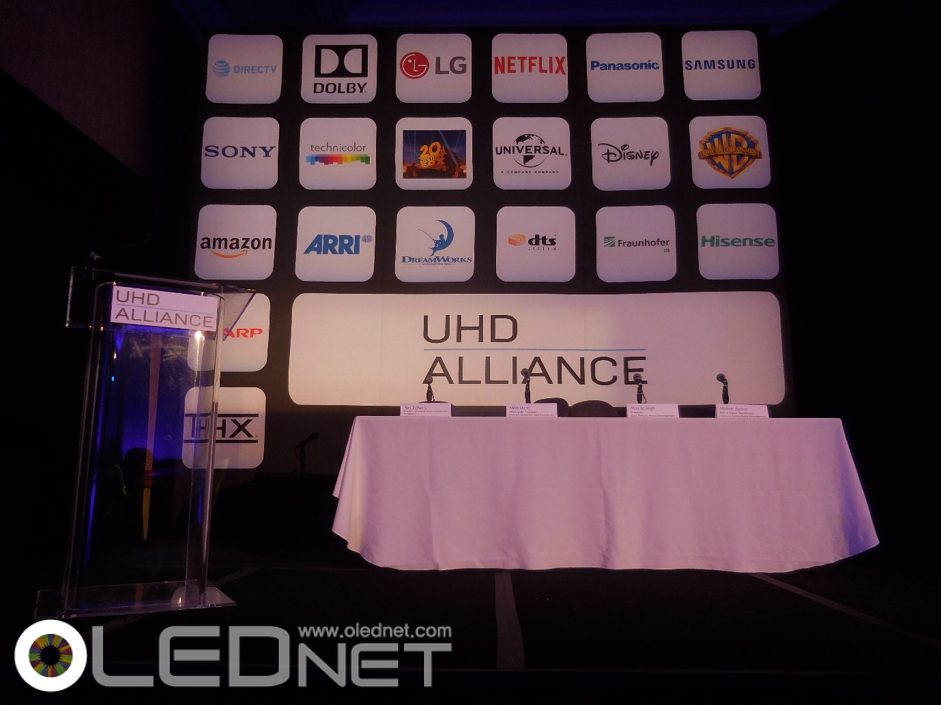
As a press event of CES 2016 (January 6-9), UHD Alliance, which was created by TV manufacturing companies, contents companies such as film studios, and picture and sound quality related companies to energize the declining TV market, gave a presentation on future UHD TV market and UHD Alliance activities.
The TV market recorded approximately 230 million units in 2015. However, this is 20 million units fewer than 2014’s 250 million, and CES reported that 2016 performance will be similar to 2015. 2016’s estimated UHD TV market, which is the premium market of 55 inch or larger, is 21% of the total TV market with approximately 48 million units.
The 4 key factors that UHD Alliance is pursuing in UHD TV are image resolution, color bit depth, color palate, and high dynamic range.
LCD TV and OLED TV that satisfy these factors are to be available from this year. In order to respond to OLED’s vivid color realization, LCD TV companies developed quantum technology. Also to draw near OLED’s contrast ratio of 1,000,000:1 they are continuing technology development, but the LCD contrast ratio remains around 3,000:1.
It is worth noting that UHD Alliance provided 2 HDR specs: more than 1,000 nits peak brightness at less than 0.05 nits black level, or 540 nits brightness with 0.0005 black level.
LG Electronics already achieved UHD Alliance’s HDR spec of 540 nit peak brightness last year, and this is analyzed to provide foundation for more invigorated future OLED TV market. Based on this, OLED TV is expected to be the main force within the UHD TV market.
Additionally, UBI Research estimated that 2016 OLED TV market will record 1,200,000 units.
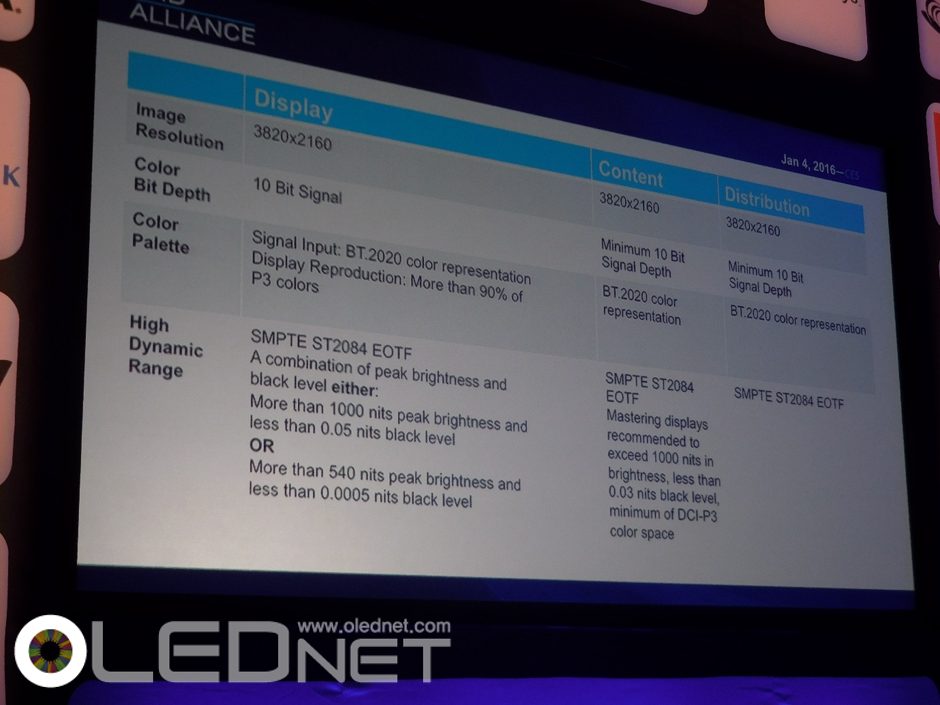

CES2016 프레스 이벤트로, 수축되어 가는 TV 시장에 활력을 불어넣기 위해 TV 제조 업체 들과 영화사 등의 콘텐츠 업체, 화질과 음질 관련 업체들이 모인, UHD Alliance에서 향후 UHD TV 시장과 UHD Alliance의 활용 내용에 대해 발표를 했다.
TV 시장은 2015년에 약 2억3천만대의 시장을 형성하였으나 2014년 2억5천만대에 비하면 2천만대가 감소하였으며, 2016년 역시 작년과 동일한 수준이 될 것으로 CES 관계자가 언급했다. 2016년 예상 55인치 이상 크기의 premium 시장인 UHD TV 시장은 전체 TV시장의 21%인 약 48백만대이다.
UHD Alliance가 추구하는 UHD TV의 주요 사양으로서는 image resolution과 color bit depth, color palate, high dynamic range 4개 요소이다.
이러한 사양을 만족시키는 LCD TV와 OLED TV가 올해부터 시판될 계획이다. LCD TV 업체들은 OLED가 가진 vivid한 color에 대응하기 위해 quantum technology를 개발하였고, 또한 OLED가 가진 1,000,000:1의 contrast ratio에 조금이라도 다가가기 위해 다양한 기술개발을 진행하고 있지만 아직은 3,000:1 수준이다.
주목할 사항은 UHD Alliance에서 2가지 HDR spec을 제시한 것이다. 1,000nit 이상의 peak brightness와 0.05nit 이하 black level 또는 540nit peak brightness와 0.0005nit black level으로 이다.
LG 전자는 OLED TV로 UHD Alliance가 요구하는 HDR spec인 540nit peak brightness를 이미 지난해 달성하였으며, 이는 향후 OLED TV 시장이 보다 활성화될 기반을 마련한 것으로 평가된다. 이를 바탕으로 OLED TV는 앞으로 UHD TV 시장의 주축이 될 것으로 전망된다.
한편 유비산업리서치에 따르면 2016년 OLED TV 시장은 120만대 규모가 될 것으로 전망하였다.

OLED가 모바일과 대면적 패널 시장에 이어 모니터 시장에도 본격적인 진입을 시작했다.
지금까지의 모니터와 노트북 시장은 LCD가 대부분을 차지하고 있었다. OLED panel이 모니터와 노트북용으로 적용되지 않고 있던 가장 큰 이유는 burn-in 현상과 소비전력이다. 일반적으로 모니터와 노트북은 office용으로 사용된다. Office환경은 윈도우의 작업표시줄과 바탕화면상의 아이콘이 고정되어 있으며 평균 사용시간이 TV나 mobile에 비해 월등히 길기 때문에 burn-in 현상에 대한 이슈가 있다. 또한 office 프로그램이나 인터넷 브라우저 등 white 배경을 주로 사용하기 때문에 white 구현을 위해 RGB 모든 sub pixel을 구동해야하는 RGB 방식의 OLED panel에서의 소비전력이 높다는 문제도 있다.
Sony에서는 2012년, 흑백 OLED 모니터를 공개한 것을 시작으로 꾸준히 OLED 모니터를 개발/양산을 해왔지만 이는 전문가용 OLED 모니터로서 의료용과 방송용으로 주로 사용되기 때문에 office에서 사용되는 monitor와는 사용환경이 달라서 적용이 가능했던 것으로 분석된다.
하지만 Lenovo와 HP가 OLED 노트북 출시를 발표하면서 상황이 변하고 있다.
2016년 1월, Lenovo는 14인치 2550×1440 해상도의 AMOLED 패널을 장착한 세계 최초 OLED 노트북, ‘X1 Yoga’ 출시를 발표했다. 연이어 HP도 13,3인치 2560×1600 해상도의 OLED 노트북, ‘Specter X360 hybrid laptop/tablet’ 출시를 발표했다.
이런 연이은 OLED panel을 탑재한 노트북 출시는 모니터와 노트북용 패널에는 OLED panel 적용이 적합하지 않다라는 기존의 인식을 깬 것으로 OLED panel의 수명과 소비전력이 모니터와 노트북에 적용될 수 있을 만큼 확보가 되었다는 의미로 분석된다. 이에 따라 앞으로 OLED 시장이 mobile과 TV시장에 이어 모니터와 노트북 시장에서도 크게 성장할 수 있을지 기대가 모아지고 있다.

(좌)Lenovo ‘X1 Yoga’, (우)HP ‘Specter X360 hybrid laptop/tablet’ , Source : Lenovo, HP
According to Transparent OLED Display Report 2016, published by UBI Research, large area transparent AMOLED market is expected to record approximately US$ 5,300 million by 2020.
UBI Research revealed that “transparent OLED, with its high transmittance, is likely to be applied to transparent advertisement display such as showcases that has to properly actualize what is behind the display. Also, as the viewing angle is wide and color gamut and visibility are high, it will be widely used as transportation display such as automotive”. Furthermore, UBI Research added that as it is easy to produce flexible product and can be utilized in diverse applications that will be newly designed, market potential is very high.
Transparent display is a display that can recognize/process/communicate information via optically transparent display using transparent electronic device. This is a device that is ordinarily transparent as glass and functions as monitor or TV as needed. As the area where the information is shown is transparent and objects behind the display can be seen, spatial/visual limitation can be overcome and diverse application and expansion of existing display market can be anticipated. Particularly, transparent OLED’s transmittance is approximately twice as high as transparent LCD (using the recently release panel), and simple to bend. As such, key panel companies are inclined to actively develop transparent OLED.
In 2015, Samsung Display revealed world’s first 55 inch FHD transparent OLED with 45% transmittance and plan to mass produce from 2016. LG Display is also developing transparent OLED through project titled “60 inch or larger UD level transparent flexible display with transmittance of 40% or higher” that began in 2012. China’s BOE presented 9.55 inch transparent flexible OLED panel with 30% transmittance in SID 2015 and is actively carrying out research.
From these companies’ transparent OLED development, transparent OLED is anticipated to play a big role in future display market expansion.
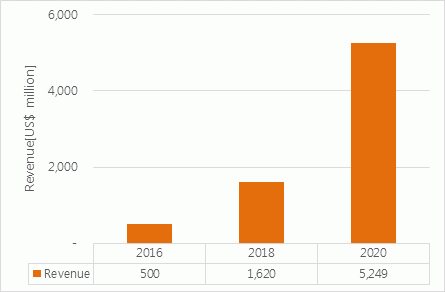
Large Area AMOLED Market Forecast
At the press event of CES 2016 (January 6-9), CEA revealed that this year’s CES trends are as follows:

Ambient sensing includes products with motion/touch sensors, calorie analyzing sensor, and products that automatically adjust water volume after checking the weight of the laundry. Aggregated learning’s representative technology and products are driverless vehicles. Lastly, the maturing of nascent ecosystems includes VR (virtual reality), UHD, wearable device with health and fitness function, drone, 3D printer, and smart home.
Compared to last year’s trends, what has been most changed was the part where the automotive related technology was introduced as adaptive customization within permeation of logic in CES 2015.

However, this year the aggregated learning was changed to autonomous vehicle (i.e. driverless car) and demonstrated CES’ high expectations for future automotive industry.

CES2016이 개막되기 전 4일부터 미리 개막되는 프레스 행사에서 CEA는 올해의 CES 트렌드는 1)ambient sensing, 2)aggregated learning, 3)a maturing of nascent ecosystem이라고 밝혔다.
Ambient sensing에는 모션 센서와 터치 센서가 내장되는 제품들과 칼로리를 분석하는 센서, 빨래양을 무게로 확인하고 물을 양을 자동으로 조정하는 제품들이 여기에 속한다. Aggregated learning에는 대표적인 기술과 제품이 무인 운전자동차이다. 마지막으로 A maturing of nascent ecosystems에는 VR(virtual reality), UHD, health와 fitness 기능들이 들어있는 wearable 기기, drone, 3D printer, smart home이 속한다.
CES2015의 트렌드와 비교해서 가장 달라진 부분은 작년 자동차 관련 기술 부분이 permeation of logic 내의 adaptive customization이라고 소개 되었다.

하지만 금년에는 aggregated leaning에서 autonomous vehicle(ie driverless cars)로 소개 되며 CES에서는 향후 자동차 산업 전망을 높게 보고 있음을 나타내었다.

UBI Research (president: Choong Hoon Yi), an OLED specializing company, announced that they will host the 2nd OLED KOREA Conference (February 24-25, 2016) at The K Hotel in Seoul, South Korea. Following the hugely successful 1st OLED KOREA Conference in April this year, the 2nd OLED KOREA Conference is expected to be an opportunity to discuss even wider range of issues from diverse perspectives.
OLED is continually widening its application scope and usage through TV, automotive, lighting, smartphone industries among others. This event is organized to review each sector’s response strategy and current limitations, and find solutions through in-depth discussion.
President of UBI Research, Choong Hoon Yi stated that “UBI Research is holding an event in Korea, a leading country in display industry, to highlight global future industries, including display sector, that can be developed and evolved and discuss current issues”.
OLED KOREA Conference is one of the largest conferences in OLED industry where the attendees can discuss issues on key technology development, investment, and market in one place. Its focus is on the exchange of information and thoughts to respond to rapidly changing OLED industry through the OLED experts’ in-depth understanding of the market and technology.
Accordingly, for the key conference speakers, UBI Research is actively inviting world renowned experts in OLED related industry including Korean and Chinese panel, manufacturing equipment, materials, and lighting companies, and leaders in academia and industry. Following the 1st OLED KOREA Conference which had approximately 130 attendees, over 200 key players in the OLED industry are anticipated to attend the 2nd event.
UBI Research is also hosting a separate VIP dinner event during the conference period. The dinner is expected to be a great networking opportunity where OLED industry, academia, and research board members and experts can freely discuss OLED industry. Inquiries can be made through UBI Research website.
The conference registration is available through the 2nd OLED KOREA Conference homepage (www.oledkoreaconference.com).
In 2016, flexible AMOLED mass production line investment is expected to be actively carried out by Samsung Display, LG Display, BOE, and Japan Display. For Samsung Display to apply flexible AMOLED panel to the new Galaxy model, the mass production line investment is necessary. If they supply flexible AMOLED panel to Apple, volume of the flexible AMOLED mass production to be invested in 2016 is estimated to be grow significantly. LG Display also is expected to actively carry out flexible AMOLED line manufacturing equipment order for Gumi’s P6 line, as well as additional flexible AMOLED mass production line investment following Apple’s demand. BOE is estimated to seriously begin orders for Chengdu’s Gen6 45K flexible AMOLED mass production line.
With the announcement of new factory establishment and 1.84 billion KRW investment for part of facilities in Q4 2015, as the first step of the investment, LG Display began site construction for P10 line factory that can produce large area panel. However, the investment direction has not yet been decided. P10 could be directed to only producing large area LCD panel, large area OLED panel, small-to-medium size OLED panel, or large area and small-to-medium size OLED panel simultaneously. China’s Gen8 LCD facilities investment is quite advanced and BOE’s Gen10.5 LCD line investment has also been confirmed. As such how much LG Display’s large area LCD can bring profit has to be carefully considered. Additionally, with the increase of OLED TV consumption and the supply of OLED panel to Apple practically confirmed, OLED investment is essential. P10, Gen11 line, is the world’s largest factory site, and depending on the investment direction in 2016, it is estimated to affect OLED market’s opening time.
Everdisplay is supplying AMOLED panel to some several Chinese set companies, and Visionox is also expected to actively supply AMOLED panel from 2016. As such, most of Chinese OLED panel companies’ OLED mass production preparation is anticipated to conclude in 2016. Accordingly, second investment by companies including Everdisplay, Visionox, and Tianma is analyzed to be possible and serious movement by China’s OLED industry could occur.
Flexible AMOLED mass production line investment by Samsung Display, LG Display, Japan Display, and BOE, and other Chinese OLED panel companies’ additional installation are expected to be actively carried out from 2016. Amidst this, order of evaporation equipment, OLED production’s essential component, is expected to be an issue.
Evaporation equipment currently being used in mass production is mostly Japanese Canon Tokki’s. As this evaporation equipment has been verified in mass production, it is estimated that most companies, including Samsung Display, LG Display, BOE, and JDI, will want to order Canon Tokki’s evaporation equipment. However, as the production capa. of Canon Tokki’s evaporation equipment is limited, the issue is expected to be which panel company will be able to order early. At the same time, this could be a new opportunity for Korean evaporation equipment companies.
At present, the TV industry trend is moving to OLED from LCD. Accordingly, Samsung Display is continuing research to resume their large area OLED for TV panel business. It is analyzed that Samsung Display possesses RGB OLED technology that uses SMS evaporation method, white OLED, and solution process OLED technology. However, as each technology has its drawbacks, they are carefully considering future directions. First, RGB OLED technology is estimated to lack Gen8 mother glass substrate evaporation equipment at present. Solution process OLED method has low material performance. For white OLED, as the key patents are owned by LG Display, technology that avoids these has to be first developed. Therefore, much attention is focused on which technology Samsung Display will use and invest in production line to enter the TV market.
유비산업리서치에서 발간한 2016 투명 OLED 보고서에 따르면 대면적 투명 AMOLED 시장은 2020년까지 약US$ 5,300 million의 규모로 성장할 것으로 내다봤다.
유비산업리서치는 “ 투명 OLED는 투과도가 높아 뒷면의 사물을 제대로 표현해야만하는 showcase와 같은 광고용 투명 display에 적용될 가능성이 높으며, 또한 시야각이 넓고 색 구현력과 시인성이 높아 automotive등 transportation용 display로도 널리 사용될 것”이라 밝혔다. 또한 flexible 구현이 용이하여 앞으로 새롭게 등장할 다양한 application에도 적용이 가능하여 시장 잠재력이 매우 높다고 밝혔다.
투명 display는 투명전자소자를 이용하여 시각적으로 투명한 형태의 display를 통해 정보 인식/정보처리/정보전달의 기능을 가진 display로 평상시에는 유리처럼 투명한 상태로 있다가 필요에 따라서, 모니터, TV처럼 활용이 가능한 장치이다. 정보가 표시되는 영역이 투명하여 display의 뒤에 위치한 사물이 보이기 때문에 공간적/시각적인 제약을 없앨 수 있어 다양한 application에 적용 가능하여 기존 display의 시장을 확대할 수 있을 것으로 기대되고 있다. 특히 투명 OLED는 투과도가 투명 LCD대비 약 2배 가량 높고(최근 공개된 panel 기준) flexible이 용이하다. 따라서 주요 panel업체에서도 투명 OLED를 적극적으로 개발하고 있는 추세이다.
Samsung Display는2015년 45% 투과율의 55inch FHD 투명 OLED를 세계 최초로 공개하였으며 2016년부터 양산할 것이라 밝힌바 있으며, LG Display도 2012년부터 시작 된 ”60inch 이상 UD급 투과도 40%이상인 투명 플렉시블 display”에서 투명 OLED를 개발 중에 있다. 중국의 BOE도 SID 2015에서 30% 투과율의 9.55inch 투명 플렉시블 OLED panel을 공개하는 등 적극적으로 개발을 하고 있다.
이러한 panel업체들의 투명 OLED 개발에 힘입어 투명 OLED가 앞으로의 display의 시장 확대에 큰 역할을 할 것으로 기대된다.

대면적 투명 AMOLED 시장 전망
유기발광다이오드(OLED)의 현재와 미래를 다양한 업종으로부터의 시각을 통해 조명해 볼 수 있는 세계 최대의 OLED International Business Conference가 열린다.
‘OLED 전문 기업’ 유비산업리서치(대표 이충훈)는 2016년 2월 24일~ 25일 양일간에 걸쳐 서울 강남구 양재동에 소재한 The K Hotel에서 ‘제2회 OLED KOREA Conference‘를 개최한다고 밝혔다. 2015년 4월에 성황리에 치뤄진 1회 OLED KOREA Conference에 이어 2016년 개최되는 제2회 OLED KOREA Conference는 보다 넓은 범위와 다양한 시각을 논의할 수 있는 행사가 될 예정이다.
이번 행사는 OLED가 TV와 자동차, 조명, 스마트폰 등으로 활용 범위와 쓰임새를 갈수록 넓혀가고 있는 가운데, 각 업체들의 대응 전략과 현재의 한계점을 검토해 보고 대응방안을 논의해 해결책을 찾기 위해 마련됐다.
유비산업리서치 이충훈 대표는 디스플레이 산업을 이끄는 대한민국에서 디스플레이 뿐만 아니라, “OLED” 라는 차세대 기술을 적용하여 개발과 발전이 가능한 전세계의 미래 산업을 조망하고, 현재의 이슈에 대하여 참석자들과 함께 대화를 나눌 수 있는 자리를 마련했다고 밝혔다.
OLED KOREA Conference는 OLED 산업에서 가장 큰 Conference로서 핵심 기술개발과 투자, 시장에 대한 이슈를 한자리에서 토론하고 또한, OLED 산업 종사자 분들의 시장과 기술에 대한 폭넓은 이해를 통해 급변하고 있는 OLED 산업에 대응할 수 있는 정보의 전달과 의견의 교환에 중점을 두고 있다.
이에, 유비산업리서치에서는 주요 연사들로 한국과 중국의 패널과 장비, 재료, 조명 업체를 포함하는 전세계 OLED 산업 관련 최고의 권위를 가지고 있는 전문가들과 이를 연구하는 학계와 산업 리더들을 적극적으로 초빙하고 있다. 약 130여명의 참여로 이루어진 1회에 이어 제2회 Conference에서는 200명 이상의 주요 OLED 산업 종사자들이 참여할 것으로 기대하고 있다.
유비산업리서치는 본 컨퍼런스 기간중에 별도의 VIP 석식 행사를 통해 OLED 산업계와 학계, 연구소 임원진들과 전문가가 한자리에 모여 OLED 산업에 대해 허심탄회하게 대화를 나눌 수 있는 네트워크 장을 마련할 예정으로 관련문의는 유비산업리서치 홈페이지를 통해 가능하다.
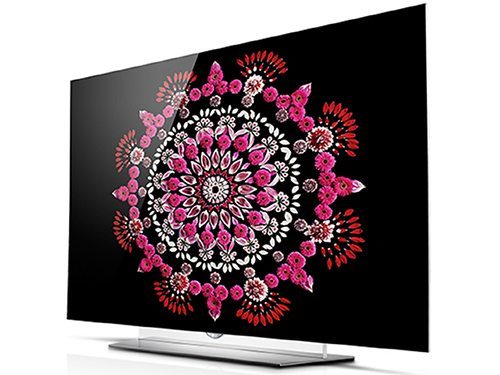
LG OLED TV, source: LG전자
LG전자가 차세대 방송 기술 기반의 HDR(High Dynamic Range, 이하 HDR) 방송을 시연한다.
LG전자는 6일 미국 라스베이거스에서 열리는 세계 최대 가전전시회 ‘CES 2016’에서 LG 올레드 TV로 차세대 방송 표준규격인 ATSC 3.0(Advanced Television System Committee 3.0) 기반의 HDR 방송을 실시간으로 송수신하는 기술을 선보인다.
LG전자는 북미 LG 제니스 연구소, 방송장비업체 ‘게이츠에어(GatesAir)’와 공동으로 라스베이거스 지역 방송사의 송신탑에서 송출된 HDR 방송을 LG 올레드 TV로 수신한다.
한국과 미국에서 울트라HD 방송 표준으로 ATSC 3.0이 유력하게 거론되고 있는 만큼, LG전자는 이번 HDR 방송 시연을 통해 차세대 방송 기술에서도 우위를 선점한다는 계획이다.
LG전자는 이번 전시회에서 차세대 방송 표준 규격과 관련해 한 발 앞선 기술력을 선보인다. 이번 시연에서 소개하는 루트(ROUTE, Real-time Object delivery over Unidirectional Transport)는 LG전자가 주도해 개발한 인터넷 IP기반의 방송 전송 기술로 ATSC 3.0의 핵심 표준기술이다. 루트 기술은 실시간 방송은 물론 방송안내정보(ESG: Electronic Service Guide) 등 부가 서비스 정보도 전달할 수 있다.
ATSC 3.0은 주파수를 효율적으로 운영할 수 있기 때문에 영상 정보 외에 부가 정보들을 더 많이 전송할 수 있다. 영상 정보와 부가 정보가 서로 다른 규격으로 지상파와 인터넷망을 통해 각각 송출되던 기존 방식과는 달리, ATSC 3.0은 모든 방송 정보를 인터넷 IP 기반으로 주고 받기 때문에 방송과 인터넷을 융합한 서비스에도 적합하다. 예를 들어 기존에는 방송 신호가 약한 곳에서는 스마트폰으로 DMB 방송을 볼 수 없었지만, ATSC 3.0 기술을 이용하면 방송 신호가 약한 곳에서는 무선 인터넷망으로 전환되기 때문에 끊김 없이 자연스러운 영상을 즐기는 게 가능하다.
HDR는 어두운 부분을 더욱 어둡게, 밝은 부분을 더욱 밝게 보여주기 때문에 한층 또렷하고 생생한 화면을 구현하는 기술이다.
LG 올레드 TV는 백라이트가 없어 완벽한 블랙을 구현하기 때문에 규격과 장르를 불문하고 어떠한 영상에서도 HDR 효과를 극대화해 표현할 수 있다.
HDR 기술이 울트라HD 방송에서 구현되면, 시청자들은 초고해상도로 한층 생동감 넘치는 화면을 즐길 수 있다. 이 때문에 전 세계 방송 관련 기업들은 차세대 울트라HD 방송 표준에 HDR를 적용하는 기술을 적극적으로 연구하고 있다.
LG전자 최고기술책임자(CTO) 안승권 사장은 “차세대 방송기술을 선도해 시청자들에게 차원이 다른 화질을 선사할 것”이라고 강조했다.
출처:LG전자
2016년에는 Samsung Display와 LG Display, BOE, Japan Display의 flexible AMOLED 양산라인에 대한 투자가 본격적으로 이루어 질 것으로 예상된다. Samsung Display는 신규 Galaxy모델에 flexible AMOLED panel을 적용하기 위해서는 양산라인 투자가 필수적이며, Apple에 flexible AMOLED panel을 공급하게 될 경우 2016년에 투자될 flexible AMOLED 양산라인의 규모는 상당히 커질 것으로 예상된다. LG Display도 구미 P6 line에 flexible AMOLED line 장비 발주가 본격적으로 이루어 질 것으로 예상되며, 이외에 Apple의 요구에 따라 추가적인 flexible AMOLED 양산라인 투자가 있을 것으로 전망된다. Japan Display도 Apple의 flexible AMOLED 공급업체 후보로 투자가 가능할 것으로 예상된다. BOE는 청두의 Gen6 45K flexible AMOLED 양산라인에 대한 발주가 본격적으로 시작될 것으로 전망된다.
LG Display가 2015년 4분기에 신규공장 건설과 일부 설비투자에 1조8400억원을 투입한다고 밝히며, 투자의 첫 단계로 대형 패널을 생산할 수 있는 P10 line의 공장 부지 조성을 시작했다. 하지만 아직 투자 방향을 결정하지 않은 상태이다. P10의 투자 방향은 대형 LCD 패널만 생산하거나 대형 OLED 패널을 생산하는 방향, 중소형 OLED 패널만 생산하는 방향, 대형과 중소형 OLED를 동시에 생산하는 방향이 있다. 중국의 8세대 LCD 설비 투자도 상당히 진행되고 있고, BOE의 10.5세대 LCD line도 투자가 결정되어 LG Display의 대형 LCD가 얼마나 수익을 거둘 수 있을지 고심해야한다. 또한 OLED TV의 소비가 늘어나고, Apple에 OLED 패널을 공급하는 것이 거의 기정 사실화 된 상황에서 공급량을 충족시키기 위해서 OLED 투자도 필수적이다. P10은 11세대 line 크기 공장 부지의 세계 최대 규모로 2016년에 있을 P10의 투자 방향 결정에 따라 OLED 시장의 개화 시기에 영향이 있을 것으로 예상된다.
Everdisplay는 AMOLED panel을 중국의 일부 set업체에 공급하고 있으며, Visionox도 2016년부터 AMOLED panel을 본격적으로 공급할 것으로 예상되어, 대부분의 중국 OLED panel업체들의 OLED 양산 준비가 2016년에는 마무리 될 것으로 기대된다. 이에 따라 Everdisplay와 Visionox, Tianma등의 2차 투자도 가능할 것으로 예상되어 중국의 OLED 산업도 본격적인 움직임을 보일 것으로 예상된다.
Samsung Display와 LG Display, Japan Display, BOE의 flexible AMOLED 양산 라인 투자와 다른 중국 OLED panel 업체의 추가 증설이 2016년부터 본격적으로 진행될 것으로 예상되는 가운데 OLED 생산의 핵심 장비인 증착장비 발주가 이슈가 될 것으로 전망된다.
현재 양산에 적용중인 증착기는 대부분 일본의 Canon Tokki사의 증착기로 이미 양산라인에서 검증이 되어있기 때문에 Samsung Display와 LG Display, BOE, JDI등 대부분의 업체들에서 Canon Tokki사의 증착기 발주를 원할 것으로 예상된다. 하지만 Canon Tokki사의 증착기 제작 capa는 한정되어 있기 때문에 어떤 panel 업체에서 먼저 선점을 할 지가 이슈가 될 것으로 예상된다. 이와 동시에 국내 증착장비 업체들의 새로운 기회가 될 수 있을 것으로 전망된다.
현재 TV 산업의 트렌드는 LCD에서 OLED로 이동하고 있다. 이에 따라 삼성디스플레이는 TV용 대형 OLED 패널 사업을 재개하기 위한 연구를 지속하고 있다. 삼성디스플레이는 SMS 증착 방식을 사용하는 RGB OLED 기술과 white OLED, solution process OLED 기술을 모두 보유하고 있는 것으로 분석되지만 각 기술 마다 단점이 존재하기 때문에 어떤 방향으로 가야 할지 고심하고 있다. 먼저, RGB OLED 기술은 아직 Gen8 원장 기판에 증착하기 위한 장비가 아직 확보되지 않은 것으로 분석된다. Solution process OLED 방식은 재료 성능이 낮다는 점이 문제점으로 꼽히고 있다. White OLED 방식은 핵심 특허들을 LG디스플레이가 보유하고 있기 때문에 이를 회피하는 기술 개발이 선행되어야 한다. 이에 따라 삼성디스플레이가 어떤 기술을 적용해 생산 라인에 투자하고 TV 시장에 진입할 것인지 관심이 집중되고 있다.
OLED TV, first released in Q4 2013, recorded approximately 50,000 units of shipment each in Q1 and 2 this year. The shipment increased to 100,000 units in Q3, more than twice the amount of each quarter in H1 2015. As it is estimated that close to 200,000 units were released in Q4, over 90% of LG Display’s 2015 target is expected to be achieved. This is considered to be showing price competitiveness against other TV as the price of OLED TV fell to 1/2 of the initial price and effectiveness of aggressive marketing emphasizing the advantages of OLED TV compared to newly released LCD TV. In Q3 earnings results announcement, LG Display revealed their plan of 1,000,000 units of OLED TV panel shipment in 2016 and forecast OLED TV’s growth. For the industry, 2015 has been the year that secured foothold for OLED TV’s market expansion.
At the time of Galaxy S6 and Galaxy S6 Edge’s release, Samsung Electronics estimated the initial supply to be 50:50. However, Galaxy S6 Edge showed 70% in actual demand and this led to shortage in supply. Samsung Display met the demand by starting flexible AMOLED line operation earlier than scheduled. 2015 proved future market growth potential by opening consumers’ wallets through designs possible only with flexible AMOLED panel.
During the Q3 earnings announcement, Samsung Display revealed their plan to expand non-Samsung clients by 30%. Accordingly, in Q3, when smartphone market’s growth was expected to slow down, the sales performance improved by 13% compared to its previous quarter through key client’s new product release and expansion of client base. Particularly, the market occupation of AMOLED panel shipped toward China is analyzed to have increased within the global mobile market as Chinese set companies released AMOLED panel equipped smartphones.
Apple, which has been using LCD panel for all products, first applied flexible AMOLED panel, produced by LG Display, to 2015 smartwatch Apple Watch and drew much attention. In H2, Apple diversified suppliers by using Samsung Display’s flexible AMOLED panel. This move is analyzed to be groundwork for flexible OLED application to smartphone following smartwatch. 2015 has been a year with much interest in when flexible AMOLED panel equipped iPhone will be released.
Global OLED lighting industry went through a great transformation in 2015. OLEDWorks announced they will acquire key parts of Philips’ OLED lighting business, relevant production facilities, and intellectual property. With this take over, OLEDWorks greatly expanded business through widened product portfolio and simultaneous lighting panel mass production in the US and Germany. LG Chem. transferred OLED lighting business to LG Display. The value of transfer is 1.6 billion KRW, and it is seen to be a strategy to increase competiveness by transferring the business to LG Display with their OLED panel mass production knowledge and to focus on existing materials business. The take over and business transfer of the main players in OLED lighting industry, OLEDWorks and LG Chem., are following their own business strategy. However, following these moves, related investment is expected to be delayed for some time and eyes are on how these will affect the OLED lighting business overall.
2013년 4분기부터 출시된 OLED TV는 2015년 1, 2분기에 각 약 5만대가 출하되었고 3분기에 10만대가 출하되면서, 3분기에만 상반기 각 분기별 출하량의 약 두 배 이상을 출하했다. 또한 4분기에도 20만대 가까이 출하한 것으로 예상되어 LG Display의 2015년 목표의 약 90%이상이 달성될 것으로 예상된다. 이는 OLED TV의 가격이 초기 가격의 절반 가량으로 하락하면서 다른 TV와의 가격 경쟁력이 생겼고, 새롭게 출시되는 LCD TV보다 OLED TV의 장점을 부각시키는 공격적인 마케팅이 시장에서 발휘되고 있다는 신호로 보인다. LG Display는 지난 3분기 실적발표회에서 2016년 OLED TV용 패널 출하량을 100만대로 발표하면서 OLED TV의 성장을 예고했다. 업계 관계자들에게 2015년은 OLED TV의 시장 확대의 발판을 마련한 시기였다.
Samsung Elec.은 Galaxy S6와 Galaxy S6 Edge를 출시할 당시 초기 물량을 5대5로 예상했었다. 하지만 실제 수요량에서 Galaxy S6 Edge가 70%를 차지하면서 공급 부족 현상이 일어났다. 때문에 Samsung Display에서 flexible용 AMOLED line을 예상 시점보다 앞당겨 가동하여 수요량을 충족시킬 수 있었다. 2015년은 flexible AMOLED 패널로만 구현할 수 있는 디자인으로 소비자들의 지갑을 열게 하여 앞으로 시장 성장성을 증명해 준 한 해였다.
Samsung Display는 지난 3분기 실적발표회에서 외부 거래선을 30% 확대할 계획을 밝혔다. 이에 따라 smart phone 시장의 성장 둔화가 예상되었던 3분기에 주요 거래선의 신제품 출시와 공급처 확장을 통해 매출 기준 지난 분기 대비 13% 성장의 실적 개선을 이루었다. 특히 중국향 AMOLED 패널은 중국 set 업체들의 AMOLED 패널을 탑재한 smart phone의 출시가 되면서, 세계 모바일 시장에서 점유율이 늘어난 것으로 분석된다. 2015년의 Samsung Display 공급 다변화는 Samsung Display의 실적을 다시 성장세로 올리면서 AMOLED 패널이 모바일 display 시장 규모를 확대할 수 있었다.
지금까지 모든 제품에 LCD 패널을 적용해왔던 Apple이 2015년에 출시된 smart watch제품인 Apple watch에 LG Display의 flexible AMOLED 패널을 처음으로 적용하여 큰 관심을 모았으며, 하반기에는 Samsung Display의 flexible AMOLED 패널도 공급받음으로써 공급업체 다변화를 이루었다. Smart watch에 이어서 smart phone에도 flexible OLED를 적용하기 위한 포석으로 분석되며, flexible AMOLED 패널이 적용된 iPhone의 출시 시점에 대한 관심이 높았던 한 해였다.
2015년 전세계 OLED 조명 산업은 큰 변화를 겪었다. OLEDWorks는 Philips의 OLED lighting 핵심 사업부와 관련된 생산시설, 지적 재산권을 인수한다고 발표했다. 이번 인수로 제품 포트폴리오를 넓히고 미국과 독일에서 동시에 조명 패널을 양산하는 등 사업규모를 크게 확장했다. 또한 LG Chem.은 OLED 조명 사업을 LG Display에 양도했다. 양도가액은 1,600억원으로 OLED 패널 양산에 대한 노하우가 풍부한 LG Display에 관련 사업을 이관해 경쟁력을 높이고 기존 소재 사업에 더 집중하겠다는 전략으로 분석된다. OLED 조명 산업의 main player인 LG Chem.과 OLEDWorks의 사업 양도와 인수는 각 사업전략에 따른 것이지만 이에 따라 당분간은 관련된 투자가 지연될 것으로 보이며 이런 움직임들이 OLED 조명 산업 전반에 어떤 영향을 줄지 관심이 모아지고 있다.
NeoView Kolon, a subsidiary merged by Kolon Group in order to foster electronics business in 2001, is known within the industry to close down the PMOLED sector on December 31.
NeoView Kolon established factory in Hongseong, South Chungcheong Province of South Korea in 2003 and began PMOLED mass production. At this point, Samsung SMD (the current Samsung Display) and LG Electronics were also mass producing PMOLED. Other PMOLED producing companies included Korea’s Orion, Japan’s Futaba, and Tohoku Pioneer, and China’s Visionox. However, Samsung SMD stopped PMOLED business and sold manufacturing equipment to China’s Truly, and Samsung Display began AMOLED business from 2007. Subsequently, LG Electronics also closed down PMOLED sector and merged OLED related personnel to LG Display and launched AMOLED business. Orion was sold to China’s Changhong.
With the active application of AMOLED to Samsung Electronics’ Galaxy series, global PMOLED business began to rapidly shrink, and in order to maintain business, PMOLED companies pushed ahead with OLED lighting panel business.
NeoView Kolon entered into the automotive instrument panel business with PMOLED transparent display, but this business was also not easy. Furthermore, as the factory location is Hongseong, deep in the countryside, there was high turnover of employees and difficulty in technology development and recruitment. Despite the investment of over 100,000 million KRW, the company showed continued deficit.
NeoView Kolon turned into a financial sinkhole for Kolon Group and worsened the Group’s financial structure, leading to persistent discussion of selling or withdrawal of the business. Recently, Samsung Display is actively pushing forward the transparent AMOLED panel business. As such, transparent display business value for Kolon decreased, and it is estimated that this led to the decision of closing down the business.
